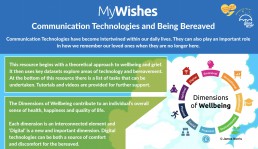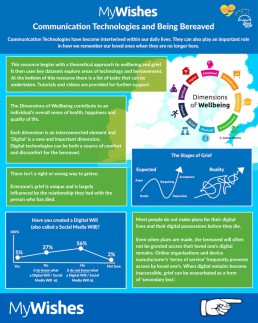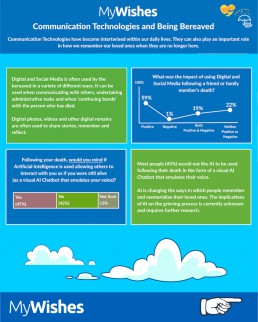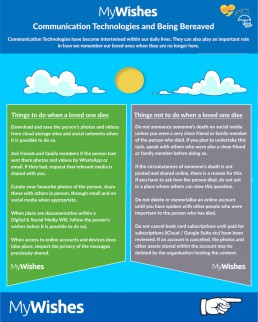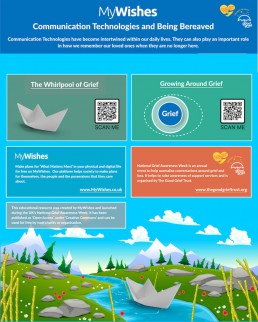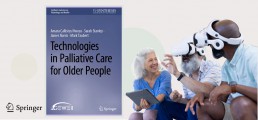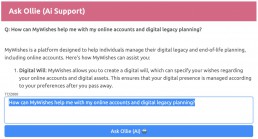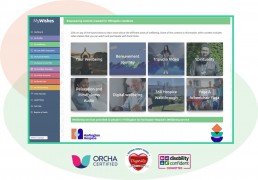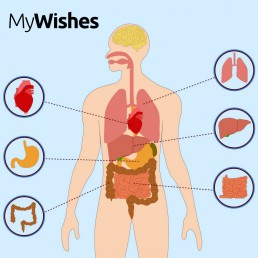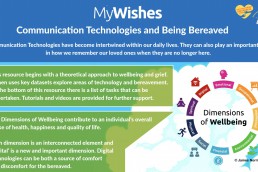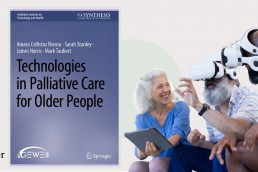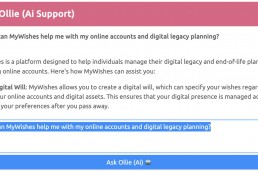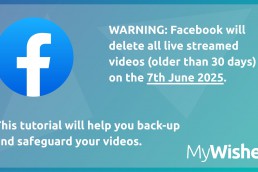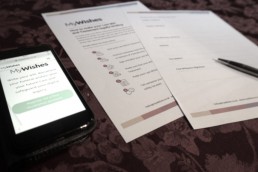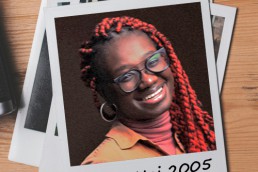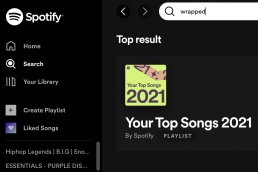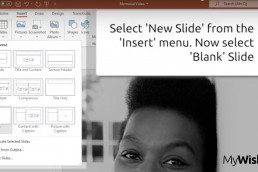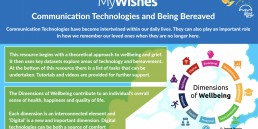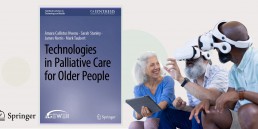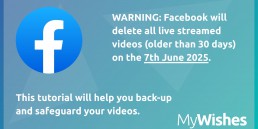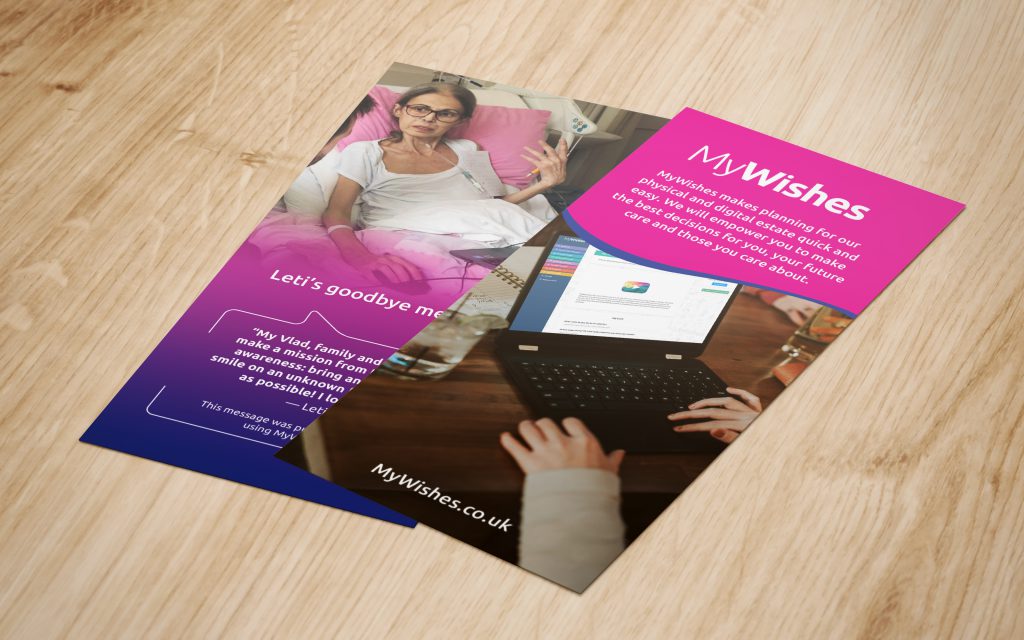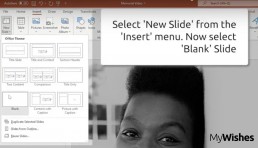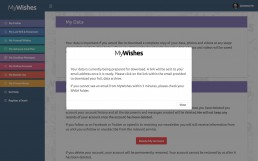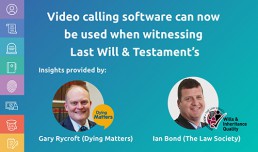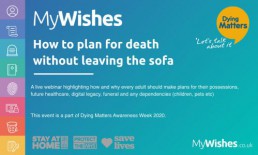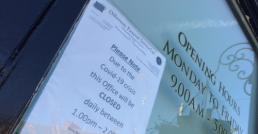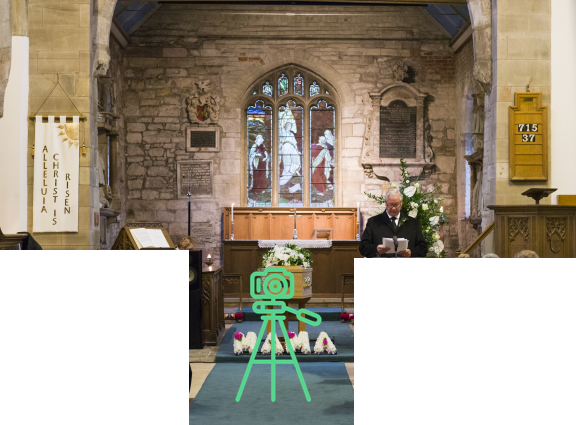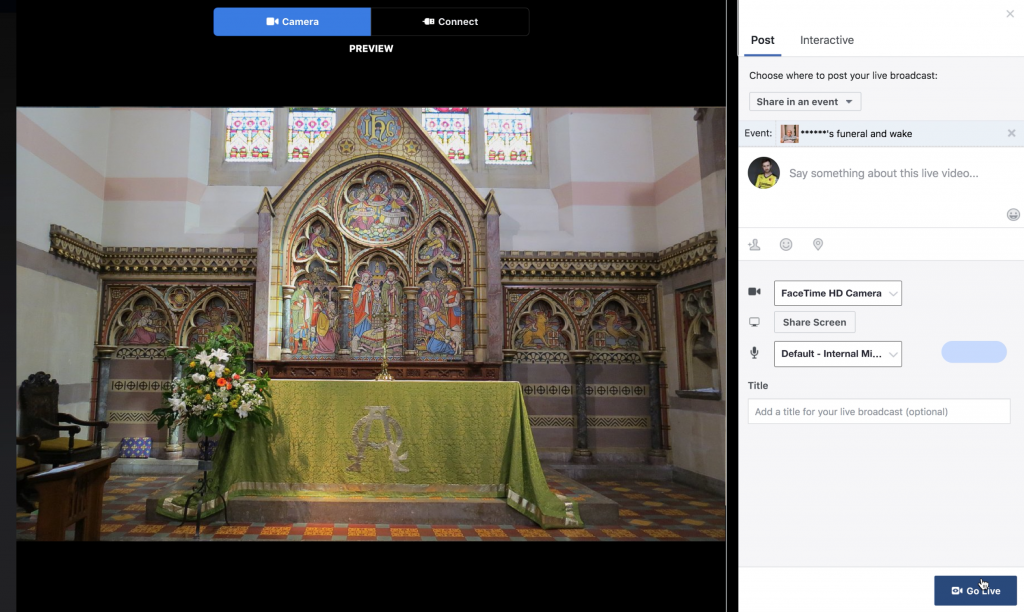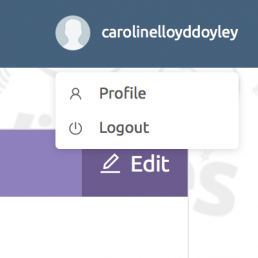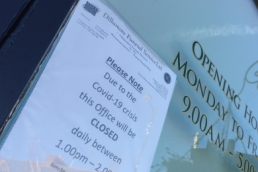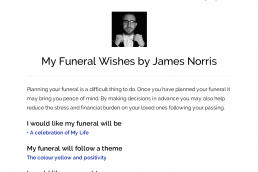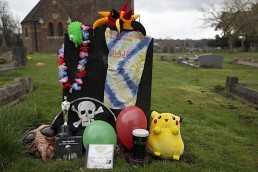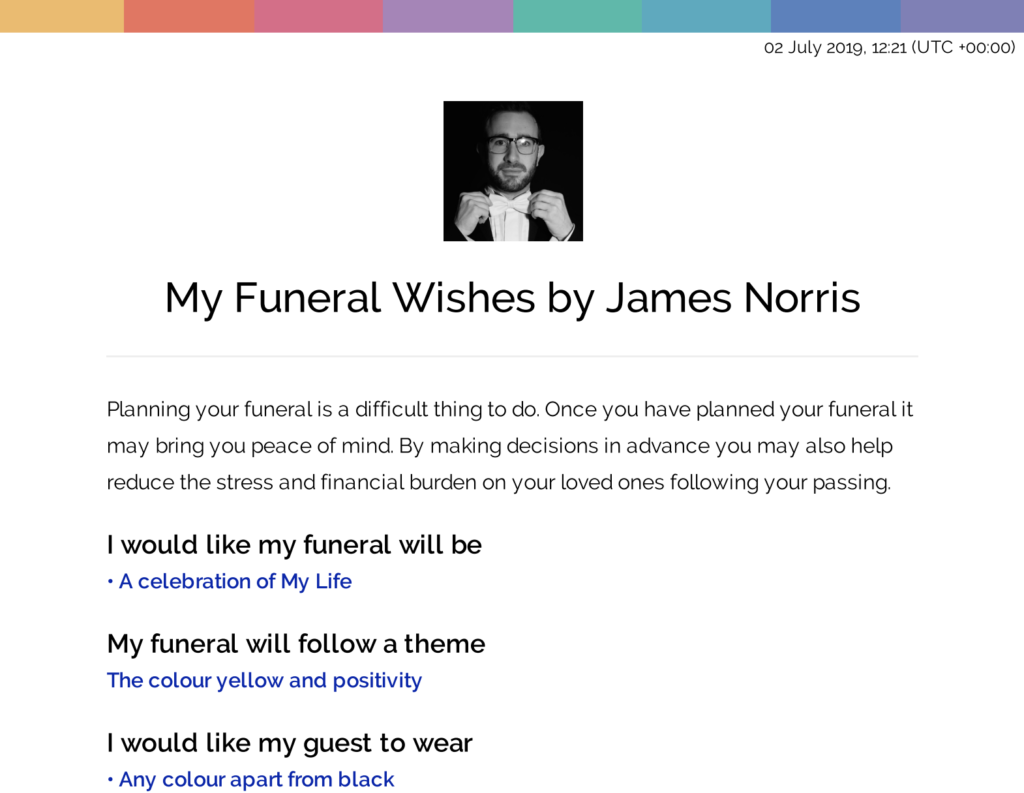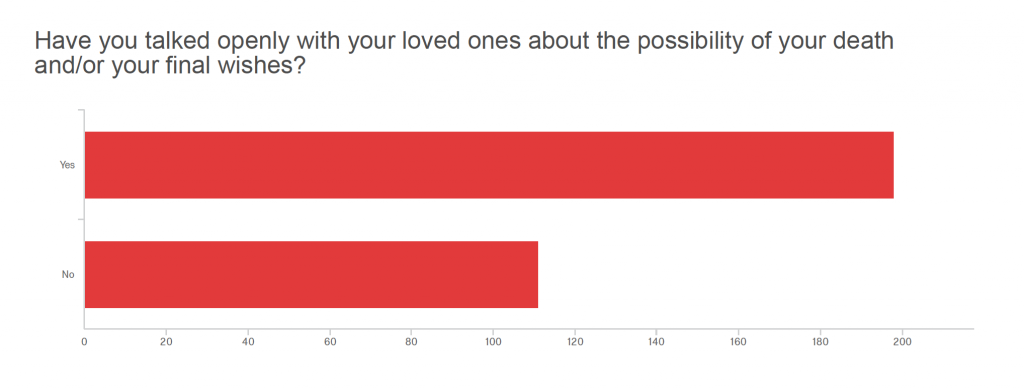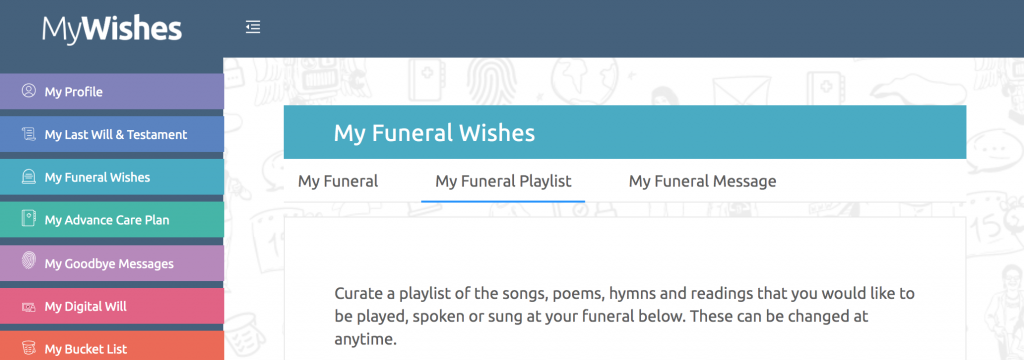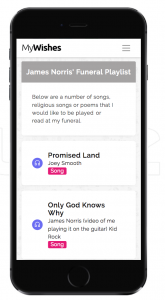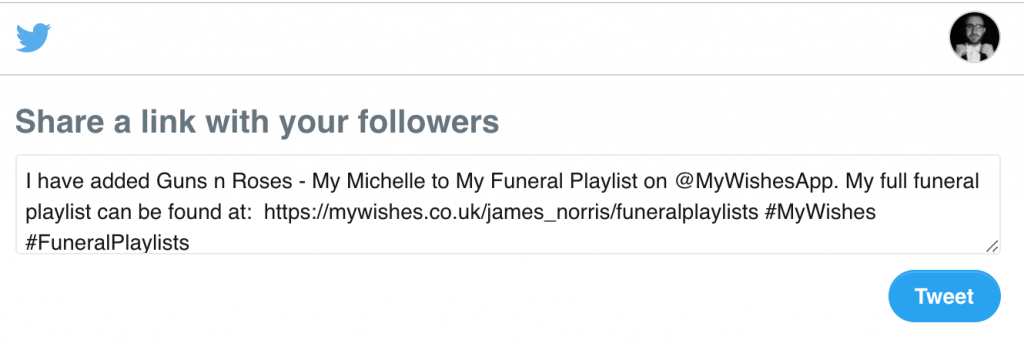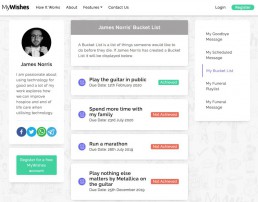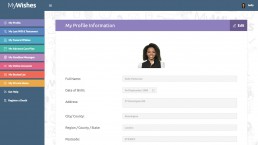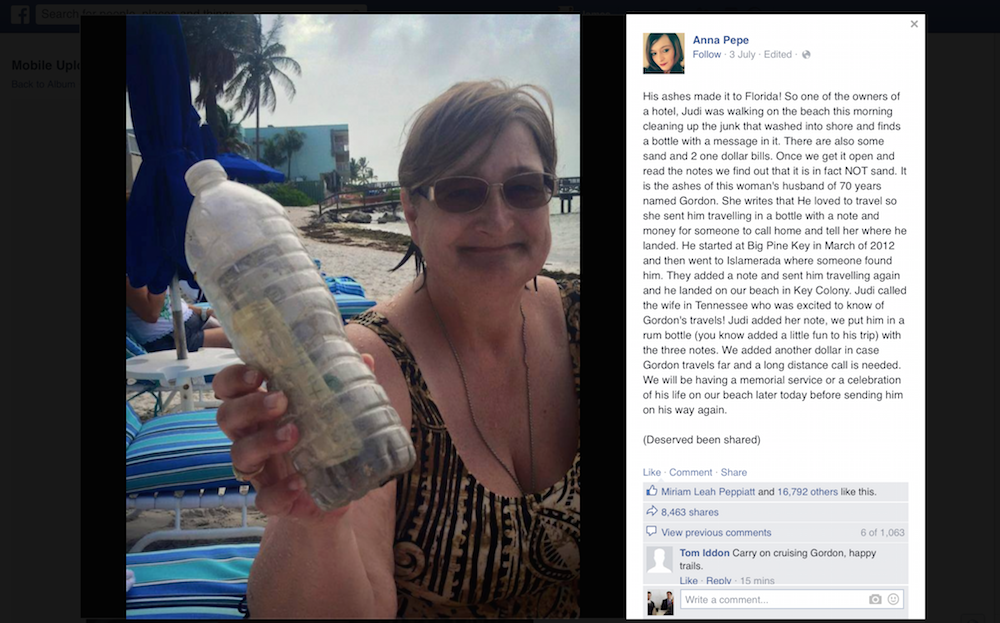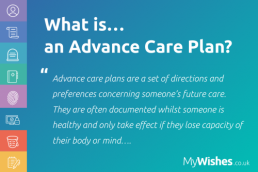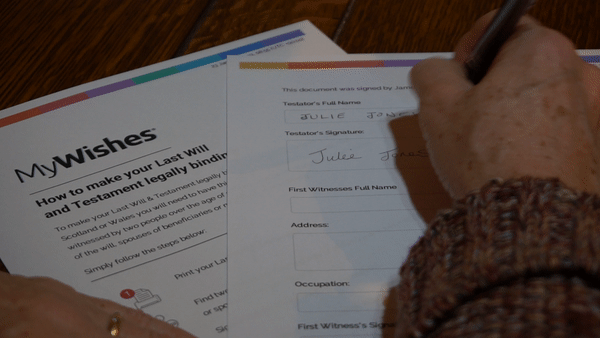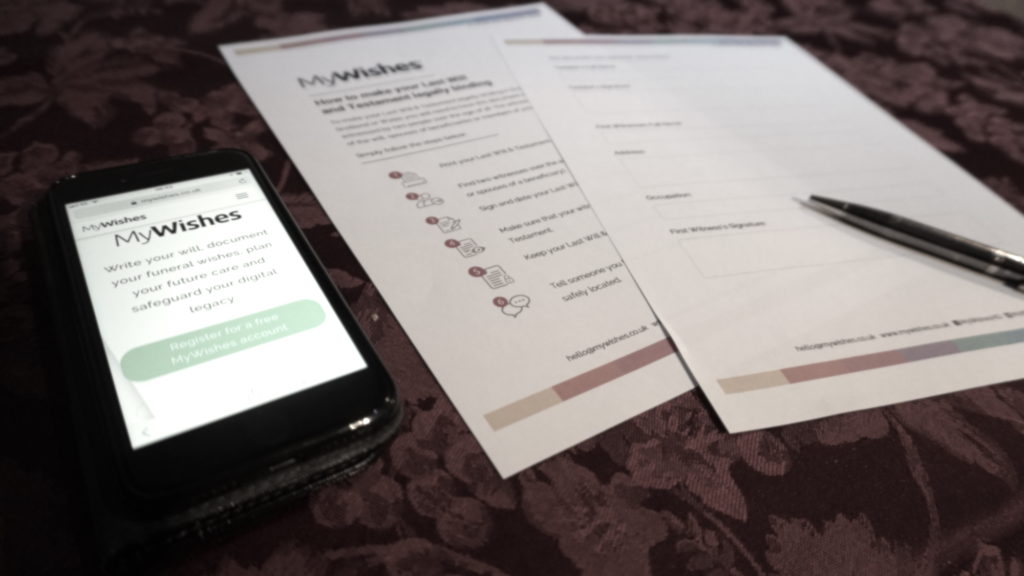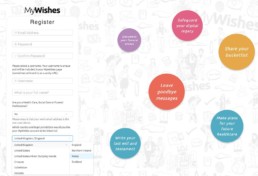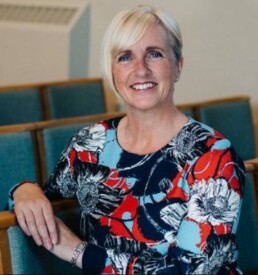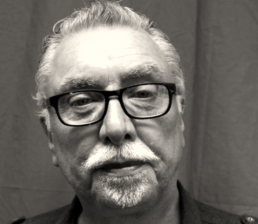Communication Technologies & Being Bereaved Infographic
Free to Use and Share Resource (Infographic)
Overview
Our new infographic ‘Communication Technologies and Being Bereaved’ is free to use, download and share. It is being released ahead of the UK’s National Grief Awareness Week and can be printed and used online and offline both during and after this time.
Why this resource is important
The majority of those who die in the UK have not made any plans for their digital lives. The resource has been developed to help assist the bereaved. It is especially relevant when plans for a loved one’s online life were not shared before they died. It visualises key grief theories and provides a list of ‘things to do’ from a technology perspective after a loved one has died. Datasets are displayed to highlight some of ways in which communication technologies are now being used by the bereaved. At the bottom of the resource, links to technology and bereavement tutorials are provided.
The resource below is not time sensitive and can be utilised when supporting your communities at anytime.
It has been published as ‘Open Access’ / ‘Creative Commons’ for the widest possible reach and impact.
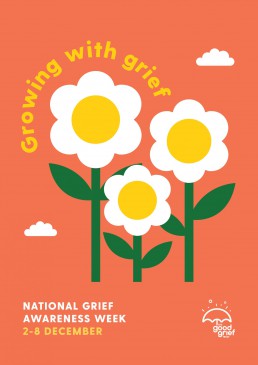
Support using, downloading and embedding this resource
If you need support using or embedding the resource, get in touch with us and we will assist you. If you print the Infographic and display it during The National Grief Awareness Week, please send us a photo or tag us on social media.
We hope that this resource helps you, your patients and their loved ones with their unique, bereavement journeys.
Download the resource (PDF)
If you are planning on printing or emailing this resource to friends, family members or patients we recommend downloading it as a PDF.
Download the resource (JPEG)
If you are planning on sharing this resource on social media we recommend using the JPEG version. JPEGs do not support hyperlinks. We have therefore removed all links to external resources from this version. You might need to ‘right click’ on the Infographic in order to download it locally.
Embed code for website managers
If you would like to add this resource to your own website or blog we recommend using the embed code provided below. This is the easiest way to share this resource with the communities you serve on a website or blog.
To embed this resource / infographic onto your website simply copy the code (shown below) and paste it into your website or blog.
Please see the Step 1 and Step 2 to view and paste the embed code.

Step 1 – Copy the embed code (below)
<div style=”position:relative; width:100%; margin:0 auto;”>
<!– 1) The infographic image –>
<img
src=”https://learn.mywishes.co.uk/wp-content/uploads/2025/11/Communication-Technologies-and-Bereavement-Resource.png”
alt=”Communication Technologies and Being Bereaved infographic”
style=”width:100%; height:auto; display:block;”
>
<!– 2) Clickable overlays (all links preserved) –>
<!– BMJ DOI –>
<a href=”https://spcare.bmj.com/content/14/Suppl_4/A22.1″
target=”_blank” rel=”noopener”
style=”position:absolute; left:4.38%; top:16.91%; width:7.7%; height:0.63%; display:block;”></a>
<!– ResearchGate (wellbeing hub) –>
<a href=”https://www.researchgate.net/publication/386036212_P-32_The_wellbeing_hub_-_reimagining_wellbeing_services”
target=”_blank” rel=”noopener”
style=”position:absolute; left:13.56%; top:16.91%; width:11.45%; height:0.63%; display:block;”></a>
<!– Digital Legacy Association – Source (upper section) –>
<a href=”https://digitallegacyassociation.org/about/reports-2/”
target=”_blank” rel=”noopener”
style=”position:absolute; left:40.91%; top:30.53%; width:5.68%; height:0.63%; display:block;”></a>
<!– Digital Legacy Association – Source (middle left) –>
<a href=”https://digitallegacyassociation.org/about/reports-2/”
target=”_blank” rel=”noopener”
style=”position:absolute; left:54.01%; top:39.49%; width:5.68%; height:0.63%; display:block;”></a>
<!– Digital Legacy Association – Source (middle right, impact chart) –>
<a href=”https://digitallegacyassociation.org/about/reports-2/”
target=”_blank” rel=”noopener”
style=”position:absolute; left:40.44%; top:48.40%; width:5.68%; height:0.63%; display:block;”></a>
<!– eHospice –>
<a href=”https://ehospice.com/editorial_posts/artificial-intelligence-an-overview-by-james-norris/”
target=”_blank” rel=”noopener”
style=”position:absolute; left:75.94%; top:48.40%; width:7.67%; height:0.63%; display:block;”></a>
<!– ResearchGate (AI / digital world poster) –>
<a href=”https://www.researchgate.net/publication/386372105_Dying_in_today’s_digital_world_societal_and_healthcare_perspectives_in_2024_-_Hospice_UK_Poster”
target=”_blank” rel=”noopener”
style=”position:absolute; left:84.57%; top:48.40%; width:11.45%; height:0.63%; display:block;”></a>
<!– “Grief” buttons (two small links under General Bereavement Support Videos) –>
<a href=”https://learn.mywishes.co.uk/grief/”
target=”_blank” rel=”noopener”
style=”position:absolute; left:53.58%; top:52.11%; width:14.98%; height:0.63%; display:block;”></a>
<a href=”https://learn.mywishes.co.uk/grief/”
target=”_blank” rel=”noopener”
style=”position:absolute; left:75.14%; top:52.11%; width:18.20%; height:0.63%; display:block;”></a>
<!– YouTube: Whirlpool of Grief video –>
<a href=”https://www.youtube.com/watch?v=VpNViACSKw4″
target=”_blank” rel=”noopener”
style=”position:absolute; left:57.42%; top:72.92%; width:18.59%; height:0.63%; display:block;”></a>
<!– MyWishes (LearnZone home) –>
<a href=”https://learn.mywishes.co.uk/”
target=”_blank” rel=”noopener”
style=”position:absolute; left:8.15%; top:73.19%; width:19.02%; height:0.63%; display:block;”></a>
<!– How to arrange and video stream a funeral on Facebook –>
<a href=”https://learn.mywishes.co.uk/facebook-funeral/”
target=”_blank” rel=”noopener”
style=”position:absolute; left:10.93%; top:74.43%; width:29.28%; height:0.63%; display:block;”></a>
<!– Same Facebook-funeral link (second line of text) –>
<a href=”https://learn.mywishes.co.uk/facebook-funeral/”
target=”_blank” rel=”noopener”
style=”position:absolute; left:10.93%; top:75.16%; width:16.81%; height:0.63%; display:block;”></a>
<!– Use Spotify / iTunes to decide funeral songs (first line) –>
<a href=”https://learn.mywishes.co.uk/use-spotify-to-decide-funeral-song/”
target=”_blank” rel=”noopener”
style=”position:absolute; left:10.93%; top:76.20%; width:35.72%; height:0.63%; display:block;”></a>
<!– Use Spotify / iTunes (second line) –>
<a href=”https://learn.mywishes.co.uk/use-spotify-to-decide-funeral-song/”
target=”_blank” rel=”noopener”
style=”position:absolute; left:10.93%; top:76.93%; width:31.42%; height:0.63%; display:block;”></a>
<!– MyWishes “Grief” article link under tutorials list –>
<a href=”https://learn.mywishes.co.uk/grief/”
target=”_blank” rel=”noopener”
style=”position:absolute; left:10.73%; top:78.16%; width:28.89%; height:0.63%; display:block;”></a>
<!– YouTube: Growing Around Grief video –>
<a href=”https://www.youtube.com/watch?v=Dohe9zVzw1k”
target=”_blank” rel=”noopener”
style=”position:absolute; left:57.42%; top:78.37%; width:18.24%; height:0.63%; display:block;”></a>
<!– Digital Legacy Association (Tutorials) –>
<a href=”https://digitallegacyassociation.org/for-the-public/”
target=”_blank” rel=”noopener”
style=”position:absolute; left:7.85%; top:80.01%; width:30.21%; height:0.63%; display:block;”></a>
<!– Data from the Digital Legacy Association –>
<a href=”https://digitallegacyassociation.org/about/reports-2/”
target=”_blank” rel=”noopener”
style=”position:absolute; left:7.85%; top:81.07%; width:33.60%; height:0.63%; display:block;”></a>
<!– www.MyWishes.co.uk (bottom left) –>
<a href=”https://www.mywishes.co.uk/”
target=”_blank” rel=”noopener”
style=”position:absolute; left:30.84%; top:89.02%; width:16.37%; height:0.55%; display:block;”></a>
<!– www.thegoodgrieftrust.org (bottom right) –>
<a href=”https://www.thegoodgrieftrust.org/”
target=”_blank” rel=”noopener”
style=”position:absolute; left:75.73%; top:89.02%; width:20.00%; height:0.55%; display:block;”></a>
</div>
Step 2 – Paste embed code
Paste the embed code provided (above) into your website or blog and the resource will appear. An image showing how to paste the embed code on a Wordpress website is shown for further directions. *Click on ‘Text’ before pasting or paste into a a text box. It can also be pasted into ‘Code’ / ‘RAW’ / ‘HMTL’ and other similar modules.
If you need any extra technical support, get in touch and we will assist.

Use and citations within Academia (ResearchGate etc)
If you cite this resource within academia please refer to its listing on ResearchGate
Resource – Social Media Posts versions
The version of the resource below has been edited divided into four images. These can be downloaded individually and shared as a series of posts, in a single post or individually.
Conclusion
We hope that you, your loved ones and anyone under your care finds this resource of high value.
Other tutorials and educational resources that you might find of interest
New Book featuring MyWishes
Technologies in Palliative Care for Older People
Springer Nature will publish a new book titled, Technologies in Palliative Care for Older People, on 22 December 2025. The hardback and eBook publication will feature as part of its acclaimed Synthesis Lectures on Technology and Health and AGEWELL series.
As the global need for palliative care continues to rise alongside an ageing population, Technologies in Palliative Care for Older People explores how Age Tech and digital innovation can enhance quality of life, support clinical decision making, and strengthen compassionate care for older adults both with serious illness and Palliative Care support. AgeTech refers to the use of differing technologies to benefit older adults.
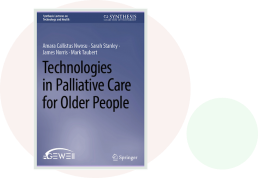
“Technologies in Palliative Care for older people are being developed and utilised for various purposes. These range from providing improved levels of person-centred care to time savings and cost savings” said James Norris, Founder of MyWishes”.
“This book highlights how technology can be used meaningfully to improve care experiences at some of the most vulnerable stages of life. It also explores ethical considerations and problems that can arise whilst using specific technological interventions”.
Bridging the Gap Between Technology and Compassionate Care
The book provides a cross disciplinary overview of technologies shaping palliative care, offering insights for clinicians, researchers, and policymakers seeking to integrate digital tools both responsibly and effectively. It examines practical and ethical questions around digital health use in end-of-life care. Questions asked often revolve around accessibility, equity, cost, interoperability and the preservation of human connection.
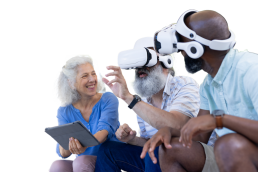
The use of Personas
Each chapter describes the possibilities of how technology can support an older person across different phases of their health trajectory (e.g., diagnosis, supportive care, palliative and end-of-life care).
This is achieved by using ‘personas’ (semi-fictionalised case studies) with practical examples of how existing technological interventions could be used in the real-world to support them.
Dedicated examples are also used to illustrate the potential of Artificial Intelligence (AI) within these contexts. The concluding sections summarise the findings, discuss emerging issues, and identify future directions for research and policy related to palliative care and digital health for older people..
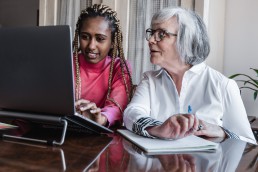
Who is Technologies in Palliative Care for Older People for?
The publication has been written for health practitioners, care professionals, academics, students and those who are interested in technology and aging.
After reading the publication, you will be better equipped to:
- Understand the significance of palliative care needs as people age.
- Appreciate the potential of technology-based products and services to meet those needs.
- Develop understanding of the specific practical, research, and policy challenges in this area.
- Have greater insight into the main directions for future research and innovation.
- Understand areas of good practice when working with people with palliative care needs and technology.

Pre-ordering copies
Hardcover Edition and eBook: The hardcover and eBook editions are available now from:
Paperback Edition: The paperback edition will be available in 2026
About the Authors
The following authors contributed their time and expertise to write the upcoming, Technologies in Palliative Care for Older People publication. Authors shown left to right are:
- James Norris Founder of MyWishes,& The Digital Legacy Association Michael Sobell Hospice, Mount Vernon Hospital, Northwood London, United Kingdom
- Dr Amara Callistus Nwosu. Palliative Care Department, Lancaster Medical School, Lancaster, United Kingdom
- Professor Mark Taubert Palliative Care Department, Velindre Cancer Centre, Cardiff, United Kingdom
Sarah Stanley Liverpool John Moores University, Liverpool, United Kingdom

Other educational news and tutorials
How to use AI to make plans for your Digital Legacy
How to use AI on MyWishes to make plans for your Digital Assets and Digital Legacy
Overview
MyWishes have launched an AI Assistant called ‘Ask Ollie’. It provides real-time support and information to MyWishes users. This takes place whilst someone is making plans for their ‘Online Accounts’ within their ‘Digital and Social Media Will’.
This is the first time that an AI Assistant has been used within a care planning platform to help assist society with their care planning journey.
Making plans for our online accounts before serious illness and death can help reduce the likelihood of precious digital assets such as photos and videos being lost, becoming inaccessible or deleted. Planning can also help safeguard parts of the person’s digital legacy and reduce the heartache often experienced by the bereaved when suitable plans are not put in place.
Why you might ‘Ask Ollie’…
The benefits of Ask Ollie for those documenting their wishes include enhancing their knowledge without needing to leave MyWishes and the documentation process. Information provided can also be highly specialised and tailored to the needs of the person.
Ask Ollie has some other advantages over traditionally published support material. It is constantly learning, updating and therefore it remains up to date with technological developments and policies.
“The use of Artificial Intelligence is becoming increasingly important in our day to day lives. With the rapid advancements within this field, it now seems appropriate to utilise this emerging technology to help benefit our community”.
– James Norris, Founder of MyWishes
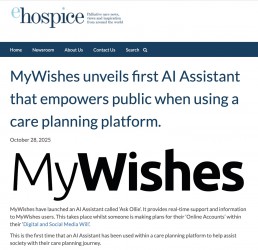
Watch the video

Other Tutorials...
WARNING: Facebook will delete all historic, live-streamed videos on the 7th June
Overview
Facebook will be deleting all live streamed videos saved on their platform older than 30 days on the 7th June 2025. Future live streamed videos will be deleted after 30 days. This short tutorial highlights how you can download and save your videos locally before they are permanently deleted.
This update from Facebook (Meta) should serve as another reminder that social networks are not the guardian of your digital assets and your digital legacy, you are. It is important to backup the photos, videos and other digital assets that are important to you and those that reflect your life, memories and relationships.
– James Norris, MyWishes

How to download your Facebook live streams before they are deleted (tutorial)
Your Facebook Live Streams
Did you live stream a family ‘get-together’ over Christmas, a DJ set during lockdown or a loved one’s funeral on Facebook? If you have streamed anything of importance live on Facebook, this tutorial is for you.
Getting started
Downloading your live streamed videos from Facebook isn’t seamless and requires a bit of attention. The first thing to add is that Facebook does allow you to ‘transfer’ your data to Google Drive or Dropbox. This is the simplest way however for many people it is likely to further segment their videos and will prevent other people from watching them.
If you would like to download your live streams from Facebook locally and then upload them to other social networks, video platforms (and cloud storage platforms like Google Drive and Dropbox) then follow the steps provided below.
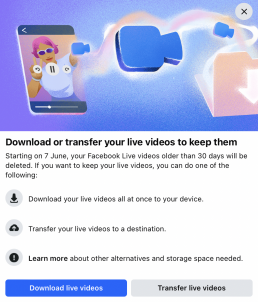
Steps
- Log into Facebook
- Click on this link https://www.facebook.com/was-live-notification/?notif_id=1748782834943965¬if_t=was_live_video_legacy_deletion&ref=notif
- Click on ‘Download your information’ (see image below. Menu item in grey)
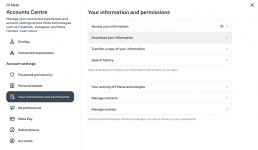
4. You will now need to select (tick) your personal Facebook account if it is not already selected (ticked).
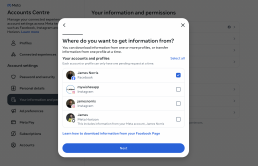
5. You will now need to select ‘Specific types of information‘ (see image below. Menu item in grey).
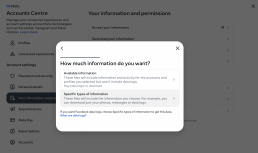
6. Scroll down and select “See all” (see image below. Menu item in grey).
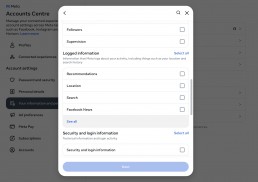
7. Now select ‘Live Videos’ and click on ‘Next’
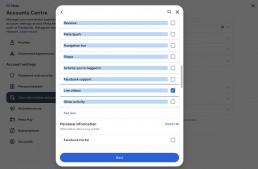
8. Select ‘Download to device’
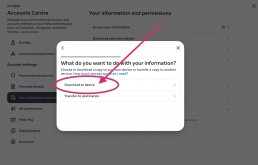
9. The default ‘Date range’ of videos downloaded is ‘Last year’. I recommend changing this to ‘All time’. This will ensure that all of your live streamed videos on Facebook are downloaded.
10. The default Media quality (video quality) Facebook provide the video downloads in is ‘Medium’. I recommend changing this to ‘High’ quality. This will ensure that your videos are not compressed and provided back to you in a higher resolution.
11. Click on ‘Create Files‘. You will need to wait until the files have been created and available to download. This might take some time.
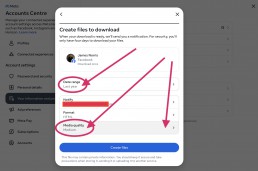
12. Wait until the download button is shown. Whilst you wait you might want to think about your other important photos and videos stored on various social networks and online. You might also want to consider creating a folder of your favourite photos and videos and sharing them with one or more people who you care about.
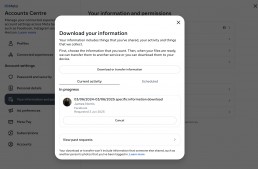
13. The ‘Download’ button will appear. Once it does, click on it.
14. Now click on ‘Allow’ to confirm that you would like your live streamed videos to be saved locally (on the device you are using).
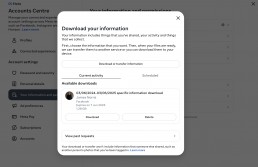
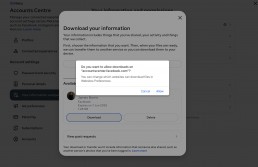
Closing thoughts
We hope that you found this tutorial of value and that you have been able to backup any important live streams that you have recorded over the past few years.
Upon reflection and going forward we recommend
- Only stream videos on Facebook with the understanding that your video will be deleted after 30 days.
- If you are planning to live stream a wedding or funeral consider using an alternative platform (such as Youtube) and sharing the live stream link on Facebook in advance. Once the wedding or funeral has been live streamed (and recorded on Youtube etc) it can be downloaded from the platform and uploaded on to Facebook as a normal video. Videos uploaded to Facebook will not be deleted after 30 days (because it is not deemed as a ‘live stream’). If you do decide to live stream a wedding, funeral or other event on Facebook download it immediately in high quality before it is deleted. We presume that any comments relating to live streamed videos on Facebook will also be deleted with the video after 30 days. If you would like to read our how to arrange and video stream a funeral on Facebook tutorial click here.
- This tutorial highlights how to download your live streamed videos from Facebook. Everyone should also backup and download all of their photos and videos from Facebook.
- All adults should document what they would and would not like to happen to their online accounts and the content they contain within a Digital and Social Media Will. You can create one for free, print it, sign and share it by clicking here
Digital Legacy & Wellbeing
The Wellbeing Hub
The Wellbeing Hub re-imagines and modernises hospice wellbeing content and the way in which it is delivered. The Wellbeing Hub has been developed in a partnership between Harlington Hospice and MyWishes. This project was made possible following a successful grant application to the Masonic Charitable Foundation (managed by Hospice UK).
The poster below was presented at Hospice UK’s annual Conference in Edinburgh. It highlights how MyWishes is taking a digital first approach to wellbeing for people and patients living across Hillingdon, London.
To learn more about the Wellbeing Hub read the BMJ article.

Wellbeing Hub Poster
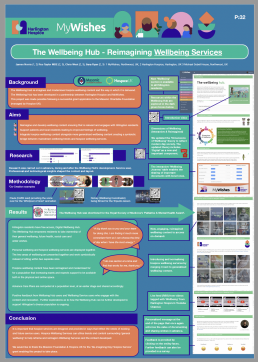
Wellbeing Hub Poster (Research Gate)
The poster can be found on the BMJ and Research Gate. Here is can be downloaded and referenced.
Examples of learning material co-developed between MyWishes and Harlington Hospice.
The following videos were created by MyWishes and Harlington Hospice to empower residents using the Wellbeing Hub.
Other tutorials
Last Will & Testament - Frequently Asked Questions in the UK
What is a Last Will & Testament?
A Last Will and Testament is a legal document that outlines your wishes regarding the distribution of your assets and the care of any dependents that you might have after your death. A dependent might be a child, an elderly parent or a pet.
Do I need a will?
While not legally required, having a will ensures your assets are distributed according to your wishes and can prevent disputes among family members.
Who can make a will?
In the UK, anyone over the age of 18 who is of sound mind (has legal mental capacity) can make a will.
How can I write my own will?
You can do this for free on MyWishes. Other online Will writing platforms normally either charge the user or any charities who the person (sometimes referred to as the testator) might decide to leave money to. MyWishes is a tech for good platform and we do not charge any costs to those writing their will or those receiving money (or gifts) to.
What happens if I die without a will?
If you die without a will (this is sometimes called intestate), your assets will be distributed according to intestacy laws, which may not align with your wishes. Dying without a will is more likely to lead to family and friend disputes and higher legal fees are likely to be incurred from your estate during the administration process.
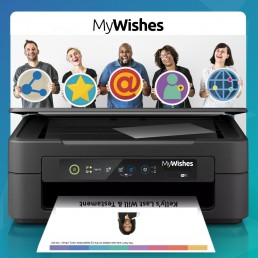
How do I change my will?
You can change your will by creating a new one or adding a codicil (an amendment). It’s important to follow legal formalities to ensure validity. Instructions are provided in Last Will & Testaments created using MyWishes when the document is printed and before it is signed.
Who should I choose as my executor?
An executor is responsible for carrying out the instructions in your will. You can choose a trusted family member, friend, or a professional such as a solicitor. Your executor should be of sound mind (have mental capacity). We recommend that you inform the person chosen to be your executor before you complete your will.
What should I include in my will?
Your will should include details about who will inherit your assets, who will be your executor, and arrangements for any dependents. You may also include charitable donations.
Can I disinherit someone in my will?
In most cases, you can disinherit someone, but they may have legal grounds to contest the will, especially if they are a spouse or dependent.
How do I store my will?
It’s crucial to store your will in a safe place where it can be easily found after your death. You should also share a copy of your will with at least one person who you trust. You might also keep it with your solicitor, a bank, or a will storage service.
How much does it cost to make a will?
The cost of making a will varies depending on whether you use a solicitor or an online platform. Solicitor fees typically range from £150 to £500+. MyWishes is unlike other will writing platforms. Everything we provide is free and we do not receive money (or any financial remuneration) from the charities who receive gifts from those who leave gifts to their loved ones or charitable causes.
How can I make my Will Legally binding?
Once the Will has been signed by you (the testator) and countersigned by two independent witnesses who are not listed as beneficiaries in your will, the document will become legally binding. Those witnessing you singing the document need to be of sound mind (have mental capacity) and be present when you sign the document. You will also need to be present when they countersign your Last Will & Testament.
When should I review my will?
It’s recommended that you review your will regularly, especially after major life events such as marriage, divorce, or the birth of children/grandchildren. If you use MyWishes simply log back in, make the updates before printing and signing the document with two witnesses (same process as outlined in step
The latest signed document will now be the legally binding Last Will & Testament .
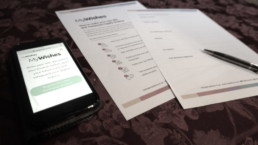
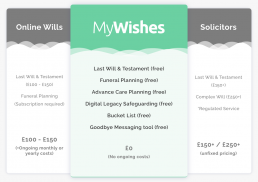
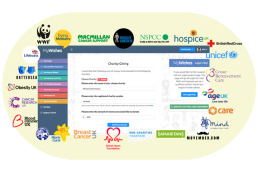


MyWishes free to use software was developed under the guidance of healthcare, hospice, legal and funeral professionals. Our platform empowers society to make plans for both themselves and those they care about.

Michael Sobell Hospice Palliative Care Department Mount Vernon Hospital, Gate 3 Northwood HA6 2RN United Kingdom (Map)
- Register and document your wishes for free here
- For all enquires click here
- To learn how MyWishes works click here
Sharing is caring…
How to plan for death (digitally)https://t.co/mlb8CEFtfk #DMAW2021 #InAGoodPlace
— MyWishes (@MyWishesApp) May 14, 2021
Last Will & Testament Glossary
Why you need a Last Will & Testament
Making a Will is a way of showing that you really care about whoever is left behind and that you have done your best to leave your property and finances in the most thoughtful way possible.
Whether or not you leave a Will is going to have a significant impact on how you are remembered – were you someone who took time and care to ensure your loved ones were provided for after your death, or were someone who just left everything to chance and hoped it would all be alright?
Last Will & Testament glossary
Below is a glossary of the words that are used in the context of writing a last will and testament. We hope that they are clear and are of value
- Administrator: someone who is appointed to arrange a person’s affairs if they leave no will.
- Beneficiary: an individual or organisation who receives a gift in a will.
- Codicil: a document which enables a simple update or alteration to an existing will.
- Chattels and moveables: personal possessions, including furniture and car.
- Estate: all a person’s possessions at the time of their death, including money and property.
- Executor: the person appointed to carry out the instructions in a will.
- Digital Executor: the person appointed to carry out the instructions in a digital will.
- Intestate: you are intestate if you die without making a will.
- Legacy: a gift left to a person or organisation in a will.
- Life interest: a two stage legacy, where the first beneficiary is given the use of an asset (e.g. a house) during their lifetime. After their death the asset passes to the second beneficiary.
- Pecuniary legacy: a gift of a fixed amount of money.
- Probate: the legal procedure to decide whether someone’s left a valid will.
- Residue: the sum left from an estate when all debts, charges and gifts are deducted.
- Residuary legacy: a gift consisting of the residue or part of the residue of an estate. This is a particularly popular way to leave a gift to a charity.
- Specific legacy: a gift of a particular item eg jewellery.
- Testator (male) or testatrix (female): the person who is making the will.
MyWishes free to use software was developed under the guidance of healthcare, hospice, legal and funeral professionals. Our platforms empowers society to make plans for both themselves and those they care about.
Other tutorials that you might find of value

Michael Sobell Hospice Palliative Care Department Mount Vernon Hospital, Gate 3 Northwood HA6 2RN United Kingdom (Map)
- Register and document your wishes for free here
- For all enquires click here
- To learn how MyWishes works click here
Use Spotify to decide which songs should be played at someone's funeral
Overview
Deciding which songs to have played at your own funeral can be difficult (if you haven’t documented your own funeral playlist you might find MyWishes free ‘Funeral Playlist‘ feature of value). It can be even more difficult for the recently bereaved to decide which songs may be suitable for a loved one’s service.
This simple tutorial highlights how you can use Spotify’s ‘Wrapped Playlist’ feature to help decide which songs should be played at a funeral, wake, celebration of life or memorial service.

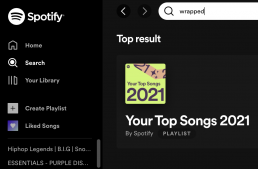
Using Spotify to decide which songs should be played at a funeral
Spotify have released a yearly curation of the most played songs for those who use the platform since 2016. These display the most played songs from the account during that calendar year. The song with the most plays is at the top of the playlist. The song with the second most plays is second, the song with the third most plays is third etc…
To see a wrapped playlist open the Spotify app (mobile/tablet) or web player. The web player website address is: https://open.spotify.com
Sign into Spotify and search for the word ‘wrapped’ in the search box (see image above). This will display the last wrapped playlist. The wrapped playlist might be displayed as ‘Your Top Songs‘.
Click on the ‘Wrapped Playlist’ or ‘Your Top Songs’ result. The playlist will now be shown.
You may want to listen the top 10 songs in the ‘Your Top Songs’ playlist. From this list one or two suitable songs might be chosen to for use at a later date. You might also want to play the entire 100 song playlist in the background at the person’s memorial, celebration of life or wake.

Selected funeral planning tutorials by MyWishes
- How to create a video to be played at a funeral, wake or memorial service using PowerPoint
- How to arrange a funeral
- How to arrange and video stream a funeral on Facebook
- How to create and share your funeral playlist on MyWishes
- How to find someone’s ‘My Funeral Wishes’ document

MyWishes is a free, tech for good platform. It was developed under the guidance of healthcare, hospice, legal and funeral professionals. Our software empowers society to make plans for both themselves and those they care about.
Other tutorials that you might find of value

Michael Sobell Hospice Palliative Care Department Mount Vernon Hospital, Gate 3 Northwood HA6 2RN United Kingdom (Map)
- Register and document your wishes for free here
- For all enquires click here
- To learn how MyWishes works click here
Sharing is caring…
How to use Spotify's 'Wrapped Playlist' feature to help decide which songs should be played at a funeral, wake, celebration of life or memorial service.
Full tutorial: https://t.co/Tww7fUL4lu #TechForGood #lifehack #funeralplaylist #deathpositive #funeral pic.twitter.com/W6JszSF5TJ
— MyWishes (@MyWishesApp) February 23, 2022
How to create a video to be played at a funeral, wake or memorial service using PowerPoint
Memorial Video tutorial
This video tutorial provides a step by step guide showing how to create a memorial video using photos and PowerPoint (no other software is needed). This very simple tutorial will highlight how you can create a video that might be shown at a funeral, wake or memorial service without needing to possess any video editing skills and without the use any video editing software.
Once your video has been created it can be shared with someone at the location where the memorial, funeral or wake is taking place. If no technical support if available, you might want to connect your own laptop the the TV or projector used in the location. If you decide to manage this part yourself, make sure that you have the suitable leads and connections to do this before the day of the memorial, funeral or wake.
Simple steps (Check list taken from the tutorial video)
- Open PowerPoint on your device
- Click on ‘insert’ and add one photo to the slide
- Select a frame (to resize the photo in a specific style)
- ‘Insert’ a new slide
- Repeat steps 2-4 as many times as you like (adding one photo per slide)
- Customise the transition (if you like)
- Save and ‘export’ the video from the ‘File’ menu. Now select ‘Create a video’.
- Add a name to your video file (make sure that the file format is set MP4 / MPEG 4. It probably will be set to MPEG 4 by default)
- Click save to complete and email your new video to the person who will be playing the video at the memorial, wake or funeral service.
*Further instructions, ideas and suggestions can be found in the section below
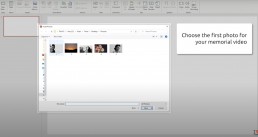

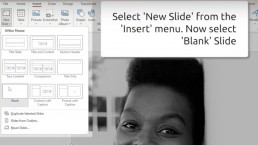
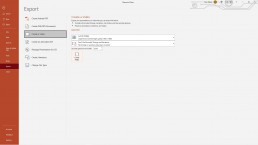
A few final things to think about
- Slides in the video will change every five seconds. The speed be changed if desired.
- If you would like to make any changes to the video simply go back to the saved PowerPoint version (.PPT or .PPTX), edit the slides and refollow the steps above.
- If the video file is going to be played from a device different to the one used to create the video file, test playing the video onto the assigned device before the funeral, wake or memorial service. This will make sure that the file transferred correctly and that it is compatible with the device playing the video.
- If the video file does not work on the assigned computer or laptop you might want to download VLC player onto the device that the video file will play from. VLC is a free media player and can be downloaded from http://www.videolan.org/
- This video demo was made using a Windows PC, the way this appears on a MacBook and other operating systems might appear slightly differently to this video tutorial.
- If you do not own a copy of Microsoft PowerPoint, a similar methodology can be followed to create a video using the software: Google Slides (free web based software) or in Keynote (for Mac users).
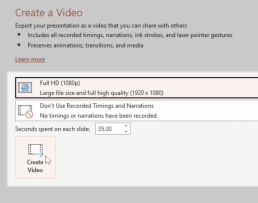
If you liked this tutorial, share it with your friends, family and followers...
MyWishes free to use software was developed under the guidance of healthcare, hospice, legal and funeral professionals. Our platforms empowers society to make plans for both themselves and those they care about.
Selected funeral planning tutorials by MyWishes
- How to arrange a funeral
- How to arrange and video stream a funeral on Facebook
- How to create and share your funeral playlist on MyWishes
- How to find someone’s ‘My Funeral Wishes’ document

Other tutorials that you might find of value

Michael Sobell Hospice Palliative Care Department Mount Vernon Hospital, Gate 3 Northwood HA6 2RN United Kingdom (Map)
- Register and document your wishes for free here
- For all enquires click here
- To learn how MyWishes works click here
Sharing is caring…
How to create a video to be played at a funeral, wake or memorial service using PowerPoint.
Full tutorial👉 https://t.co/yIFFFWi94i 👩🎓#TutorialTuesday #lifehacks #funeral #deathpositive pic.twitter.com/ClAW0BxQvN
— MyWishes (@MyWishesApp) February 15, 2022
The Postural Care Passport
The Postural Care Passport
The Postural Care Passport digitises traditional, postural assessment documents and enables high quality photos and videos to be added to postural assessments. Content might include detailed visual and audio descriptions about how someone should be positioned within a wheelchair and when lying down.
Providing precise guidance can lead to improved comfort, better levels of care and reduce the number of avoidable deaths. This feature is available for free in MyWishes advance care plan tool for people across England, Wales, Scotland and Northern Ireland.
What is a Postural Care Passport?
We developed the ‘Postural Care Passport’ as a rapid and simply way for clinicians and other professionals to access someone’s postural care assessments digitally. It was developed at the request of Samantha Chadwick (Paediatric & LD Physiotherapist) of NHS Wales.
Why is the Postural Care Passport needed?
“As a physiotherapist, the majority of my children, young people and adults, are very complex and as such have multiple pieces of equipment which help provide 24 hr postural support. With so many pieces of equipment and so many brands on the market, each piece requires detailed information in how to position the person and how to make adjustments. This is very time consuming as we then have to train each individual person, but this vital information is lost if they are then admitted to hospital.
If our service users are not positioned properly, this can have a major impact on their quality of life and could even prove fatal. Incorrect positioning can result in not being able to engage with their peers and family, issues with tissue viability and even aspiration pneumonia, which is one of most common reasons of fatality with an incidence rate of 70%.
Currently information is laid out on an A5 laminated card which is clipped to the persons wheelchair. However this relies on the information being taken with the person, which is highly unlikely if that person is admitted to hospital, as wheelchairs rarely go with the person until the point of discharge. A digital version of this would allow access to vital information very quickly”.
– Samantha Chadwick (Paediatric & LD Physiotherapist)
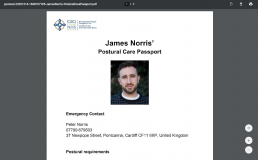
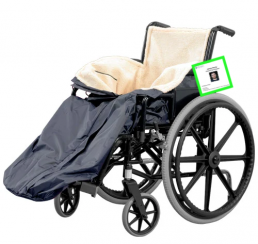
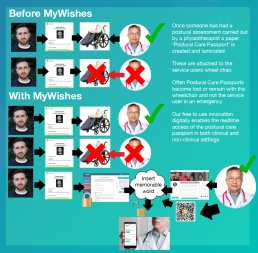
How the Postural Care Passport works
Once a Postural Assessment is completed, a hard copy (paper) is still provided to the person and can be attached to / kept within the person’s wheelchair. In cases of emergency the hard copy should initially be referred to due to the speed of accessing it.
If however this information is lost, damaged or unavailable the digital version can be accessible by entering the person’s memorable word into their public MyWishes page. More over, if rich media (videos, audio, high quality images etc) has also been uploaded to the postural care passport they too can be rapidly accessed once the person’s memorable word has been entered. Rich media was not previously available on paper based, postural care assessments.
Creating a Digital Postural Care Passport (for free)
Postural care assessments can be uploaded using the specially built upload feature within MyWishes Advance Care Plan section. This is also where the user enters the memorable word associated with their Postural Care Passport.
Accepted video file formats accepted include .MP4 (typically used when shot on Android phones) and .movs (typically used when shot on iPhones). To Create a free MyWishes account click here. If you are already part of the MyWishes community simply login
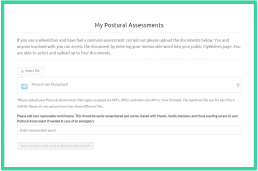
“Having a Digital Postural Care Plan Passport as well as a physical copy eliminates the risk of this vital information being lost and ensures a person’s Postural Care Passport is always available in both clinical and non-clinical settings.”

Things to consider when creating a Digital Postural Care Passport
- Is your Postural Care Assessment current and up to date?
- Have you notified your family and Physiotherapist(s) of your wish to digitise your Postural Care Assessment?
- Who might need access to your Digital Postural Care Passport? Who might you share your memorable word and your MyWishes handle (URL) with (Physiotherapists, friends, family, carers etc)?
- Have you requested videos and diagrams to be included with your Postural Care Assessment from your Physiotherapist?
Rapid access
- It is important that postural care assessments are rapidly available in case of emergency regardless of which electronic registers systems are used locally (for example EPACCs)
- It is also important that assessments are available in both clinical and non clinical settings
- It is important that assessments are rapidly available and can be viewed across various devices (laptops, mobile phones and tablets devices).
Further reading
- View the Postural Care Passport poster (European Association of Palliative Care World Congress)
- International Day of People with Disabilities – Spotlight on Postural Care Planning
- MyWishes Learning section
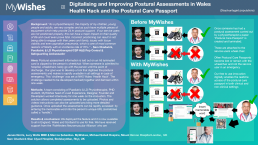

Other tutorials that you might find of value

Michael Sobell Hospice Palliative Care Department Mount Vernon Hospital, Gate 3 Northwood HA6 2RN United Kingdom (Map)
- Register and document your wishes for free here
- For all enquires click here
- To learn how MyWishes works click here
Sharing is caring…
How to plan for death (digitally)https://t.co/mlb8CEFtfk #DMAW2021 #InAGoodPlace
— MyWishes (@MyWishesApp) May 14, 2021
MyWishes free to use software was developed under the guidance of healthcare, hospice, legal and funeral professionals. Our platforms empowers society to make plans for both themselves and those they care about.
Being bereaved at Christmas
Bereavement at Christmas.
In this resource, Bianca Neumann, Head of Bereavement at Sue Ryder shares her advice for anyone going through a bereavement at Christmas. If you have been bereaved and are concerned about the festive period, it can be a good idea to think about how you would like to spend Christmas and have open conversations with those close to you.
Christmas and New Year are often associated with tradition or doing those things that ‘we’ always do together. This can be a difficult and upsetting time, especially when ‘we’ aren’t able to do these things anymore.
Whilst there is no ‘blueprint’ or ‘map’ for coping with grief, it can help to talk about how you are feeling and what would help you around the Christmas period. These conversations could help to negotiate a useful plan. Topics that might be helpful to consider include; how will you divide up your time? How will you allow room to spend time with others and time alone? Perhaps a balance between being alone and in company is needed? Do you want to keep old traditions or start new ones?

Things to consider about grief during the Christmas period
It can also be helpful to find ways to let others know that you are okay. Often people can worry about you, but really you may just want some space. Perhaps you could let people know that at certain times of the day you are going to spend some time alone or you could message them to say that you’re going to take some time to yourself.
It is important to remember that it is OK to feel the way you do, no matter what you are feeling. This could be a mixture of emotions that range from sadness to joy.
At the same time, be mindful that emotions take up our energy. Be kind to yourself and try not to ‘over-do’ things. It’s important to take time out and think about what will help you get through the day.

Practical ways to address grief at Christmas
Here are some practical things that might help with your grief around the Christmas period:
- Buy or make your own Christmas ornament or bauble to remember those who’ve died. If a photograph feels too much, then perhaps use a ribbon featuring their favourite colour or a sentimental object.
- You may still want to bring out their stocking or make one for them, which you, your friends and family can fill with cards, messages or letters. You can decide as a family whether you then would like to share these out-loud or keep them private.
- Have a small Christmas tree or memory wreath set up somewhere within your home in honour of the person who has died. You could decorate this tree or wreath with their favourite colours, photographs, any meaningful objects or messages.
- Make a paper chain with a message or memory of the person who has died written onto each ‘link’.
- Buy a big candle in honour of the person who has died and light for times of reflection and remembrance.
- You may want to make an object or cash donation to a charity you know they would have supported in their honour.
- You may want to decorate their headstone or plaque on Christmas Day.
- You may want to set a place at the dinner table for them or make a toast to them at the Christmas meal.
- If your family takes the annual Christmas photo you may want to choose an object or symbol to represent the person who has died.
This resource was written by Bianca Neumann, Head of Bereavement at Sue Ryder.
Sue Ryder has launched a campaign to inspire the nation to be more Grief Kind. It’s easy to show the people around us that we care, yet, when someone is grieving, many people are so scared of getting it wrong that they do nothing.
Sue Ryder is creating a national movement of kindness around grief which promotes open conversations about bereavement. To find out more visit sueryder.org/griefkind



Other tutorials that you might find of value
This resource was published in the MyWishes learning section. MyWishes free to use software was developed under the guidance of healthcare, hospice, legal and funeral professionals. Our platforms empowers society to make plans for both themselves and those they care about.

Michael Sobell Hospice Palliative Care Department Mount Vernon Hospital, Gate 3 Northwood HA6 2RN United Kingdom (Map)
- Register and document your wishes for free here
- For all enquires click here
- To learn how MyWishes works click here
Sharing is caring…
How to plan for death (digitally)https://t.co/mlb8CEFtfk #DMAW2021 #InAGoodPlace
— MyWishes (@MyWishesApp) May 14, 2021
How to assign a Lasting Power of Attorney (LPA)
Lasting Power of Attorney: making sure the people you trust the most, can make decisions that matter the most
In this guest post, Clare Fuller talks about the importance of making a Lasting Power of Attorney. Clare Fuller RGN MSc is a registered nurse with a career dedicated to Palliative and End of Life Care. She is an advocate for proactive Advance Care Planning and delivers bespoke EoLC education. She is also a Lasting Power of Attorney Consultant and director of Speak for Me LPA .
Introduction
My Uncle left school at fourteen training to become an electrician before joining the Royal Navy in 1941. He took part in the Artic Convoy in conditions that would be unimaginable for us today and was rewarded for his heroism 70 years later with the Arctic Cross. He married my Aunt and cared for her at home during a long decline with dementia until her death. Throughout his life my Uncle remained busy and skilled in electrical projects; a person we knew would always fix everything. This changed when began to forget things, and the man who once navigated the Arctic would get lost finding his home.
My Uncle had made a Lasting Power of Attorney for Health and Welfare and Property and Finance. This meant the people he trusted the most could make decisions that mattered the most for him as he became unable to make those decisions himself.

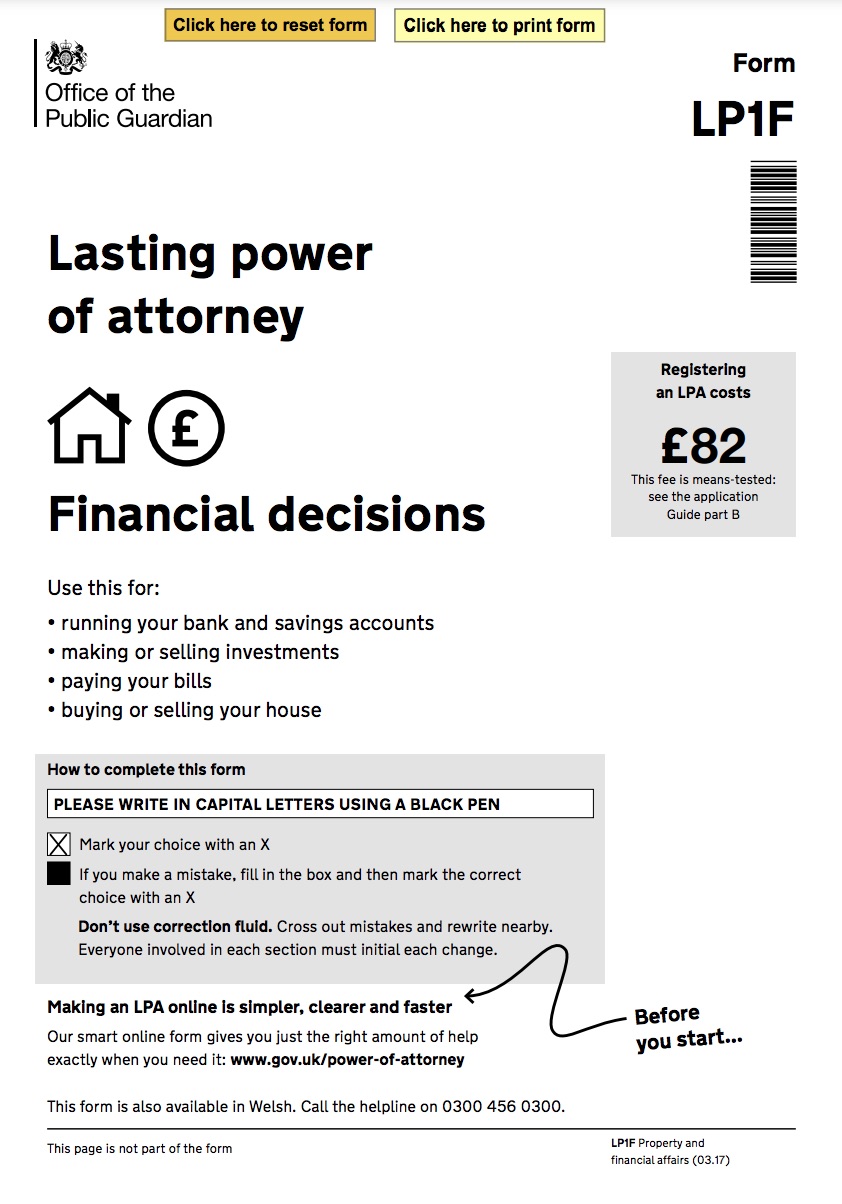
What is a Lasting Power of Attorney?
A Lasting Power of Attorney (LPA) is a legal document that lets you appoint one or more people to make decisions on your behalf. This gives you more control over what happens to you if you have a sudden accident or an illness and cannot make your own decisions. The people you appoint are called attorneys.
To make a Lasting Power of Attorney you must have the mental capacity to make the decision to appoint your attorneys. The form requires confirmation from a ‘certificate provider’ that you’re making the LPA by choice and that you understand what you are doing.
A Lasting Power of Attorney must be registered with the Office of the Public Guardian before it can be used. Pre COVID-19 this process was estimated to take approximately 8-10 weeks; however, the current waiting time is closer to 14 weeks. Too often people leave it too late to make a Lasting Power of Attorney.
What are the different types of Lasting Power of Attorney?
There are two different kinds of Lasting Power of Attorney, one for Health and Welfare and one for Property and Finance. A Health and Welfare LPA would be used if you lost capacity to make decisions about issues relating to health (e.g. whether you should have surgery or other medical treatments). An important element of the Health and Welfare LPA is that it offers the opportunity to give the person or people appointed, (the attorney(s)), authority to make life-sustaining treatment decisions.
A Property and Finance LPA is used for to appoint someone to make decisions about your money for things like paying bills, collecting pensions or selling your home and can take effect, with your consent, as soon as it is registered.
Why is it important to have a Lasting Power of Attorney?
It is a common misconception that your next of kin can make decisions for you should you lose ability to do this through illness or accident; but the only way to ensure this is through nominating them formally through a Lasting Power of Attorney. A Lasting Power of Attorney ensures that your voice is heard if you should ever lose the ability to make decisions and speak for yourself.
With no automatic right for your Next of Kin to make decisions your family may need to apply to the Court of Protection to be your Deputy if you lose capacity and don’t have a Power of Attorney. Once you have lost capacity, you can no longer choose who will be appointed your Deputy. Applying to the Court of Protection is a lengthy and costly process and can delay important decision making as well as be a significant burden on your family.
There are some excellent blogs on how the Court of Protection works and I have had the privilege of attending two hearings at the Court of Protection Bearing Witness: Anorexia Nervosa and NG Feeding in July 2020 and, more recently, Lasting Power of Attorney: Across Borders These were sobering experiences and interesting to see how decision making is made in court.
Without a Lasting Power of Attorney for Property and Finance, your family potentially will not be able to pay bills, manage your finances, pensions or care home fees. Campaigns show 73% of people think if a couple have a joint bank account and one person can’t make decisions for themselves, their partner can legally make decisions for them both. This is untrue
Without an LPA for Health and Welfare decisions your family will not be able to make decisions about important health matters, for example medical treatment and where you are cared for. 72% of people think your next of kin have the final decision in making treatment decisions in hospital if you are too unwell to make them yourself. This again is not true.
Through nominating someone now to act as you attorney for the future you protect your wishes avoid the possibility of both costly and lengthy Court of Protection costs.
Common misconceptions about Lasting Power of Attorney
Despite a widespread campaign across the UK, Lasting Power of Attorney remains little understood. As well as thinking your Next of Kin have automatic rights to make decisions on your behalf another common misconception is that a Lasting Power of Attorney need only be considered if you have a deteriorating illness or are elderly. Instead of waiting and finding yourself in sudden need, I suggest that Lasting Power of attorney is a bit like an insurance policy, there just in case you ever need it. Unlike an insurance policy though, the Lasting Power of Attorney needs doing only once (unless you chose to change it).
The other common worry I hear is about losing control, with a belief that making a Lasting Power of Attorney means you are giving up control of your life when indeed it is the opposite; making a Lasting Power of Attorney allows you to be in the driving seat and to choose ahead of time who you trust to make decisions – it takes effect only if you lose capacity or, in the case of Property and Finance, if you consent when it is registered.
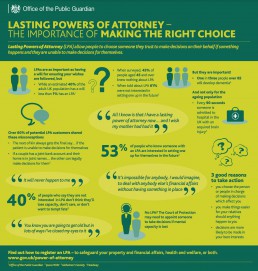
How do I make a Lasting Power of Attorney?
There are three options to making a Lasting Power of Attorney; a DIY approach, using a solicitor or using a Lasting Power of Attorney Consultant. Like everything, there are pros and cons to each choice and it is worth researching to find out the option that works best for you.
Once a Lasting Power of Attorney is drafted it must be signed strictly in the correct order by the appropriate people – there are restrictions on who can witness and be a certificate provider for example. It is then sent to the Office of the Public Guardian where the forms are checked, reviewed and processed which takes around 15 weeks. There is a fee of to be paid to the Office of the Public Guardian which is currently £82.00, however in some cases there are remissions or exemptions.
If there are any errors on the forms they will be rejected and you may need to pay the full £82.00 to re-apply. Data from the Office of the Public Guardian states about 15% of forms are rejected.
It is important to compare the options and ensure you chose the option most suited to your needs.
Three options
The DIY option involves using the GOV.UK site to make the forms. You will need to ensure information is correct, within legal boundaries and that the signatory process is completed in the correct order. This will cost you the registration fee of £82.00 per Lasting Power of Attorney.
*Completing independently is the most cost-effective option, however many people are put off by the potentially lengthy forms. Errors in completion, signing and rejection might be more likely to occur than the other options.
The Lasting Power of Attorney Consultant option involves engaging an independent consultant drafting the documentation after a discussion with you. You will need to pay the Consultant fees in addition to the Office of the Public Guardian fee. Depending on the service offered it will include full liaison with the Office of the Public Guardian in the event of any errors.
*Using an independent provider can ensure peace of mind and an individualised service and, whilst more expensive than a DIY approach, it should cost less than a solicitor.
The solicitor option involves engaging a solicitor to draft the lasting Power of Attorney documentation. Again, you will need to pay solicitor fees on top of the Office of the Public Guardian fee.
Using a solicitor will be a preferred option for some particularly if there are complex financial issues.
Questions to ask if engaging a LPA Consultant or Solicitor
- What is included in the cost, particularly:
- The Office of the Public Guardian fee
- Any Consultation with the Office of the Public Guardian if needed
- Provision of a Certificate Provider
- Provision of a Witness
- Re-application in the case of rejection
- Can a Face to face or remote service be offered?
- How long does it take for the consultation and drafting?
- How many consultations are included?
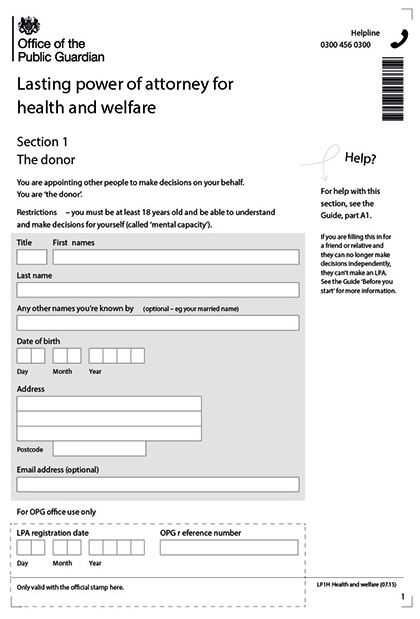
Can I complete my LPA on MyWishes?
No you cannot complete LPAs on MyWishes. LPAs need to be completed offline using a document created by the UK Government or on the Gov.uk website. We do however link through to the relevant documents within the advance care planning feature in the MyWishes application.
Once the LPAs process has been completed, we recommend that you share a copy of the document with someone you trust and discuss your LPA wishes.
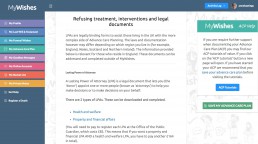
MyWishes free to use software was developed under the guidance of healthcare, hospice, legal and funeral professionals. Our platforms empowers society to make plans for both themselves and those they care about.
Other tutorials that you might find of value

Michael Sobell Hospice Palliative Care Department Mount Vernon Hospital, Gate 3 Northwood HA6 2RN United Kingdom (Map)
- Register and document your wishes for free here
- For all enquires click here
- To learn how MyWishes works click here
Sharing is caring…
If you liked this article please feel free to share it using your preferred social network or communication platform
Design your own Coat of Arms
What is a Coat of Arms?
Coat of Arms have been used for centuries as a badge to represent a number of things about a group of people. This can include interests, weather, faith etc.
A coat of arms is often associated with geographical regions, influential families, medieval times and historic battles and fictional stories.
*In this tutorial we reimagine and modernise creating a ‘Coat of Arms’. We hope to make this concept a form of ‘legacy creation’ and accessible for all.
![]()

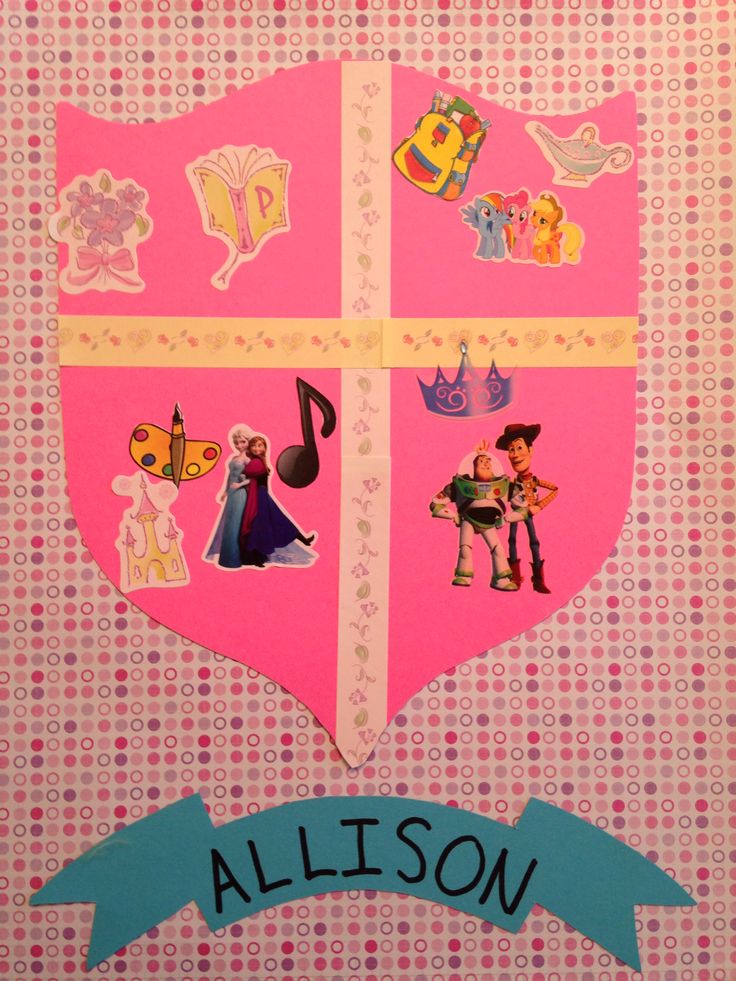
How to create your own Coat of Arms
Anyone can create their own own Coat of Arms.
The great thing about this activity is that it can be carried out by both the old and young. Furthermore, a coat of arms can be made collaboratively between a family or a friendship group at a gathering. It can be a very inclusive activity and intertwine history, interests and culture. A coat of arms can be created using a range of material and include sentimental possessions. You may want to use pens, paper, card, locally sourced flowers, clay, music festival tickets, greeting cards, photos etc.
Top Tip
Collaborate (brainstorm) together around what elements you would like to include. Elements might include a ‘family quote’ or animals that relate to you or your geographical region etc. Once all the elements and ideas have been agreed, start work on the design.

Inspiration: Henri Matisse
Inspiration can occur from a range of places. You might take inspiration from artists and popular culture. Inspiration may be vary from Harry Potter and A Game of Thrones to sport teams and ‘plastic artists’.
Henri Matisse, Pablo Picasso and Marcel Duchamp are seen the three artists who helped to define the revolutionary developments in the ‘plastic arts’.

“Plastic arts are art forms which involve physical manipulation of a plastic medium by moulding or modelling such as sculpture or ceramics”.
– Wikipedia

About Henri Matisse
After receiving surgery and finding movement difficult, Henri Matisse started to create art by cutting out shapes and composing collages despite often being confined to a wheelchair and his bed. His style and medium may be of interest and inspiration when creating your own coat of arms.
Matisse’s cut-outs collection has taken centre stage at both the Museum of Modern Art in New York and more recently at the Tate Modern in London during 2014.
Coat of Arms Conclusion
Once your coat of arms has been created it will instantly become a family heirloom and of huge sentimental value. Those who helped forge it and the wider family may take comfort from the design and the history and thought required to make it. A coat of arms can also be updated, evolve and change overtime. If you only create one coat of arms make sure that you state who will inherit it after your death within your last will and testament.
*If you have have more than one child (or more than one beneficiary) you may want to make a coat of arms for (or with) each of them using the same design. By making more than one coat of arms each recipient will have their own, unique heirloom.
If you create your own Coat of Arms and are happy to share it online, get in touch
Reframing art and making it accessible for all
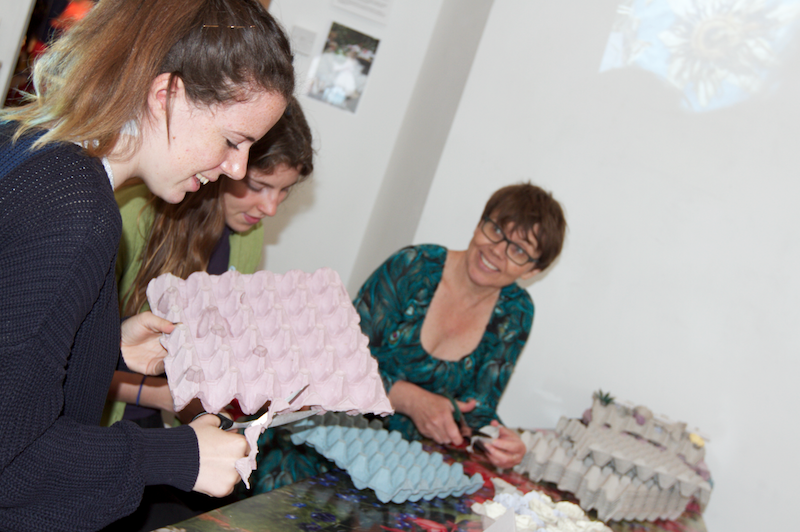 The ‘Reclaiming Funerals Collective’ funeral workshop at MyWishes popup shop on Camden High Street during Dying Matters Awareness.
The ‘Reclaiming Funerals Collective’ funeral workshop at MyWishes popup shop on Camden High Street during Dying Matters Awareness.
Document your wishes for free
MyWishes is a tech for good platform. Video tutorials empower our community to document and share wishes about their physical assets, their future health wishes and their digital legacy.
Once documents have been completed, they are shared with the people entrusted by the user. Documents can be updated when circumstances change and at any stage during someone’s life. MyWishes is free to use and will always be free to use.
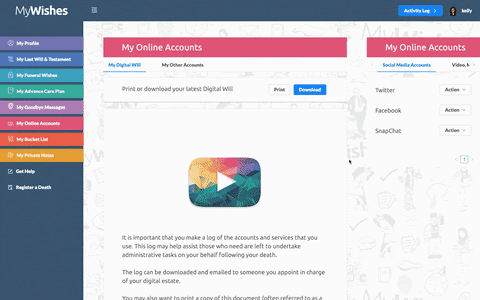
MyWishes free to use software was developed under the guidance of healthcare, hospice, legal and funeral professionals. Our platforms empowers society to make plans for both themselves and those they care about.
Other tutorials that you might find of value

Michael Sobell Hospice Palliative Care Department Mount Vernon Hospital, Gate 3 Northwood HA6 2RN United Kingdom (Map)
- Register and document your wishes for free here
- For all enquires click here
- To learn how MyWishes works click here
Sharing is caring…
🎓New Tutorial: How to Design your own 'Coat of Arms'
👉https://t.co/3wpmrob4g7… a family friendly, legacy and wellbeing activity. #lifehack #deathpositive #mindfulness #hpm #tutorial
— MyWishes (@MyWishesApp) August 18, 2021
🎓New Tutorial: How to Design your own 'Coat of Arms'
👉https://t.co/3wpmrob4g7… a family friendly, legacy and wellbeing activity. #lifehack #deathpositive #mindfulness #hpm #tutorial
— MyWishes (@MyWishesApp) August 18, 2021
How to backup a complete archive of your MyWishes data.
How to backup a complete archive of your data
MyWishes helps society make plans for the people and the things that are important to them. In order for us to provide this service, information is entered and uploaded to our platform. Each person’s information (data) is owned by them (not us). The information entered is used to generate high quality documents. These include Funeral Wishes, Last Will & Testaments, Advance Care Plans and Social Media Wills.
In order for us to adhere to GDPR standards and best practice, our users are able to download all of their data. They are also able to delete their MyWishes account and all of the information it contains.
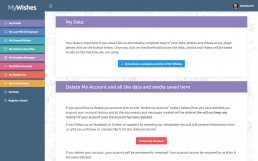
![]()
Click on the video to learn how to backup and download all of your data locally.
All our users are also able to download their documents (Last Will & Testament, Funeral Wishes, Social Media Will and Advance Care Plan) when editing and updating each document.
Once a document is completed we recommend sharing a copy with at least one person.
Signing and sharing
Some of the documents created on MyWishes should be signed and witnessed.
Instructions are provided with each document once generated, downloaded or printed.
MyWishes free to use software was developed under the guidance of healthcare, hospice, legal and funeral professionals. Our platforms empowers society to make plans for both themselves and those they care about.

Other tutorials that you might find of value

Michael Sobell Hospice Palliative Care Department Mount Vernon Hospital, Gate 3 Northwood HA6 2RN United Kingdom (Map)
- Register and document your wishes for free here
- For all enquires click here
- To learn how MyWishes works click here
Keeping the conversation going…
How to plan for death digitally
How to plan for death digitally!
This week is Dying Matters Awareness Week. During the course of the week, a different subject matter has been explored and it's importance discussed each day. Today planning for death 'digitally' is being examined by Dying Matters, coalition members, charities and the general public.
In this blog post we explore what planning for death digitally is, why it is important and how we can make plans for our digital lives.

The COVID-19 pandemic, the internet and society
The COVID-19 pandemic and the subsequent lockdown has increased the amount of time that we, as a society are spending online. According to OFCOM we Brits are now spending more than four hours a day online (OFCOM 2020). With an ever increasing amount of our lives now being spent online it is important that we think about the digital trail that we create (sometimes called a digital footprint) and the content that remains about us online and digitally after we die (also know as a digital legacy).
Over the last 12 months technology and led to changes within funeral services. This includes the normalisation of streaming funerals on Facebook, Zoom and other mainstream communication technologies. Other changes such as the temporary changes in UK law allowing for video calling software to be used when witnessing Last Will & Testament’s have taken place.
Changes in behaviours, law and practice has helped highlighted the increasingly important role the internet now has for social, physiological and monetary reasons in relation to end of life planning, death and bereavement.
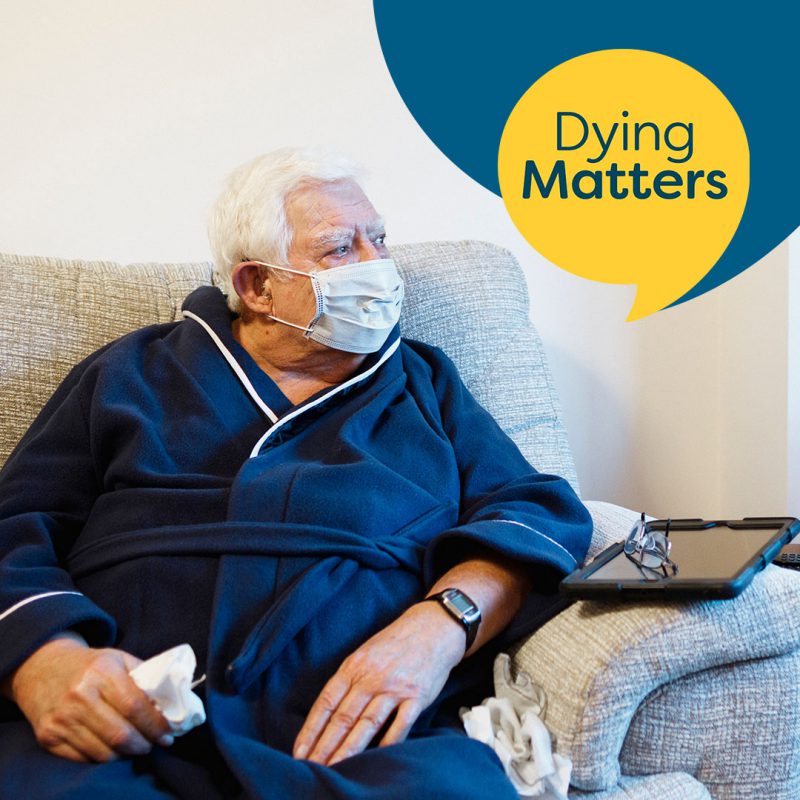
Watch the new Dying Matters video about digital assets planning
A short video about digital assets planning with Stephanie Owens (Dying Matters & Hospice UK), James Norris (Digital Legacy Association & MyWishes) and Gary Rycroft (Solicitor & Law Society) has been published today. It explores why a digital will and a last will is important and how they can co-exist, symbiotically with one another.
Creating a Digital Will (for free)
It is quick, easy and free to log your online accounts in a Digital Will on MyWishes. Video tutorials will guide you through the digital will writing process and our support team is ready should you require any further assistance.
Once your Digital Will has been completed, simply print it out and email it to your appointed ‘digital executor’. Your document can be updated when circumstances change and at any stage during the course of your life.

The sentimental and monitory value we place on our digital assets is increasing.
In a similar way to how we own physical assets (a book, a CD and perhaps our own home), we also own and possess a number of ‘digital assets’. These might include personal digital photos, music, shopping points, credit and virtual currencies (like Bitcoin). There can be a sentimental, monetary and/or an intellectual value on these digital assets.
The chart opposite highlights that nearly 50% of us now place a value on being able to access the social media profiles of someone we care about following their death. Making plans for our social media accounts to help ensure the longevity of the content it contains is important.
In 1999, The Financial Times reported a “sea of unclaimed assets sloshing around the financial system”. There is now an estimated £15bn of unclaimed assets in the UK. Many of these are behind password protected accounts and will never be accessible or claimed. Taking stock of your financial assets can help ensure that they are not lost or reclaimed corporate organisations or the UK treasury.
If someone you care about dies, how important would it be for you to be able to view their social media profile(s)?
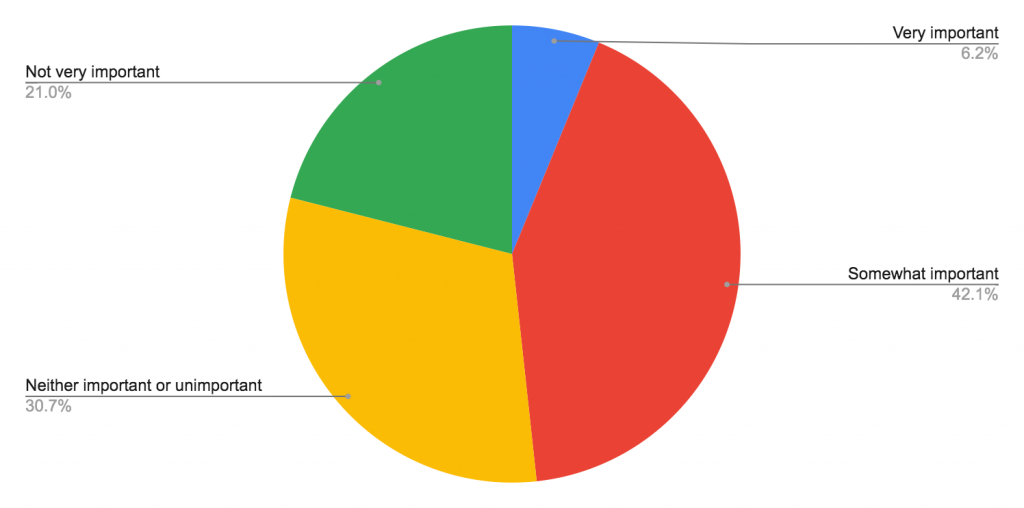
Data from the Digital Death Survey 2020
How to plan for death digitally
Think
- Take a minute to think about the different online accounts that you have. Think about accounts that you used to use (but no longer do) and whether photos, videos and other sentimental assets reside within them.
- Now think about the financial accounts and assets that have. Do you have ‘online only’ bank accounts, top up holiday cards, cryptocurrencies, a website, air miles or any subscription services (Netflix, Amazon Prime etc).
Plan
- Backup content, make copies and share your important digital photos and videos.
- Document your online wishes in a Digital Will (also called a Social Media Will)
- Make sure that you have written a Last Will & Testament. Some digital assets might be included in both your Digital Will and Last Will & Testament (for example; Cryptocurrencies like Bitcoin, Cardano and Dogecoin)
Talk
- Talk about your Digital Will, your Last Will and Testament, you Advance Care Plan and other important documents with people you trust and professionals (when it is suitable to do so)
- Discuss how you might pass on your passwords and grant access to accounts.
- Talk about your wider wises (the songs at your funeral, organ donation etc)
MyWishes free to use software was developed under the guidance of healthcare, hospice, legal and funeral professionals. Our platforms empowers society to make plans for both themselves and those they care about.
Other tutorials that you might find of value

Michael Sobell Hospice Palliative Care Department Mount Vernon Hospital, Gate 3 Northwood HA6 2RN United Kingdom (Map)
- Register and document your wishes for free here
- For all enquires click here
- To learn how MyWishes works click here
Sharing is caring…
How to plan for death (digitally)https://t.co/mlb8CEFtfk #DMAW2021 #InAGoodPlace
— MyWishes (@MyWishesApp) May 14, 2021
Video calling software can now be used when witnessing Last Will & Testament's
Every Last Will & Testament needs to be signed and witnessed by at least two people who are not beneficiaries of the estate for it to be legally binding. The Government has now introduced legislation that allows people to use video-conferencing technologies to witness the signing of wills. This is a temporary measure and a direct result of the COVID-19 pandemic.
Introduction
A need for changes in the law around Last Will & Testament’s had been identified by the Law Commission in 2017. A project was launched and work on this is ongoing. From the start of the Covid-19 crisis, the Law Society has been in discussion with the Ministry of Justice to explore a range of options available to government to alleviate the difficulties the public are encountering in relation to the making of wills.
A number of options were discussed with the objective of making the process of making a will simpler but to also ensure adequate safeguards remained in place to guard against abuse and undue influence of the elderly and vulnerable, especially in such unprecedented circumstances. We welcome the temporary use of video conferencing technology to witness wills in the absence of physical presence to help people make wills.
The Law Commission’s review of the law of wills is to continue and it is hoped that the final report will be published in advance of the end of the period of temporary measures. The Law Society will continue to work with both the Law Commission and Ministry of Justice on changes to to wills law over the coming years.
Ian is a member of the Society of Trust and Estate Practitioners “STEP” and is a workshop tutor for the “Administration of Trusts” paper on the STEP Diploma for England & Wales. He has been the chair of the Law Society ‘Wills and Equity Committee’ since July 2017 and a member of the technical committee advising the Law Society’s Wills Inheritance Quality Scheme (WIQS).
Interview with Gary Rycroft about will writing during the pandemic
-
Why is it important to have a Last Will & Testament?
If you don’t leave a Will fixed legal rules called the Intestacy Rules dictate who receives your estate. If you are in a relationship but not married or in a civil partnership this will NOT be your partner. If you are married or in a civil partnership, your other half may have to share with your children. If you are on second or subsequent marriage your kids from earlier relationships may miss out. So making a Will is about you having control. I also think it’s about showing your loved ones that you took the time to think about how they would be provided for on your death and that you care.
-
How has COVID-19 affected the ways in which solicitors support their clients
Lockdown and social distancing has meant solicitors are now unlikely to see their clients at their offices, but from the word go solicitors making Wills were classed as ‘Key Workers’ so we have been able to work through out and support our clients with telephone or video conferences to take instructions for Wills. Wills can be witnessed by any two adults who have mental capacity. During the pandemic I and other solicitors have witnessed the signing of wills outside our offices (e.g. the car park) or at client’s own homes (either in the garden or in the house subject to suitable ‘Covid’ measures e.g. gloves, masks, hand washing and social distancing). In some ways it has made the process more collaborative and at a time when many people have felt isolated and lonely Solicitors have enjoyed being in touch with and visiting our clients.
"Making a Will is about you having control. I also think it’s about showing your loved ones that you took the time to think about how they would be provided for on your death and that you care."

Gary Rycroft, Solicitor, Dying Matters Chair, Trustee for The Silver Line and MyWishes Legal Advisor

-
Why allowing people to sign their Last Will & Testament remotely / using video calling technology is important?
I actually don’t think it is for the reasons I have explained that we have been coping that well. I have serious worries about the uncertainty the new guidelines might produce. For example, the problem with ‘video witnessing’ has always been what about the bit offscreen that you can’t see. Is someone being subject to ‘undue influence’ by a third party who is out of shot? Also the Government have made clear the dispensation for video witnessing is only to be used as a last resort, when conventional witnessing is not possible. I have real fears this will be misunderstood and be misused and will lead to more Wills being challenged than ever before.
-
When someone writes their Will on MyWishes how should they have it witnessed
Once someone has has written their Last Will & Testament on MyWishes they can download it and send it to any fully qualified solicitor by email or print it and provide a hard copy to them for completion. If they want a solicitor to witness the signing I would recommend that the document is signed in front of the solicitor in person, when possible.
If the Last Will & Testament is shared remotely with a solicitor the testator (the MyWishes user who has made a will) might want to consider having a total of three witnesses on the video call. One witness might be the solicitor overseeing proceedings to the best of their ability remotely. The other two witnesses could be in close proximity with the testator. The two witnesses would then counter sign the document in view of the solicitor and the testator. It is important to remember that witnesses cannot be beneficiaries of any possessions allocated within the Last Will & Testament. Partners of of beneficiaries also cannot act as witnesses.
-
What is the difference between a solicitor and a ‘will writing expert’ or a ‘legal expert’
To call yourself a ‘solicitor’ you have to have certain defined legal qualifications (which take years to obtain) and be subject to ongoing supervision and insurance. For a consumer of legal services it is the Gold Standard in terms of consumer protection and a right to redress is you have a complaint. On the other hand anyone can call themselves a ‘Will Writer’ or ‘Legal Expert’ even though they may have no relevant expertise or experience, nor any qualifications or be regulated by a professional body. I am all for consumers having total choice about who they engage and pay for legal services, but it should be an informed choice about who and what they are getting and what consumer protections, or not, are in place
Gary is a practicing solicitor with experience supporting those who are vulnerable and the charity sector. Gary served on The Law Society Wills & Equity Committee 2009-2017 and The Law Society Private Client Advisory Committee 2007-2017 (acting as Chair 2015-17). He was a trustee of the National Council for Palliative Care (NCPC) until it merged with Hospice UK. He currently sits on the National Mental Capacity Forum Leadership Group (a joint initiative by The Ministry of Justice and Department of Health & Social Care) and is Chair of the Dying Matters Forum (set up by NCPC and now part of Hospice UK) which seeks to promote discussion about issues around end of life care.
How the new changes affect MyWishes users
MyWishes is the UK’s leading end of life planning software. One of our software’s features is a free to use will writing tool. This has not needed to adapt in order to adhere to the new laws around witnessing wills remotely using video calling technologies. The ways in which solicitors support our users might however might need to change in some circumstances. Gary highlighted that video and over the phone consultations have been important during the pandemic. He then went on to highlight that virtually witnessing the signing of Last Will & Testaments should be carried out as a last resort.
It is important that testator’s discuss their own unique circumstances with their solicitor before their Last Will & Testament is completed. This can be carried out using video technologies and / or in person. Whether or not you would then like your will to be witnessed in person or virtually is a conversation you should have with your solicitor, the decision should then be made by you.
Further details can be found on the Gov.UK website.

Free Webinar: How to plan for death without leaving the sofa
Most people have not stated what they would like to happen should they die unexpectedly or lose capacity to look after themselves. This ultimately means that most people have not made plans for their possessions, estate and their loved ones.
It is important that every adult takes ownership of their life and puts suitable plans in place. Not making plans simply passes the task onto a loved one to address at a later date. Not making plans might increase the amount of anxiety, heartache and costs involved with you future care, funeral and when distributing your possessions.
During a global pandemic the relevancy and urgency of this task is amplified.
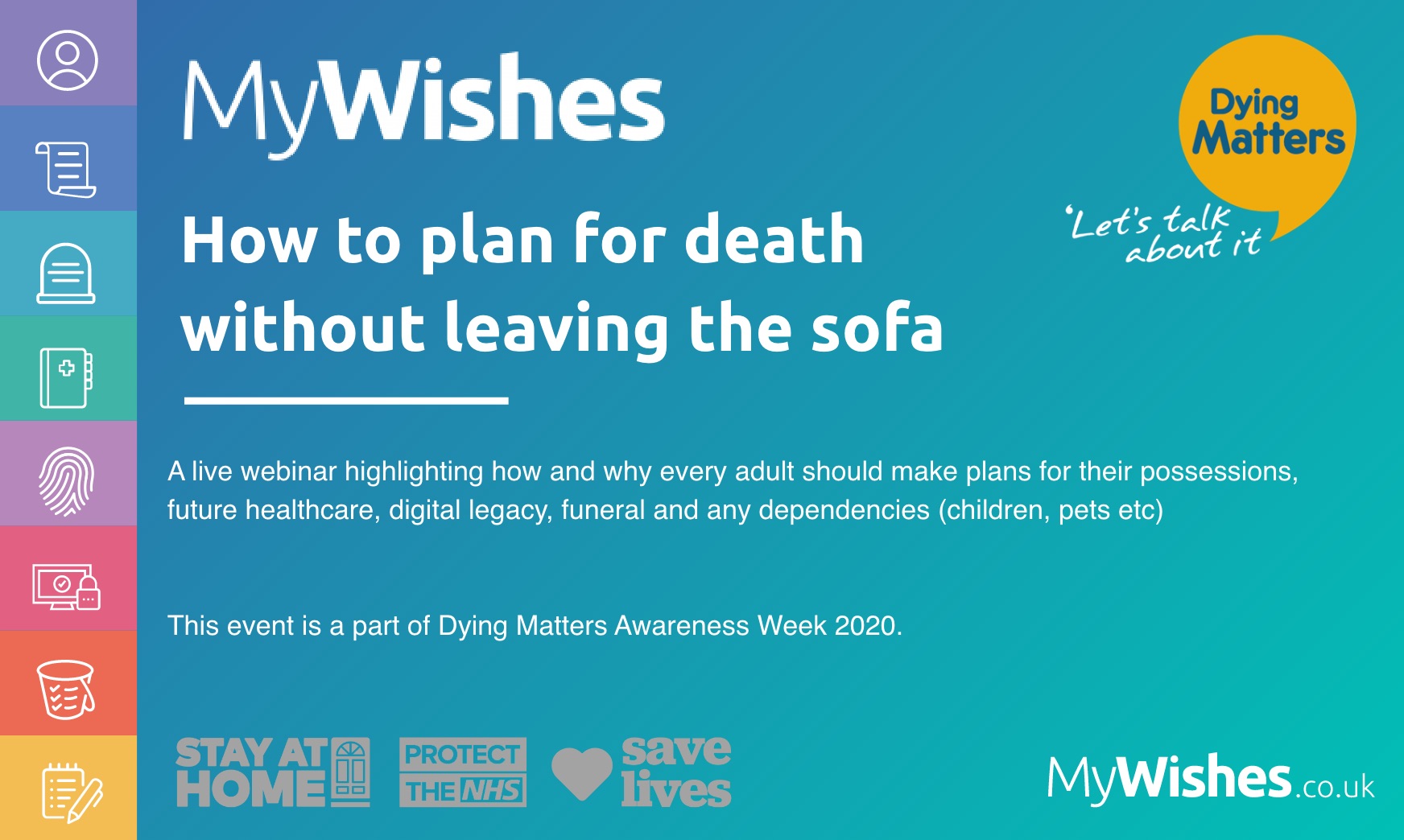 This event is taking place as part of Dying Matter Awareness Week 2020.
This event is taking place as part of Dying Matter Awareness Week 2020.
Every year in May, Dying Matters and a coalition of members host events during an Awareness Week. It gives society the opportunity to talk about and make plans for death, dying and bereavement. In 2020, the week will run from 11th to the 17th of May and the theme will be “Dying to be Heard”.
MyWishes provides a complete one-stop shop when planning for death. The platform is free to use and empowers each person to make plans for themselves and their loved ones. Our software integrates design principles familiar to those who use social networks. Our software’s features include: Will writing, advance care planning, funeral planning, bucket list creation, funeral playlist curation and digital legacy safeguarding.
*Please register (free) to virtually attend the event. Those who attend will be provided with a webinar link and an access code in two days before it takes place.
The ‘How to plan for death without leaving the sofa’ #webinar will take place during @DyingMatters Awareness Week. It’s free (and you do not have to participate or switch on your webcam).
Tickets & Info👉https://t.co/gKeUjJQkRh📽️#DyingToBeHeard #DeathPositive #AdvanceCarePlan pic.twitter.com/Y5h9jk8Zy4
— MyWishes (@MyWishesApp) April 21, 2020

MyWishes free to use software was developed under the guidance of healthcare, hospice, legal and funeral professionals. To learn more about how MyWishes works click here.
How COVID-19 is changing funerals
An overview of funerals before the COVID-19 age
The funeral sector has seen a number of changes over the last 10 years. It is now commonplace for celebrants to conduct funerals and for people to opt for a celebration of their life rather than a traditional funeral (often referred to as a Victorian funeral).
In a similar way to how wedding ceremonies have become ‘bespoke’, many funeral ceremonies have become a lot more personalised and a reflection of the life that the person once led. The charity Dying Matters has spearheaded national conversations about the importance of thinking, talking and planning for death. Their work has helped change attitudes and behaviours both in the UK and abroad around death and dying. If you require help talking about death their Talking about death and dying resource is a good place to start.
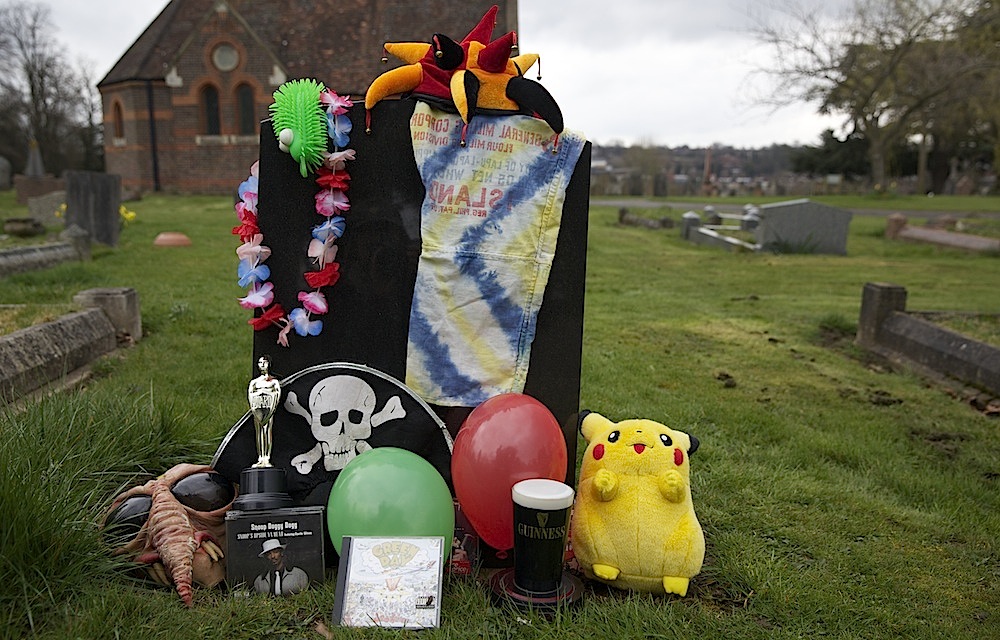 A survey of 2,000 people suggested that 54% wanted their funeral to be a “celebration of life”. Some 48% said they wanted it to incorporate their favourite “hobby, colour, football team or music”. (ICM 2019)
A survey of 2,000 people suggested that 54% wanted their funeral to be a “celebration of life”. Some 48% said they wanted it to incorporate their favourite “hobby, colour, football team or music”. (ICM 2019)
The cost of funerals
The cost of funerals and the total cost of dying (burial fees, registration fees, cremation fees etc) have continued to increase over the last 10 years.
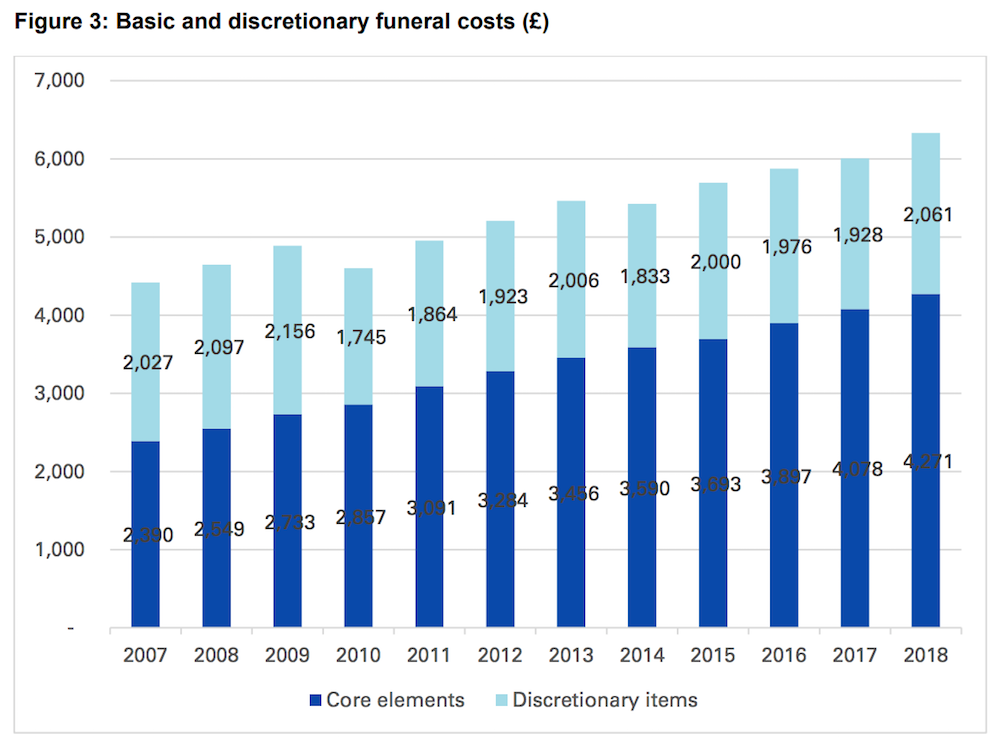 With rising funeral costs, rising living costs and a stagnant growth in people’s income many are unable to pay for their loved one’s funeral. Loans are often taken out and the bereaved take on high funeral’s debts (this is called ‘funeral poverty’).
With rising funeral costs, rising living costs and a stagnant growth in people’s income many are unable to pay for their loved one’s funeral. Loans are often taken out and the bereaved take on high funeral’s debts (this is called ‘funeral poverty’).
Digital memorials and grieving online
When someone dies they are normally either buried, cremated or their body is donated to medical science. When buried, cremated and after the body is no longer needed for medical purposes the remains or ashes are often buried or scattered. This act remains an important ritual and part of the grieving process. Almost 87% of us now use the internet and spend more than 3 hours per day using it (OFCOM 2019). This is a huge amount of time and the sentimental and monitory value placed on social media profiles, photos, videos, purchased media etc is increasing. For many, the importance of where someone’s remains are located becomes secondary to what remains of them online. The information that is available about someone online and in a digital format is called a digital legacy. A digital legacy might include family photos uploaded to Facebook and Instagram, videos uploaded to Youtube and information that remains about someone after their death on websites and blogs. To learn how to make plans for your digital legacy within a ‘social media will’ click here.
How COVID-19 is changing funerals
Funeral ceremonies
At the time of writing funerals are still allowed to take place in the UK. Social distancing measures now mean that only close relatives of the deceased are allowed to attend someone’s funeral. This is the case for those who die from COVID-19 and for those who do not.
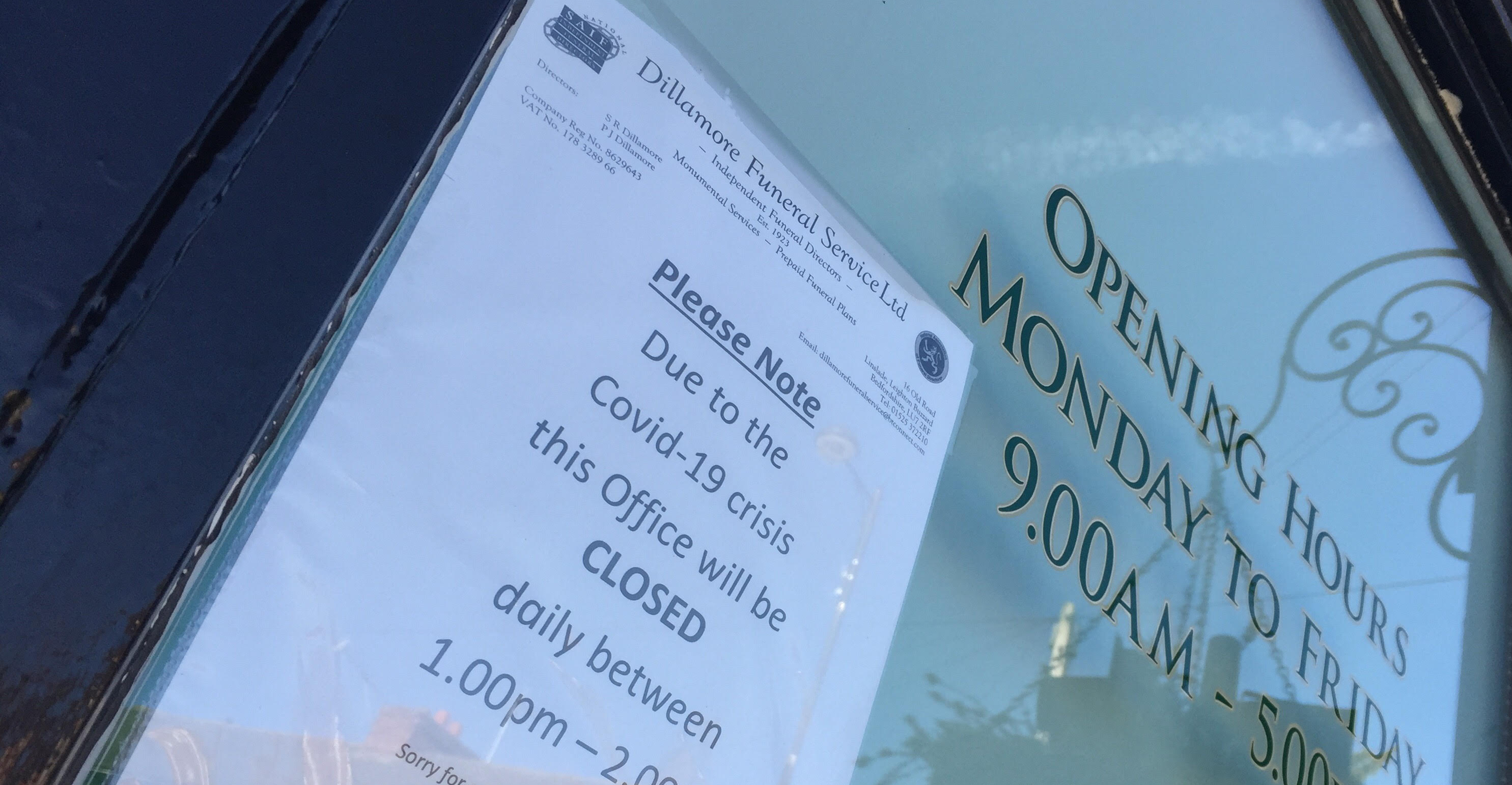 Being able to hug and shake hands at funerals by those outside of each person’s household is not allowed. The ritual of “saying goodbye” or “paying our last respects” cannot currently take place at a funeral by those who are not ‘members of the person’s household’ or ‘close family members’.
Being able to hug and shake hands at funerals by those outside of each person’s household is not allowed. The ritual of “saying goodbye” or “paying our last respects” cannot currently take place at a funeral by those who are not ‘members of the person’s household’ or ‘close family members’.
In line with Government guidance, funeral services should therefore only be attended by members of the immediate family who are not in any of the high-risk categories and are not self-isolating. No specific number has been set by the Government. Only the following people should attend:
- members of the person’s household
- close family members
- if the deceased has neither household or family members in attendance, then it is possible for a modest number of friends to attend
There may be additional restrictions in place at the service venue. Please check these in advance.
Further changes around social distancing and funerals might occur in the weeks and months ahead. For up to date guidance please visit the National Association of Funeral Directors website).
Funeral Directors
Funeral Directors continue to carry out their vital work during this very difficult time. Their practice has changed and arranging a funeral is now largely carried out utilising the phone, video calls and other electronic means.
Psychological impact
Many psychologists believe that the sudden change in behaviours around death, dying and bereavement will lead to large numbers of people experiencing complicated grief for years to come.
There are a number of charities and support phone lines about to assist. Some of these are listed below:
- If you are bereaved and would like to speak with someone, you can call Cruse Bereavement Care for free on Tel 0808 808 1677 or visit www.cruse.org.uk
- Child Bereavement UK offers support for families and professionals when a child dies or when a child grieves national helpline 0800 028 8840
- At a Loss has a website with useful bereavement resources www.ataloss.org
- Independent Age provides information and advice on a range of subjects including welfare, legal and financial Tel 0800 319 6789 or www.independentage.org/information/personal-life/when-someone-dies
- If you are looking for local help and support, Marie Curie has information on a range of issues including practical, legal and financial. Tel 0800 090 2309 or click here
The information above was extracted from NHS London Clinical Networks bereavement leaflet.
How to plan a funeral during the COVID-19 pandemic
- You might want to use MyWishes free funeral software to make plans for your funeral. Once completed it can be printed at home and a copy emailed to those close to you. Your funeral wishes can be shared with your local funeral director via email and request a quotation.
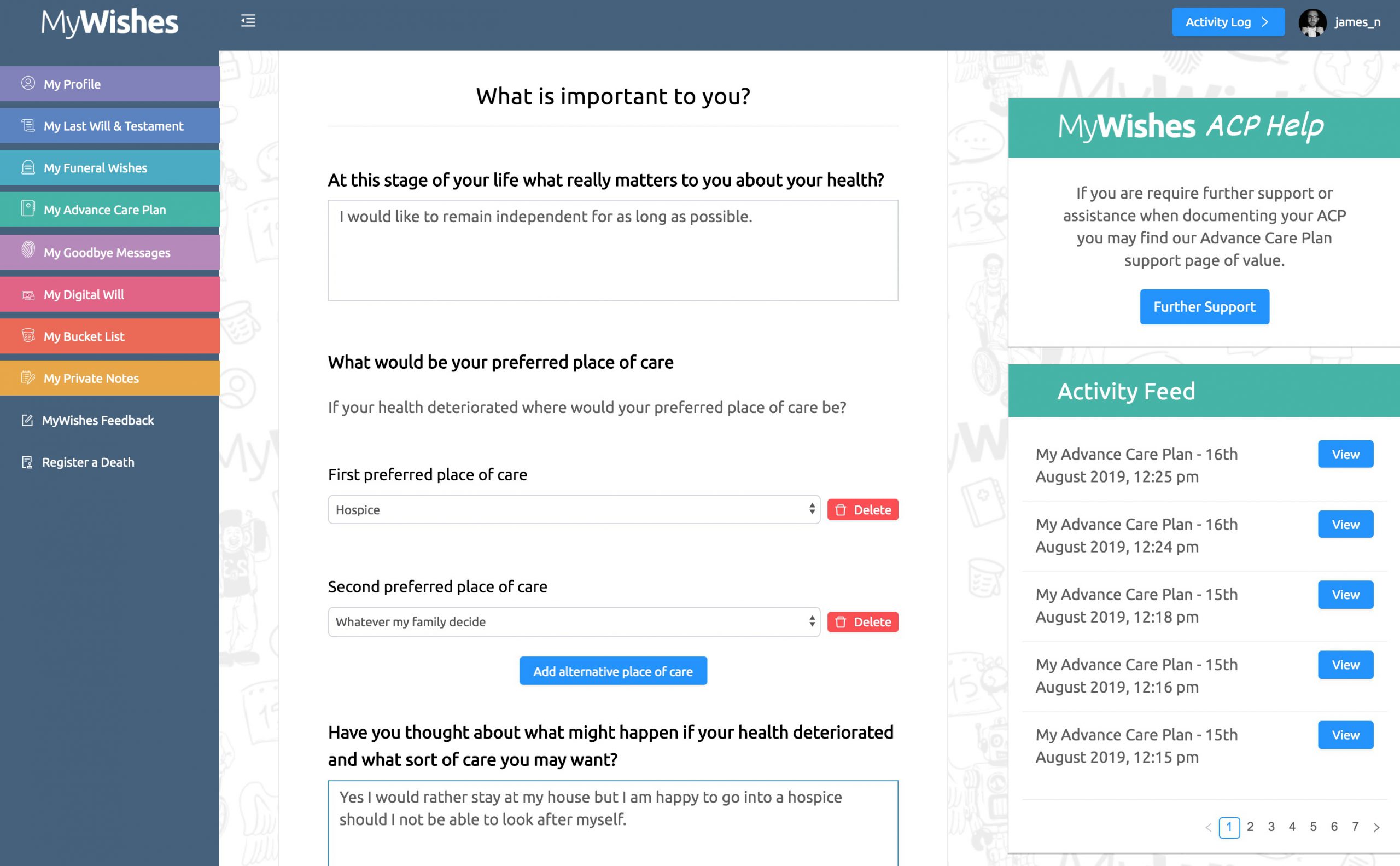
- Consider postponing a funeral ceremony or wake until a later date.
- Consider stating if you would be happy for your funeral to be live streamed (in your funeral wishes). If so, let a friend of family member know.
- Learn how to how to arrange and video stream a funeral on Facebook during the COVID-19 pandemic should you be asked to required to carry out this task. (this tutorial might also be of value for Funeral Directors)
- Learn How to Arrange a Funeral in a more traditional sense. Many things addressed in this tutorial are applicable when arranging a funeral during the current pandemic.
- Talk to your housemates, friends and family members about your funeral wishes. If you live alone, call or video call a friend or family member (instead of visiting them).
- Create a WhatsApp or Facebook group when arranging a funeral. Invite relevant family members and consider adding a funeral director to the group. This might help ensure that everyone is kept up to date with the administration and facilitation of the ceremony.
- If you are not very tech savvy you might want to ask someone else for technical assistance with specific tasks
- You might want to set money aside for your own funeral. To get a better idea of the costs that might be incurred, document your wishes and email them to your one or more local funeral directors and request a quotation.
Pre-Paid funeral plans
Pre-paid funeral plans allow people to pay for funerals in advance. We strongly recommend that you do not take out any pre-paid funeral plans until the pandemic is over. This is due to the following reasons:
- In light of current social distancing measures funerals do not allow for many guests to attend. In accordance with current guidelines limousines should not be used unless there is no other alternative transportation. Many funeral directors have stopped providing limousines and specific services for families all together.
- Further measures might include banning all funeral ceremonies (as is currently the case in Italy). If you pay for a funeral in advance and the services are not provided your next of kin might not be reimbursed.
- Corporate debt is very vulnerable at the moment. Pre-paid funeral planning companies are likely to be deemed as ‘high risk’ and might not survive in the months ahead.
Supporting you
If you have any ideas or suggestions how this post could be improved or how we can better assist you please do get in touch.
37% of people surveyed had thought about which songs they would like to have played at their funeral
Other tutorials that you might find of interest
- Communication Technologies & Being Bereaved Infographic
- New Book featuring MyWishes
- How to use AI to make plans for your Digital Legacy
- WARNING: Facebook will delete all historic, live-streamed videos on the 7th June
- Digital Legacy & Wellbeing
- Last Will & Testament – Frequently Asked Questions in the UK
- Last Will & Testament Glossary
- Organ Donation and leaving a legacy

MyWishes free to use software was developed under the guidance of healthcare, hospice, legal and funeral professionals. To learn more about how MyWishes works click here.
Tutorial: How to arrange and video stream a funeral on Facebook
Introduction
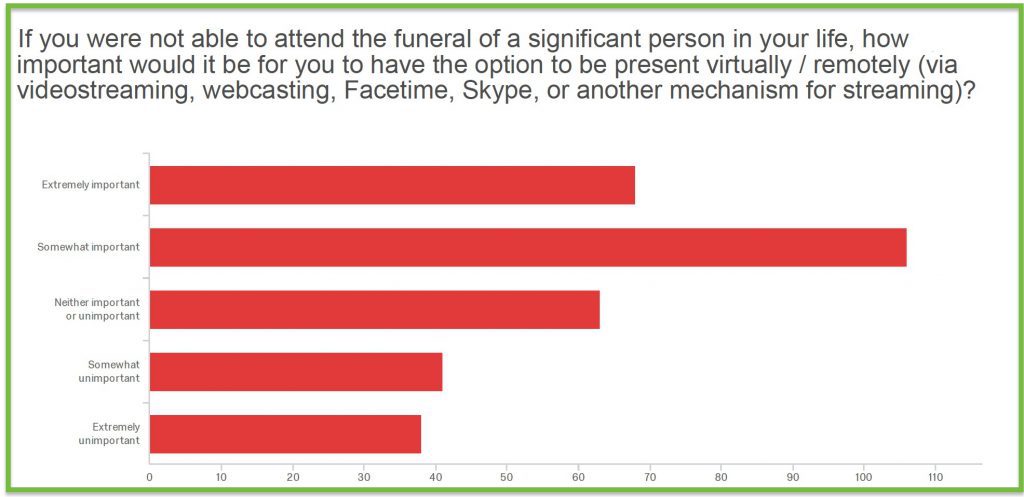 When someone dies from the Coronavirus (or anything else) funerals in the traditional sense cannot currently take place. Social distancing guidelines only allow for a small number of immediate friends and family to attend the ceremony. For many people watching and participating in a funeral online will not be as powerful, moving and meaningful as if it were to take place in a place of worship, crematorium, burial ground or other such space. Watching a funeral online may however help the bereaved feel like they have marked the person’s death with an event and help with the grieving process.
When someone dies from the Coronavirus (or anything else) funerals in the traditional sense cannot currently take place. Social distancing guidelines only allow for a small number of immediate friends and family to attend the ceremony. For many people watching and participating in a funeral online will not be as powerful, moving and meaningful as if it were to take place in a place of worship, crematorium, burial ground or other such space. Watching a funeral online may however help the bereaved feel like they have marked the person’s death with an event and help with the grieving process.
Our photos, videos and and interactions have increasingly moved into the digital space over the last 10 years. For many people social media sites like Facebook and Instagram are their main (and in some cases only) photo album. Until now however most people have not watched a funeral or memorial service online. Despite most people not having watched a funeral online many are able to envisage the benefits and would want to watch a funeral stream someone who they deem a significant person in their life.
When streaming is not possible & what to do if funerals are banned
Funerals might be banned altogether if social distancing measures are increased. If this occurs many aspects of the tutorial outlined below can be adopted and altered to fit the new guidelines. If video streaming is not possible due to logistical or technical reasons a virtual funeral, memorial or wake can still be held without a live stream.
How to arrange a funeral on Facebook
We recommend that when possible, the person who live streams a funeral is not a close friend or family of the deceased. This is due to the added stress video streaming can cause. In these difficult times and and when adhering to the current social distancing measures this might not however be possible.
- Create or login to your Facebook account
- Create an event, state when the funeral is due to take place and invite people to attend

- Decide whether or not you would like the funeral to be private or public. Generally funerals in the UK are pubic occasions open to all. Unless there are any special circumstances we would recommend making the funeral / wake public on Facebook to all to help reduce potential accessibility issues.
- Insert all of the details onto the event page (full description, date, time, photos etc) before inviting people to attend. You might want to ask someone else to review the content with you.
- Once you are happy with the design invite friends and family members to attend.
- Those attending will be able to comment using text, adding photos or by leaving a video message.
- Do not use the ‘schedule’ feature. This schedules when the event is made public. Ideally the Facebook Funeral event will be made public immediately after the content is added.
- You should state exactly what time and date the funeral is due to take place. Once again we do not recommend making a funeral event public until you have all of the details including the date, time and location of the funeral.

Many crematoriums now have video streaming facilities. If the ceremony is streamed by the crematorium you may want to post the video link provided by them in the event description and as a comment on the wall when the video stream starts. If the crematorium, place of worship or funeral director provides a video stream they should work with you to ensure that it is either streamed directly to the Facebook event you have setup.
If video streaming services are not provided you might want to employ a freelance videographer or local camera person to film the funeral. Their expertise, superior equipment etc might provide a better video stream and reduce the stress and anxiety experienced on the day of the funeral. If an external videographer or camera person is used you might want also to share this tutorial with them and provide any necessary access information (the reasons for this are highlighted below).
How to live stream a funeral on Facebook
The main problem when live streaming a funeral is the internet connection and the quality of the stream. Streaming can occur via a mobile phone, tablet or laptop. When possible we would recommend using a modern laptop (with a good camera or connected to a external camera / webcam).
Positioning the camera
The camera (external camera, webcam, phone or the laptop’s inbuilt camera) should be placed and fixed in a central point close to where the ceremony takes place. The diagram below highlights a suitable location where a camera could be located for a church funeral. If a tripod is not available a small table can be used to mount the laptop, camera or webcam.
*If the funeral is taking place outside the camera might need to be placed very close to the those conducting the ceremony. Outside conditions such as wind, rain and background noise can make it hard for devices to pick up the desired audio when an external microphone or amplification is not used.
Going live
The person who makes the video stream live should be the host or co-host of the Facebook event. This will give them administrative access to the funeral facebook event page. Without being a host or co-host they will not be able to publish the video stream automatically and directly onto the event page. To add a co-host simply add them when setting up the event or ‘Edit’ the event and add them. The host and any co-hosts will need to be ‘facebook friends’ with one another in order for this to happen.

When the live stream is published onto the event page (by a host or co-host) those who have confirmed that they will ‘attend’ on Facebook are notified that the live stream has started. They will only be notified if they are online and logged into their Facebook account. People who are offline or unable to watch the stream in real time will be able to watch the video after the funeral has taken place if it is published afterwards (recommended).

Viewing the service through Facebook’s viewfinder.
The person who is streaming the funeral will be able to view what the camera sees on the laptop or mobile used before the stream is made live. An example of how this might look can be viewed below (image taken from a Macbook).
Inserting the funeral stream into the Facebook event
Before starting the stream (and clicking on the ‘Go Live’ button) click on the button labelled ‘Share in an event’. Using this dropdown find and select the previously created funeral event and select.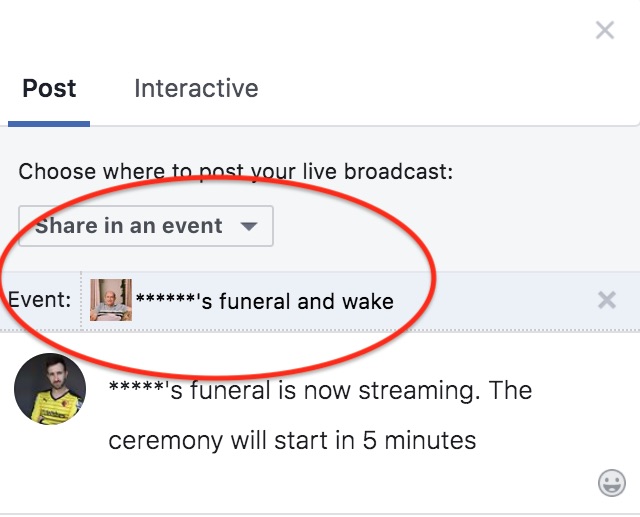
When the event stream is published the stream will now automatically be shared within the Facebook Funeral page.
Using third party cameras and microphones
If the device used is connected to third party equipment (like a external camera or sound card) a drop down option next to the camera and microphone icons will populate. These can be seen on the righthand side in the image below.
Go Live
Click on the ‘Go Live’ button when ready. To stop the stream end the stream within the Facebook viewfinder do not simply switch off the device. We recommend that someone reviews the stream (watches the video through the device capturing the video) on a regular basis during the ceremony.
Facebook users will be able to comment on the video stream and the event. Those who are not Facebook users will still be able to watch the video stream if they are provided with the video link (URL). or event link when containing the video stream. For this to occur the event and video stream should both be set to ‘public’. Non-Facebook users will not however be able to comment on the stream or within the event.
How to arrange a wake (using Zoom)
The tutorials above highlight how to create a funeral event and how to live stream a funeral on Facebook. They also explain how these two features can be used in conjunction with one another to provide a virtual funeral.
Facebook do not have a feature that enables realtime video conversations to take place between many people at once one another. This type of interaction often happens in virtual meetings however it can also be used for a virtual wake.

If you do decide to use Zoom for the wake afterwards you will be able to host a room. If you decide to create a wake on Zoom you might want to schedule it for an hour or so after the funeral ceremony has finished. To do this someone (the host) would need to create a Zoom account, generate and share the link and access code. A good place to share the zoom link and access code would be on the Facebook Funeral Event page days or weeks before the funeral. After the funeral has taken place those wanting to speak with one another could do so by clicking on the Zoom link and share condolences and stories.
Virtual funeral check list
- Try this tutorial at home days before the funeral. Do not wait until the day of the funeral to test live streaming.
- Ask the venue (church, crematorium etc) if they already have video streaming facilities and experience?
- Ask if the venue has WIFI (if not, you will need to tether from your phone to your laptop or use a mobile device)
- You are able to create a Zoom link for a meeting in advance. This can be shared via email and in the description of your Funeral Event Page in Facebook
- After inviting attendees to the funeral on Facebook you might also want to send a link to the event in WhatsApp, Facebook messenger etc. This will help reduce the risk of people not seeing the event until after it has taken place.
- Make sure that the device you are using is pugged in (when possible).
- If a laptop is used do not shut the laptop when the streaming starts
- You may want to disable screensavers or automatic power saving modes. These might cause disable the stream or be distracting for those attending the funeral in person.
- If streaming cannot take place you might want to take photos of the ceremony and add it to the Facebook Funeral event page afterwards.
Why Facebook & Zoom
Facebook is a used by most people in the UK and the USA (around 75% and 69% respectively in March 2020). Facebook ‘events’ including funerals are fairly easy to create and Live Streams on Facebook can be made public and accessible without needing to login. Streaming via Youtube could be used as an alternative however it might be more challenging when inviting friends and family members to attend and watch the stream (especially when in realtime).
Zoom is free to use (up to 75 people) and enables real time video discussions. This video conferencing service is used widely for business purposes and since the COVID-19 pandemic began used by the UK government, corporate and not for profit organisations across the globe.
Documenting your funeral wishes on MyWishes
MyWishes suite of tools are free to use. Our funeral planning software has a number of features to support society when documenting what they would like to happen at their funeral.

Our users can document, download and share their funeral wishes, write or upload their own video message (obituary) and publish their funeral playlist (songs that they would like to have played at their funeral). We have made a number of changes to the funeral planning software in the wake of the COVID-19 pandemic. This includes adding the question ‘would you like your funeral to be live streamed if people are unable to attend?’.
Other tutorials that you might find of interest
- Communication Technologies & Being Bereaved Infographic
- New Book featuring MyWishes
- How to use AI to make plans for your Digital Legacy
- WARNING: Facebook will delete all historic, live-streamed videos on the 7th June
- Digital Legacy & Wellbeing
- Last Will & Testament – Frequently Asked Questions in the UK
- Last Will & Testament Glossary
- Organ Donation and leaving a legacy
Leaving a "Goodbye" Video message using MyWishes
Overview
More and more people are filming videos of themselves to be shown after their death. These can be hugely powerful ways to both say” goodbye” and leave a lasting video legacy. DeadSocial’s free ‘goodbye’ tool is one way to schedule videos to be shown online after death. Other ways include leaving a video with a trusted party or a solicitor.
Getting started
Things to think about
- Be as serious, creative or somber as you see fit. There isn’t a right or wrong way to do this. It’s your video and should reflect you in today’s world. Stuff to think about…
- Don’t wear thin-stripy shirts, as your video may appear fuzzy when viewed.
- Wear something that reflects who you are.
What should I speak about?
- What is important to you?
- Who inspires you?
- Your family history knowledge?
- A story that you would like to be remembered and recited?
- What is your favourite saying (for example: always look on the Brightside of life)
- What are the highlights of your life (so far)?
- What are the low-lights of your life (so far)?
- Where you and your family are from?
- What your life has been like (to date)?
- What advice do you have for those you leave behind?
- What is your favourite music, art, books, aftershave, sports team?
- What are your religious / political views?
- What your hopes and dreams are for your friends and family? …or anything else that springs to mind. It’s YOUR video and your legacy.
Two very different ‘Goodbye’ videos
Lawrence Darani
A video by Lawrence Darani passing down some of his own stories and knowledge to help comfort his friends, family and inform future generations of the Darani family.
To watch more videos by Lawrence and learn from him about creating your own ‘ethical will’ click here
Carla Zilber-Smith
A video by Carla Zilber-Smith passing down comfort through comedy and a smile
How to leave a goodbye message using MyWishes
-
My Goodbye Message
Our Flagship ‘Goodbye’ messaging tool enables our users to send out a goodbye message and a series of scheduled messages. These are only published after the user’s death and in accordance with their wishes.
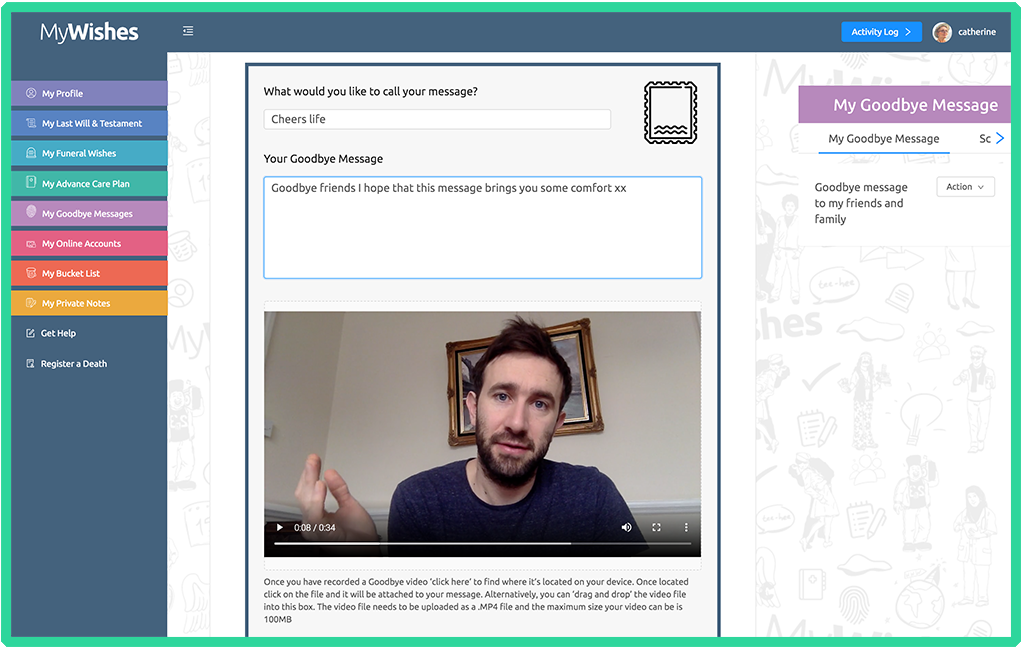
To learn more about this feature click here
-
My Funeral Message
Our funeral planning tool enables users to either write or record a video of themselves to be featured as part of their obituary

To learn more about this feature click here
What kind of videos will you leave behind?
You can use MyWishes to leave video, image and text messages for your friends and family. Once logged in to the software our step videos will guide and support you if you need it.
Other tutorials that you might find of interest
- Communication Technologies & Being Bereaved Infographic
- New Book featuring MyWishes
- How to use AI to make plans for your Digital Legacy
- WARNING: Facebook will delete all historic, live-streamed videos on the 7th June
- Digital Legacy & Wellbeing
- Last Will & Testament – Frequently Asked Questions in the UK
- Last Will & Testament Glossary
- Organ Donation and leaving a legacy

MyWishes free to use software was developed under the guidance of healthcare, hospice, legal and funeral professionals. To learn more about how MyWishes works click here.
How to log out of MyWishes
How to log out of MyWishes
Once you have created an account and are logged into MyWishes you can log out at anytime. In the top righthand corner of the application click on your username (in the image below the username is CarolineLloydsDoyley). The sub navigation displaying the words ‘Profile’ and ‘Logout’ will show.

Click on the text that says ‘Logout’ to logout of MyWishes. You can log back into MyWishes at anytime.
Automatically logging out of MyWishes
For security reasons if you leave your browser open MyWishes will log you out of your account after 30 minutes of inactivity. Once logged out of MyWishes you will be able to log back into your account at anytime using the email address and password you entered when setting up your account
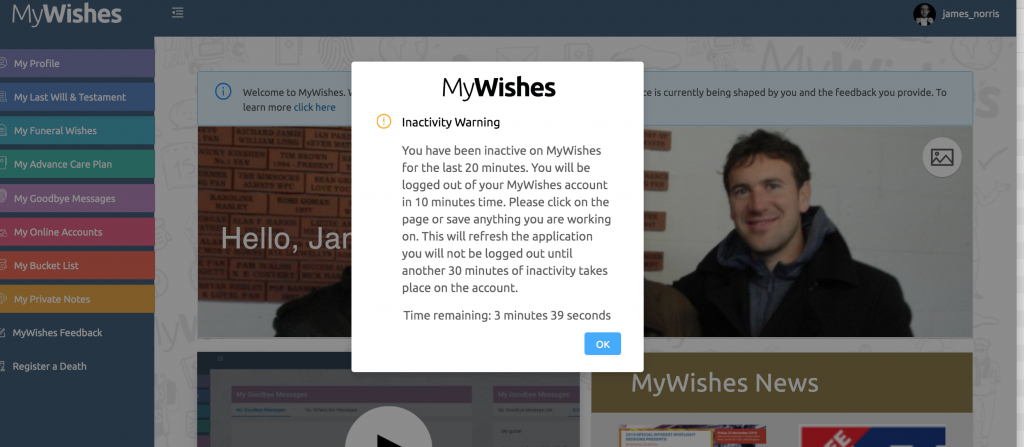
To read a step by step tutorial highlighting how you can register for a MyWishes account click here.
Other tutorials that you might find of interest
- Communication Technologies & Being Bereaved Infographic
- New Book featuring MyWishes
- How to use AI to make plans for your Digital Legacy
- WARNING: Facebook will delete all historic, live-streamed videos on the 7th June
- Digital Legacy & Wellbeing
- Last Will & Testament – Frequently Asked Questions in the UK
- Last Will & Testament Glossary
- Organ Donation and leaving a legacy

MyWishes free to use software was developed under the guidance of healthcare, hospice, legal and funeral professionals. To learn more about how MyWishes works click here.
Dealing with Grief in today's World
"Just as death is a certainty, so too is grief. It is a universally shared experience and yet totally unique to each individual. Asking for and finding the right support for each person can be challenging. But it is available"
— Annie Broadbent, author of We Need to Talk About Grief

Supporting the Bereaved
Someone you love has recently been bereaved. You desperately want to be there for them, but you don’t really know how. It can be a daunting prospect – supporting someone you care about through a time of so much pain, especially as there is currently not a huge amount of support available for the supporters. Finding the right words to comfort your friend, and knowing what you can offer to do is often overwhelming, confusing and sometimes quite frightening. Each person responds differently, and what they need from you will be further influenced by who it is that died, how they died, and what their specific circumstances are. But there are certain things that can help, and other things that might be best avoided.
Supporting the recently bereaved
A letter to Frankie Knuckles family
The Obama family wrote a letter of support following the death of the influential DJ and music producer Frankie Knuckles. This letter was sent at a time when Barack Obama was president of the United States of America.
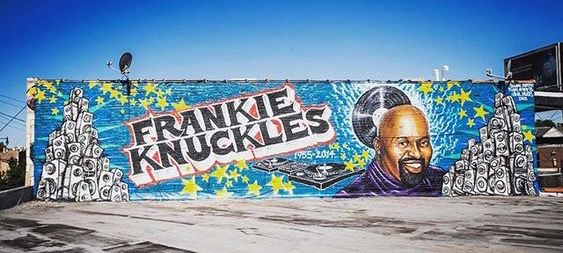
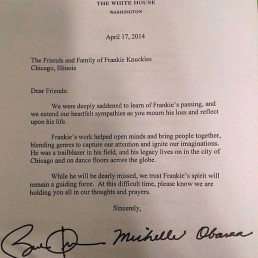
Talking about Grief
We all experience grief in different ways. This will be influenced by a number of factors such as the type of death, the relationship to the deceased, and the age/culture/support network of the bereaved. Some people may find talking about their experience helpful, others may find it very difficult and it is likely that the bereaved will oscillate between the two. Things such as the Death Café offer a safe and welcoming place to talk about all things death, dying and grief.

Grief from a ‘Reddit’ thread (contributor unknown)
Over the years many different psychologists have tried to define and calculate grief into different stages and phases. The diagram below debunks one of these attempts and reworks it based on the creator’s own experiences.
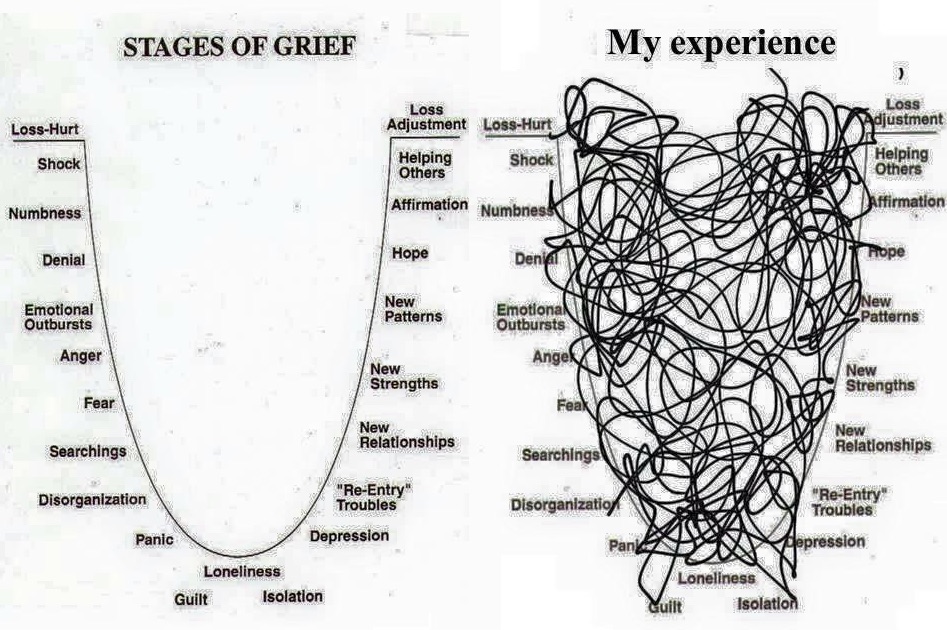
Grief online
The internet has changed the way in which we remember and grieve forever. It’s important to bear in mind that this can be both supportive and also difficult for some people. There are now a range of online forums for those experiencing grief and various blogs of people’s experiences which can be subscribed to.
Social media sites such as Facebook offer an online forum for people to share photos, memories of the deceased and invite people to funerals and memorials.
Conclusion
There is no right or wrong way to grieve. People may feel anger soon after a loved one dies often turning to sadness later on. Knowing that your emotions may change overtime and that this it common may help the bereaved understand that this is normal.

A selection of grief and bereavement resources from Charities within the UK
- Dying Matters Being there (UK leaflet)
- Cruse Bereavement care areas & branches (UK)
- Grief Encounter helping bereaved children (UK)
- Moyer Foundation supporting bereaved children (USA)
- Maggie’s Centre’s map of cancer support centres (UK)
Bereavement and grief tutorials by MyWishes

MyWishes is the UK’s leading end of life planning software. It is free to use and can empower your to write your will, plan your funeral, safeguard your digital legacy, plan your future care and publish a bucket list.

MyWishes free to use software was developed under the guidance of healthcare, hospice, legal and funeral professionals. To learn more about how MyWishes works click here.
Digital Legacy Checklist
 Overview
Overview
The actions we take, the way we behave and the choices we make in life help to shape the legacy we leave behind in death. These actions are increasingly being carried out and overtly spoken about online. By thinking about our digital legacy and planning for our inevitable departure we are able to highlight certain personally traits and our tell stories for those left behind.
– James Norris, MyWishes founder
Digital Legacy Checklist
Below is a basic checklist of things you may want to consider when evaluating your online footprint (this is sometimes referred to as a ‘digital footprint’). By evaluating the points below we hope that it will evoke thought and lead to a proactive outcome.
- Search for (your name) in Google and see what appears (in Google search, Google image search and Google video search). If there is information or media (such as photos and videos) that you do not want to be remembered for consider removing them.
Make sure that you have given directions about what you would like to happen to your online accounts and profiles in your Social Media Will.
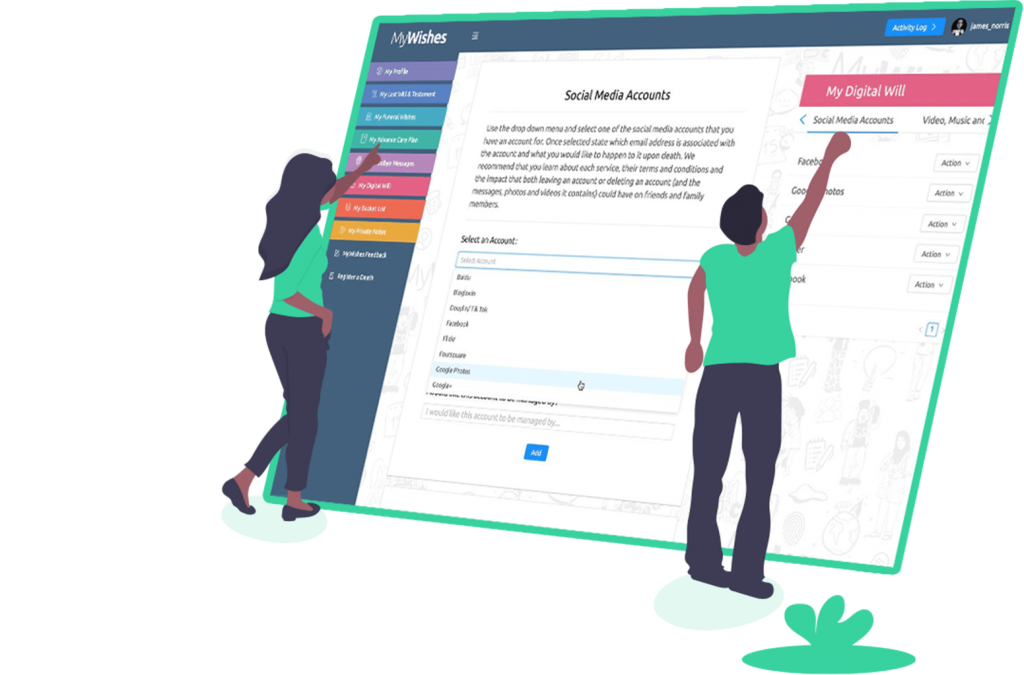 MyWishes free software includes a section where users document their online accounts and forge a social media will. If you decide to create a social media will using MyWishes you should download a copy (PDF) printed or email the document to someone you trust once it has been completed.
MyWishes free software includes a section where users document their online accounts and forge a social media will. If you decide to create a social media will using MyWishes you should download a copy (PDF) printed or email the document to someone you trust once it has been completed.
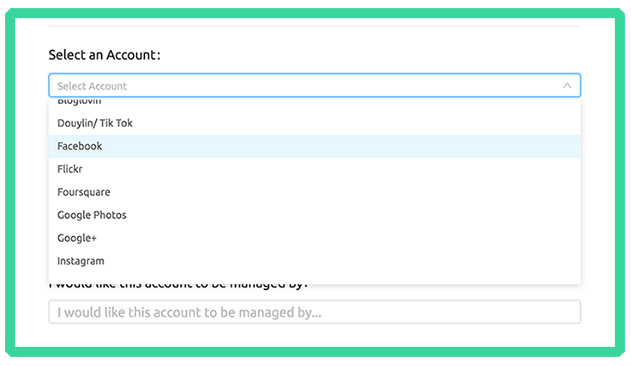
- Tell at least one person where your Social Media Will is stored and consider sharing a copy with more than one person.
- Consider leaving a ‘goodbye’ message‘ for your friends and family as part of your Ethical Will.
- Download and backup your media saved on third party social media and online sites. Once downloaded you may want to print and share the photos, videos and files that are of the greatest sentimental and monitory value.
- If you have a website or blog that you would like to remain live once you have died make sufficient plans, technical resource and budget for this to occur.
- Understand the terms & conditions of the online platforms and services that you use.
- Consider how to pass on your passwords and what levels of access you would like others to have.
- If you have digital assets that are of a monitory value (business website, cryptocurrency etc) add them to your Last Will & Testament

Other tutorials that you might find of interest
- Communication Technologies & Being Bereaved Infographic
- New Book featuring MyWishes
- How to use AI to make plans for your Digital Legacy
- WARNING: Facebook will delete all historic, live-streamed videos on the 7th June
- Digital Legacy & Wellbeing
- Last Will & Testament – Frequently Asked Questions in the UK
- Last Will & Testament Glossary
- Organ Donation and leaving a legacy

MyWishes free to use software was developed under the guidance of healthcare, hospice, legal and funeral professionals. To learn more about how MyWishes works click here.
How to find someone's 'My Funeral Wishes' document
This guide will first help you to understand what different formats ‘My Funeral Wishes’ documents can be saved as. It will then provide advice as to how to find someone’s document if you think they had stated their funeral wishes using MyWishes.
Once a MyWishes user has completed their funeral wishes they are able to:
- Download the document locally to the device they are using (PDF)
- Email the document to someone they trust (friend, family member, funeral director etc)
- Print the document and keep it in a safe place.
If you are looking for someone’s funeral wishes document a copy may be available
- The device they use for logging into MyWishes (saved as a PDF)
- With someone they have entrusted with the document (friend, family member, funeral director etc)
- Within their email ‘Sent’ box.
- In a safe place where they live (after a copy was printed out).
Someone’s My Funeral Wishes might be saved as a PDF document on one of the internet enabled devices they use (computer, laptop, work computer, tablet etc). It may also be printed out (normally on A4 paper) and timestamped with the last time it was updated (as shown above).
Talking about funeral wishes
Some MyWishes users have not completed and shared their Funeral Wishes documentation. You may however find that their wishes have been told to a friend, relative or a funeral director.
Further support
If you require any support please feel free to get in touch .
Documenting your own wishes
It is important that we all document our wishes. MyWishes makes the complex and fragmented task of documenting our wishes easy. To learn more about our free funeral planning software click here.

Other tutorials that you might find of interest
- Communication Technologies & Being Bereaved Infographic
- New Book featuring MyWishes
- How to use AI to make plans for your Digital Legacy
- WARNING: Facebook will delete all historic, live-streamed videos on the 7th June
- Digital Legacy & Wellbeing
- Last Will & Testament – Frequently Asked Questions in the UK
- Last Will & Testament Glossary
- Organ Donation and leaving a legacy

MyWishes free to use software was developed under the guidance of healthcare, hospice, legal and funeral professionals. To learn more about how MyWishes works click here.
How to create and share your funeral playlist on MyWishes
What is a funeral playlist?
A funeral playlist is a collection of songs and poems that someone would like to be played, sung or spoken at someone’s funeral.
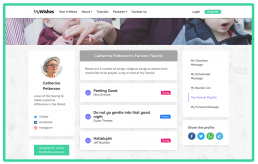
Why should I create a funeral playlist?
If music is an important part of your life you may also place an importance on the the music that is played or sung at your funeral. It takes a couple of minutes to document your funeral playlist on MyWishes and once it has been completed you can share it with your friends an family via email or publicly on your social media channels
Creating your own funeral playlist on MyWishes
It is really easy to collate and share your funeral playlist on MyWishes.
- Register and login and go to the my funeral wishes feature.
- Click on the ‘My Funeral Playlist’ section.
- You will now be able to add Items to your funeral playlist and state whether or not you would like the information to be public or private. If you set items to private they will not display on your unique, public URL. Furthermore items set as private will not show if shared across your social media sites.
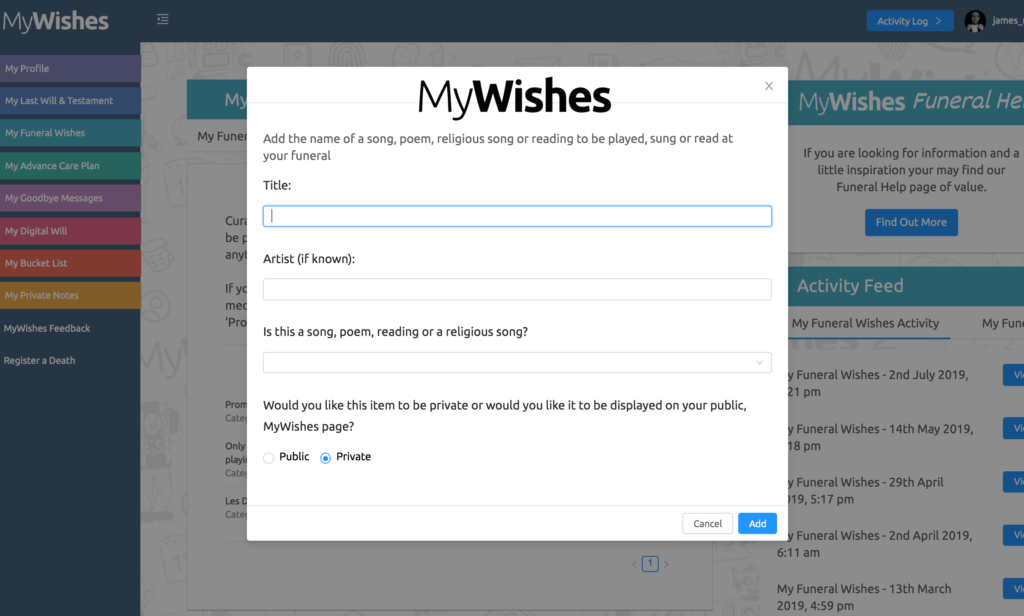
“You may want to add a song from a band you went to see perform, request a friend to perform a piece on the piano or for a family member to read a poem”.
Deciding whether to make your funeral playlist public or private
Your funeral wishes document a private document. Your funeral playlist however will be made public by default. If you would like to use the My Funeral Wishes feature but would like it to be private you will need to change the viability of your MyWishes public URL from ‘public’ to ‘private’. A step by step guide showing you how to do this can be found here
Sharing your funeral playlist
- PDF download
Once you have completed your funeral playlist it will be added to your ‘Funeral Wishes’ document and available to download to the device you are using. The document will download as a PDF and can be attached and emailed to friends and family. You may also want to email your funeral wishes directly to chosen funeral director. By sharing your wishes there are more likely to be adhered to.
- Social media
You may want to share your funeral playlist on your social media accounts. This might help evoke conversations around the songs that you have chosen and your wishes in general.
 Creating and publishing your funeral playlist on MyWishes is free and easy.
Creating and publishing your funeral playlist on MyWishes is free and easy.
Other tutorials that you might find of interest
- Communication Technologies & Being Bereaved Infographic
- New Book featuring MyWishes
- How to use AI to make plans for your Digital Legacy
- WARNING: Facebook will delete all historic, live-streamed videos on the 7th June
- Digital Legacy & Wellbeing
- Last Will & Testament – Frequently Asked Questions in the UK
- Last Will & Testament Glossary
- Organ Donation and leaving a legacy

MyWishes free to use software was developed under the guidance of healthcare, hospice, legal and funeral professionals. To learn more about how MyWishes works click here.
How to create a Bucket List on MyWishes
Overview
A bucket list is a list of items someone would like to do or achieve before they die. The phrase originates from the term “kicked the bucket”.
Creating a Bucket List
No matter our age, financial or health circumstances we can all create a bucket list. This might be a short list of personal activities or an elaborate list of goals. Inspiration can take many forms. Your bucket list might be inspired by friends, family and a range of different interests. We are all unique and everyone’s bucket list will differ. The most important thing is to list items that are important to you at this moment in time and then focusing on experiencing or achieving them.

Learning from other peoples regrets can be a powerful catalyst for self-reflection and improvement. You might find the ‘top 5 regrets of the dying’ of value and inspiration before adding items to your Bucket List.
Top 5 regrets of the dying
The top five regrets of the dying, as witnessed by Bronnie Ware (a Palliative Care Nurse) can be found below.
1. I wish I’d had the courage to live a life true to myself, not the life others expected of me.
“This was the most common regret of all. When people realise that their life is almost over and look back clearly on it, it is easy to see how many dreams have gone unfulfilled. Most people had not honoured even a half of their dreams and had to die knowing that it was due to choices they had made, or not made. Health brings a freedom very few realise, until they no longer have it.”
2. I wish I hadn’t worked so hard.
“This came from every male patient that I nursed. They missed their children’s youth and their partner’s companionship. Women also spoke of this regret, but as most were from an older generation, many of the female patients had not been breadwinners. All of the men I nursed deeply regretted spending so much of their lives on the treadmill of a work existence.”
3. I wish I’d had the courage to express my feelings.
“Many people suppressed their feelings in order to keep peace with others. As a result, they settled for a mediocre existence and never became who they were truly capable of becoming. Many developed illnesses relating to the bitterness and resentment they carried as a result.”
4. I wish I had stayed in touch with my friends.
“Often they would not truly realise the full benefits of old friends until their dying weeks and it was not always possible to track them down. Many had become so caught up in their own lives that they had let golden friendships slip by over the years. There were many deep regrets about not giving friendships the time and effort that they deserved. Everyone misses their friends when they are dying.”
5. I wish that I had let myself be happier.
“This is a surprisingly common one. Many did not realise until the end that happiness is a choice. They had stayed stuck in old patterns and habits. The so-called ‘comfort’ of familiarity overflowed into their emotions, as well as their physical lives. Fear of change had them pretending to others, and to their selves, that they were content, when deep within, they longed to laugh properly and have silliness in their life again.”
Creating and sharing your bucket list on MyWishes
Creating your bucket list
Register or login to your free MyWishes account and go to the Bucket List feature. Now click on the ‘Add New Item To My Bucket List’ button. You will now be able to add the item to your Bucket List and assign a date that you hope to achieve it by.
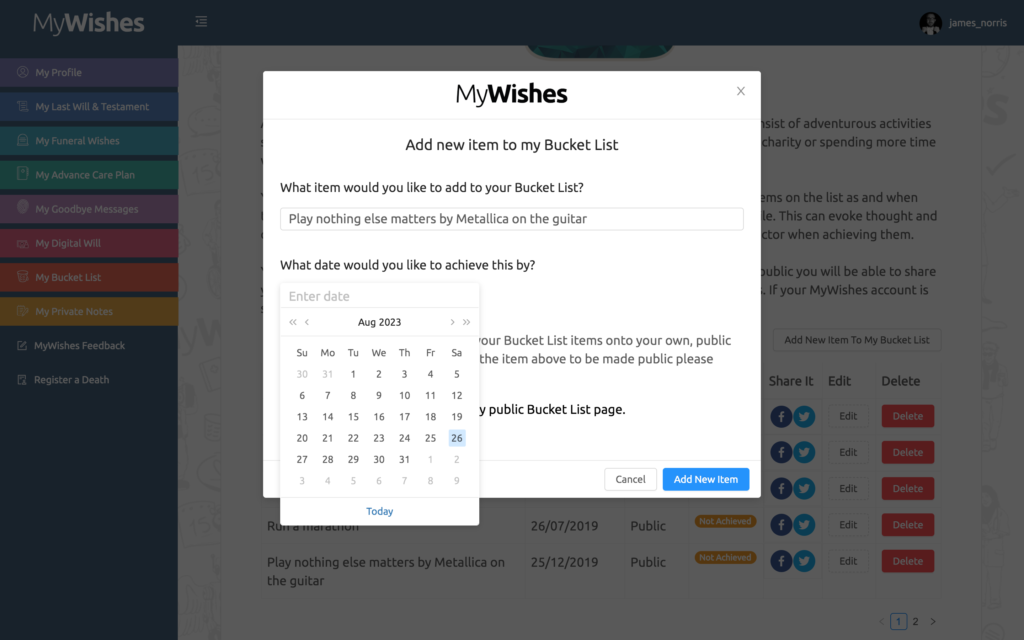
Making your bucket list public
By default MyWishes vanity URLs are set to ‘public’. This allows for non-sensitive information to be shared publicly when a user would like to do so. If your account is set to public and you would like to share your Bucket List item tick the box as shown below.
![]()
![]()
If you do not want the item on your Bucket List to be made public do not tick this box. If you would like to disable your vanity URL and in doing so disable the ability to share anything onto your public MyWishes page click here.

The image above is from of a ‘Public’ Bucket List
Publishing your goals and achievements
You can publish the goals that you have set on your bucket list across your social media channels. This may help give you the encouragement you need to achieve them. The social media sharing buttons can be found next to each of the items you add to your Bucket List.
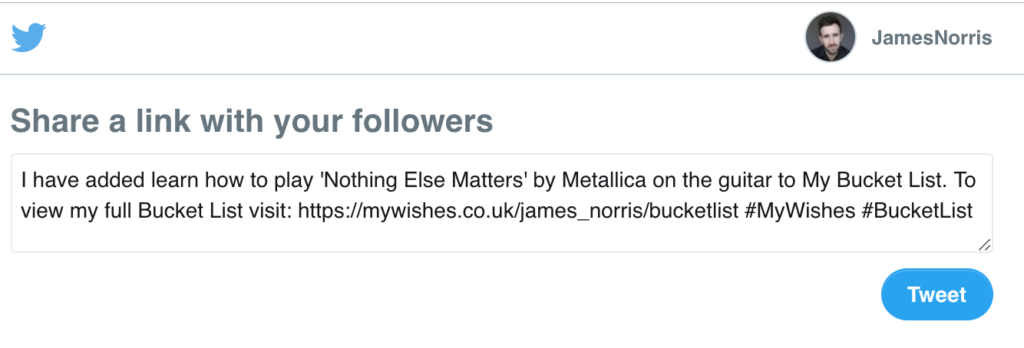
Your Bucket List
Once you have saved your Bucket List you can refer to it and update it as often as you like. If you do not achieve a Bucket List item within the timeframe you have set simply change the ‘due date’ to an achievable date in the future.
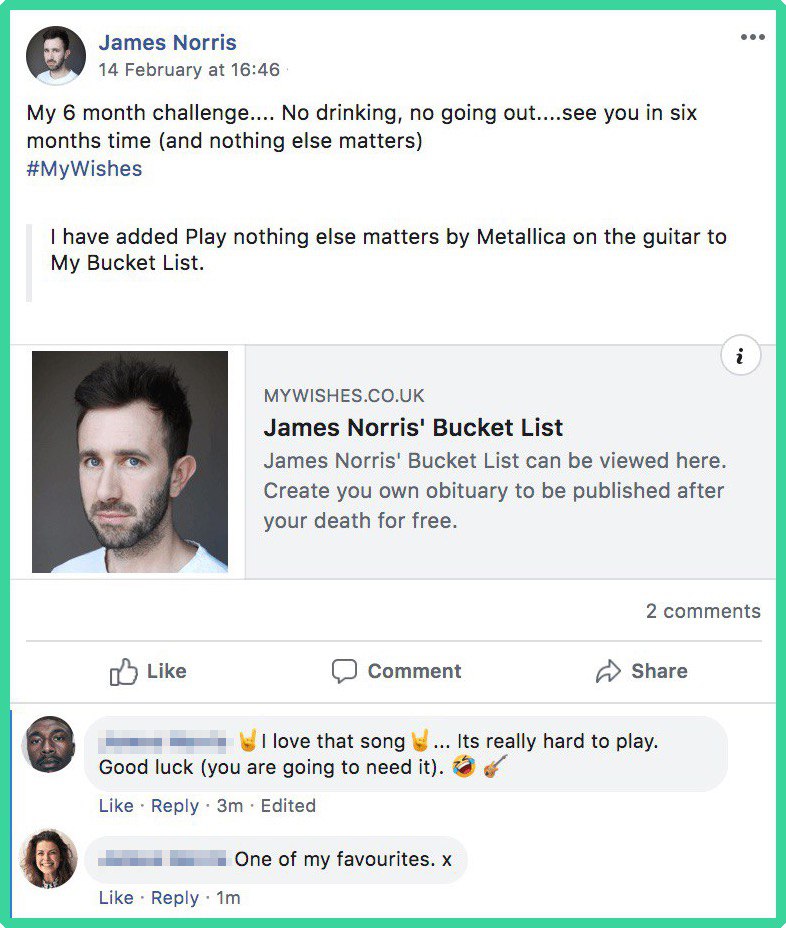
Further resources of inspiration
- ‘The Top 5 Regrets of the Dying’ book by Bronnie Ware (further information)
- The Bucket List film with Jack Nicholson & Morgan Freeman (IMDB Review)
- Stephen Sutton’s Bucket List – Possibly the most incredible and elaborate buck list of all time can be seen here (Stephen Sutton’s website)
Other tutorials that you might find of interest
- Communication Technologies & Being Bereaved Infographic
- New Book featuring MyWishes
- How to use AI to make plans for your Digital Legacy
- WARNING: Facebook will delete all historic, live-streamed videos on the 7th June
- Digital Legacy & Wellbeing
- Last Will & Testament – Frequently Asked Questions in the UK
- Last Will & Testament Glossary
- Organ Donation and leaving a legacy

MyWishes free to use software was developed under the guidance of healthcare, hospice, legal and funeral professionals. To learn more about how MyWishes works click here.
How to make your public MyWishes profile, private!
The documents created on MyWishes are private. Once completed they can be downloaded and shared with those you trust within your friendship group, with family members of professionals (for example your doctor, a solicitor or your appointed funeral director).
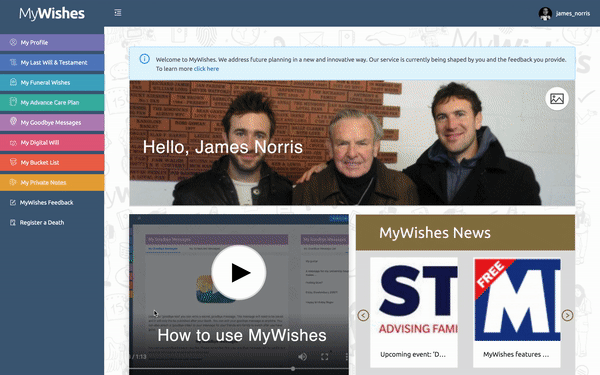
MyWishes have however also developed ways for out users to share non-sensitive information on their public MyWishes page. Non-sensitive content may include their bucket list, the songs that they would like to have played at their funeral, small gifts that they have allocated to their loved ones within their Last Will & Testament and Goodbye Messages that are only sent out onto their MyWishes profile after they die. The Goodbye Messaging feature is basically a Victorian Memory box for today’s digital age.
How to make your MyWishes public profile private or public
Every MyWishes user has their own vanity URL. This is created when a user registers however the name can be changed at any time in the MyProfile section.
![]()
Your MyWishes URL has to be set to public if you would like to share sensitive information information on it. This setting can be altered by clicking on the ‘Edit’ button and changed private or public.

When a MyWishes URL is set to private the user’s public page will not display allow them to share any non-sensitive information on their public profile.

The GIF above highlights how a public MyWishes profile appears when it is set to ‘Private’![]()
![]()
Other tutorials that you might find of interest
- Communication Technologies & Being Bereaved Infographic
- New Book featuring MyWishes
- How to use AI to make plans for your Digital Legacy
- WARNING: Facebook will delete all historic, live-streamed videos on the 7th June
- Digital Legacy & Wellbeing
- Last Will & Testament – Frequently Asked Questions in the UK
- Last Will & Testament Glossary
- Organ Donation and leaving a legacy

MyWishes free to use software was developed under the guidance of healthcare, hospice, legal and funeral professionals. To learn more about how MyWishes works click here.
How to keep your documents safe (and accessible)
Overview
It is extremely important that you keep you Last Will and Testament and your other end of life documents in a safe place. Whether you store your files electronically or virtually you should tell someone where they are stored in order for access to be obtained when required.
1. Download documents created on MyWishes and email them to those you trust
It is important that once you have documented your wishes that you download and share them. When you click on any MyWishes ‘Download’ button you will receive a PDF of the document that you have just saved.
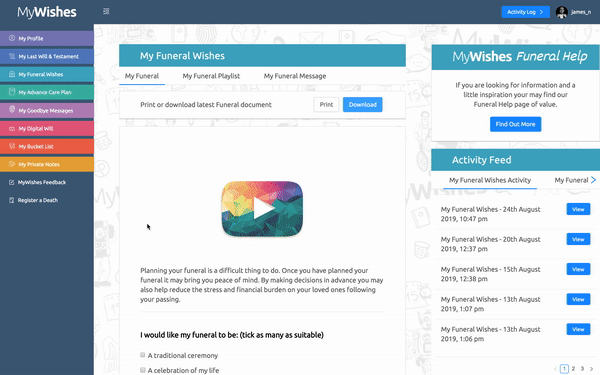
Once you have downloaded you might want to email the document to one or a number of people you trust. In the example above someone’s funeral wishes are downloaded. In this case the MyWishes user might decide to email a copy to their partner, a copy to their children and a copy to two different funeral directors in order to receive a quote. By understanding the costs budgeting can occur.
2. Print your documents
We strongly recommend that you print copies of your MyWishes documents.
In today’s ever digitised world you might be inclined to do everything online and after downloading your MyWishes documents locally on your computer simply emailing them to those you trust. By printing hard copies you could help ensure that they are immediately accessible in case of an emergency or should someone be unable to retrieve an electronic copy of your document.
 3. Keep your documents safe
3. Keep your documents safe
- In your home.
Dedicate a suitable box or draw to keep your important MyWishes documents safe. Tell someone you trust where your safe location is should they need to access the documents,
- With those you trust.
Provide a copy to your documents to those you trust. These may include a family member, your partner, your doctor, your solicitor, a funeral director or a close friend. If you decide to leave a copy of your documents with a solicitor there may be a cost for both you and those wanting to access the documents.
- Save copies digitally
Saving copies of your important documents, files and even your favourite photos and videos digitally can make life a lot easier on those you leave behind. To create a digital copy of your Last Will and Testament, Advance Care Plan, Funeral Wishes or Digital Will using MyWishes use the ‘download’ buttons are shown above. If you use a password to protect your computer you might want to tell someone the password. If you decide to encrypt your folder to make it even more secure once again, you may want to tell someone you trust how to access these documents.
- On an external hard drive or USB stick
External hard drives and USB sticks can be a great way to store and share large numbers of documents, photos, videos and files. If you have a large number of personal photos and videos or if you own digital songs and movies that you would like to pass transferring them to a hard drive or a USB stick might be a good idea.
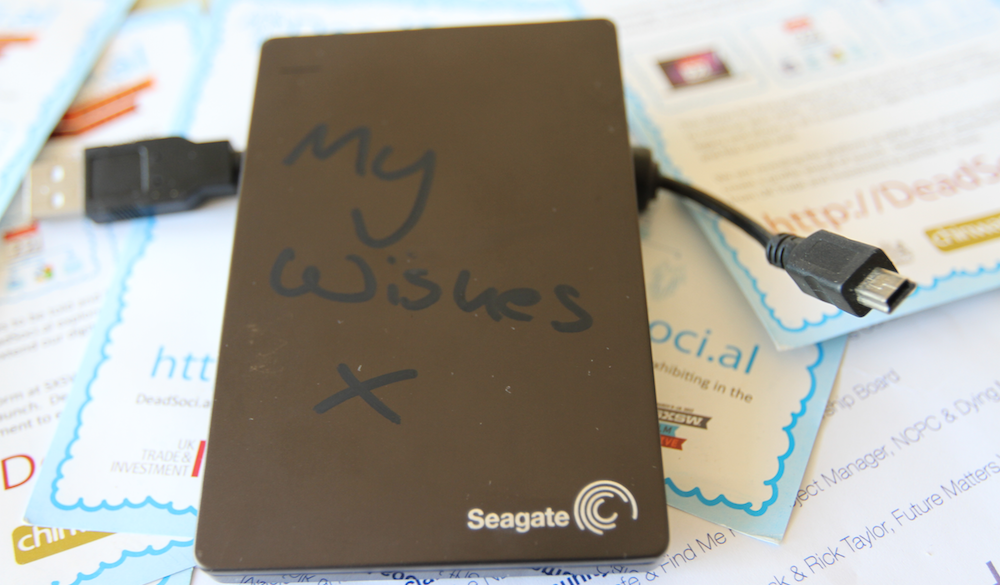
Once transfered simply tell the recipient of the Hard Drive what is stored on the device and what your wishes for the content is.
- The Cloud
There are an increasing number of ‘online vaults’ and cloud storage solutions that look after your documents, photos and videos. These include Dropbox, Google Drive, One Drive and Google photos. Such cloud services can be great however we recommend that they are are not the primary way in which your important photos and videos are stored due to the complexities of sharing access, obtaining access and sharing passwords.
If you would like some of your files not to be seen until after your death we recommend asking an accredited solicitor to carryout this task for you instead. The cost of a solicitor to carryout this task will probably be less than the monthly charges accumulated by services with a monthly subscription. It may be ironic for us to state this but “just because a process can be carried out online it doesn’t necessarily mean that it will be better, easier or cheaper.
4. Don’t forget about your photos and videos
As well as keeping your important documents safe also think about how you might want to keep the photos and videos you have uploaded to social media sites safe. A number of guides about this can be found on the Digital Legacy Association website.
5. Using a safe
If you own a safe you may want to keep a copy of your important documents, files, photos and videos within it. If you do use a safe it is paramount that at least one person you trust knows where it is and how to access it.
Other tutorials that you might find of interest
- Communication Technologies & Being Bereaved Infographic
- New Book featuring MyWishes
- How to use AI to make plans for your Digital Legacy
- WARNING: Facebook will delete all historic, live-streamed videos on the 7th June
- Digital Legacy & Wellbeing
- Last Will & Testament – Frequently Asked Questions in the UK
- Last Will & Testament Glossary
- Organ Donation and leaving a legacy

MyWishes free to use software was developed under the guidance of healthcare, hospice, legal and funeral professionals. To learn more about how MyWishes works click here.
How to arrange a funeral
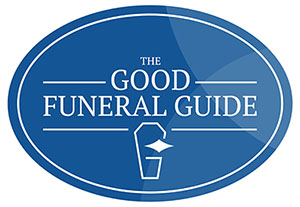
“It takes a few minutes to plan out a funeral. You’ll want to do what the person who has died wanted. And, together with those closest to the person who has died, you will also want to do what you feel you need to do”. – Charles Cowling, founder of The Good Funeral Guide
Overview
Most people don’t want their family and friends to put themselves out massively for their funeral. Listen to what they say then go ahead and give them the celebration you think they deserve. The law does not require you to use a funeral director, nor does it require you to hold a funeral service. Funeral wishes are not legally binding.
A survey of 2,000 people suggested that 54% wanted their funeral to be a “celebration of life”. Some 48% said they wanted it to incorporate their favourite “hobby, colour, football team or music”. (ICM)
Seven things to consider when planning a funeral
Here are the 7 most important things to hold in your mind when you plan a funeral for someone:
- There’s no rush (except for some religions)
- Set your budget and shop around. This can save you a lot of money
- Use the internet for info, ideas, goods and services
- Don’t pay others to do what you can do yourself
- Follow your heart. There are no rules, so do it your way
- A good funeral is more about what you say and what you do than what you spend
When all’s said and done you must be able to look back with pride
The content above was written by The Good Funeral Guide for use on MyWishes
The different types of funeral
A survey of 2,000 people suggested that 54% wanted their funeral to be a “celebration of life”. Some 48% said they wanted it to incorporate their favourite “hobby, colour, football team or music“.
There are a wide range of ways that a funeral can be arranged. It is not a legal requirement to use a funeral director and the choices ranging from the ceremony to body disposal are increasing each year. MyWishes free funeral planning tool empowers the general public to state what their funeral wishes and preferences are.
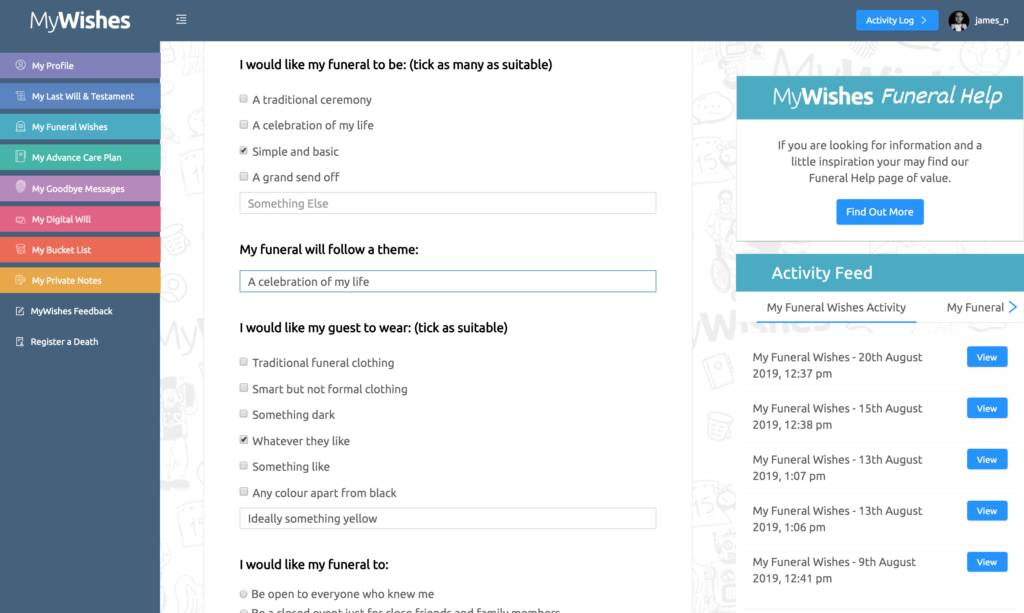
To use MyWishes free funeral planning feature click here. To learn more about our software click here
Why do we have funerals?
It may sound simplistic and and obvious however funerals are for the living. They can be an important way for the bereaved to deal with the death of a loved on and move on. They are to commemorate the deceased but it is important to once again, remember that they are not for the deceased they are for the living. The reasons why we have funerals include:
- To help us express grief
- To help us acknowledge someones death and the life they led
- To celebrate the a life now ended
- To say “goodbye”
Changing attitudes towards personal funerals and bespoke ceremonies
Funerals and remembrance ceremonies are becoming evermore personal and unique. Following in the footsteps of the bespoke wedding movement, bespoke funerals are becoming an increasingly popular alternative to a traditional or religious ceremony.
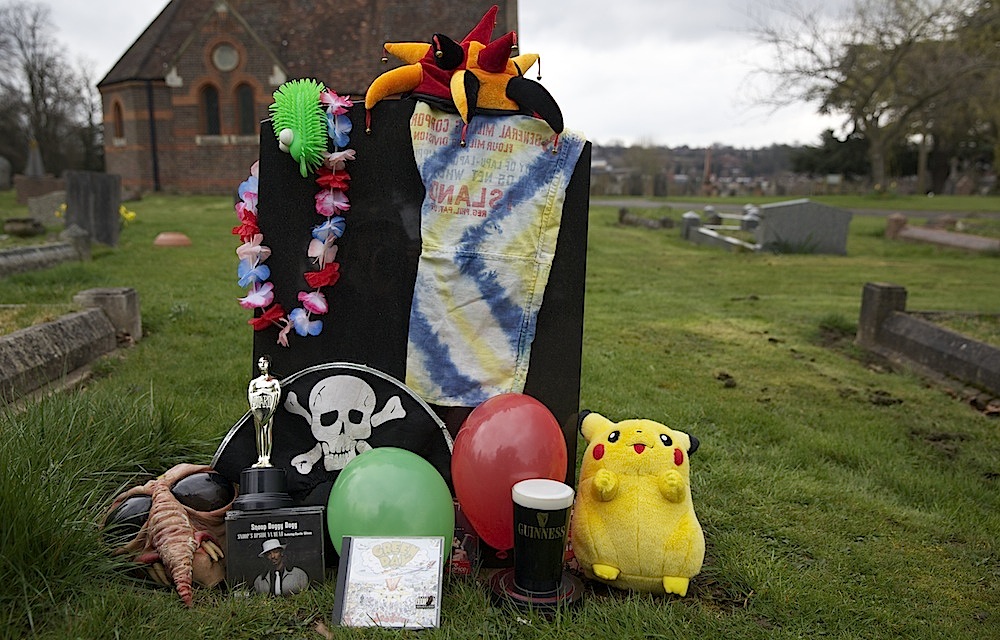
If directions have not been provided orally, in a funeral wishes document or in the deceased’s will the person arranging the funeral or the nearest relative will usually decide whether a cremation or burial will take place.
Changing attitudes and practices
There is not a right or wrong way for us to live our lives. In a similar way there isn’t a right or wrong way to address death. The only parameters are the laws of the land, social etiquette and each person’s imagination.
Paying for the funeral
Funeral costs are increasing above inflation in the UK, USA and most western countries. The person who is arranging the funeral is responsible for paying for it. Before making any arrangements it is important to see if the deceased had a funeral plan, health insurance or had stated any specific wishes for their funeral.
Funeral payment checklist
If you are arranging a funeral you may wish to investigate and see if the deceased has any documentation(s) shown below
- A prepaid funeral plan
- A pension scheme or insurance plan
- Belonged to a union or professional association that pays benefits on the death of a member (military etc)
- Had a national savings account from which a lump sum might be released (bank and building society accounts may be frozen until probate is granted, but some may agree to release funds to pay for a funeral)
Funerals can be expensive, so you should attain a quote from more than one funeral director (if you decide to use one). You may want to ask for a written quotation and check that everything, from the venue to the flowers, has been included. If a MyWishes ‘My Funeral Wishes’ document was sent to you, you may want to email it to a number of funeral directors requesting a quote.
Inviting people to a funeral
When arranging a funeral you may worry that not enough people will find out about it in time. You may want to invite people to the event though the following ways
- Over the phone
- Publishing an obituary in the local newspaper
- Announce the funeral time and date using Facebook and other social media channels
- Create a ‘Facebook event’ for the funeral that is due to take place and invite people to it Consider streaming the ceremony or wake. Learn more
- Send invitations by email
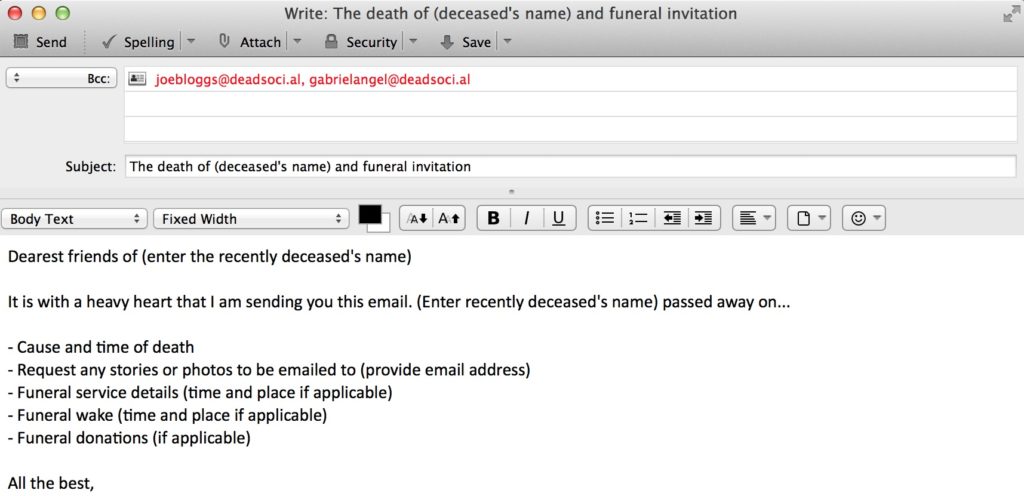
Document your own wishes and share them with someone you trust
Making plans for your own funeral is an altruistic and selfless act. You are undertaking a task for which you will never see or experience the outcome. You are however thinking about those who might take on the burden of arranging your funeral and making their tasks easier.

Other tutorials that you might find of interest
- Communication Technologies & Being Bereaved Infographic
- New Book featuring MyWishes
- How to use AI to make plans for your Digital Legacy
- WARNING: Facebook will delete all historic, live-streamed videos on the 7th June
- Digital Legacy & Wellbeing
- Last Will & Testament – Frequently Asked Questions in the UK
- Last Will & Testament Glossary
- Organ Donation and leaving a legacy
MyWishes free to use software was developed under the guidance of healthcare, hospice, legal and funeral professionals. To learn more about how MyWishes works click here.

Michael Sobell Hospice Palliative Care Department Mount Vernon Hospital, Gate 3 Northwood HA6 2RN United Kingdom (Map)
- Register and document your wishes for free here
- For all enquires click here
- To learn how MyWishes works click here
Sharing is caring…
How to plan for death (digitally)https://t.co/mlb8CEFtfk #DMAW2021 #InAGoodPlace
— MyWishes (@MyWishesApp) May 14, 2021
Why you need a Social Media Will (sometimes called a Digital Will)

“People should leave clear instructions about what should happen to their social media, computer games and other online accounts after their death, according to the law society “– The Law Society (UK)
“If you have social media profiles set up online, you should create a statement of how you would like your online identity to be handled. Just like a traditional will helps your survivors handle your physical belongings, a social media will spells out how you want your online identity to be handled”. – USA Government
Social Media Will (Guide)
Both the USA government and the UK Law Society agree that we should make plans for our ‘digital assets by writing a social media will. By doing so we can help make our passing easier on those left behind from both emotional and financial reasons.
McAfee released a survey that found global consumers in the USA placed an average value of more than $37,000 on their digital assets (the value was even higher in the U.S. at nearly $55,000). The Digital Legacy Association also found that the perceived value society places on their loved one’s digital legacy is increasing year on year.
Each online service (Facebook, Amazon, eBay etc) have their own ‘terms of service’ (TOS). The TOS for each platform differs due to the differing services they each provide. It is important for all of us to understand the TOS for each platform that we use and document what our wishes are for each platform.
MyWishes free Social Media Will software
We have developed a free Social Media Will tool as part of the suite of services offered on MyWishes. It is simple to use and helps our users document what they would like to happen to each of their online accounts.
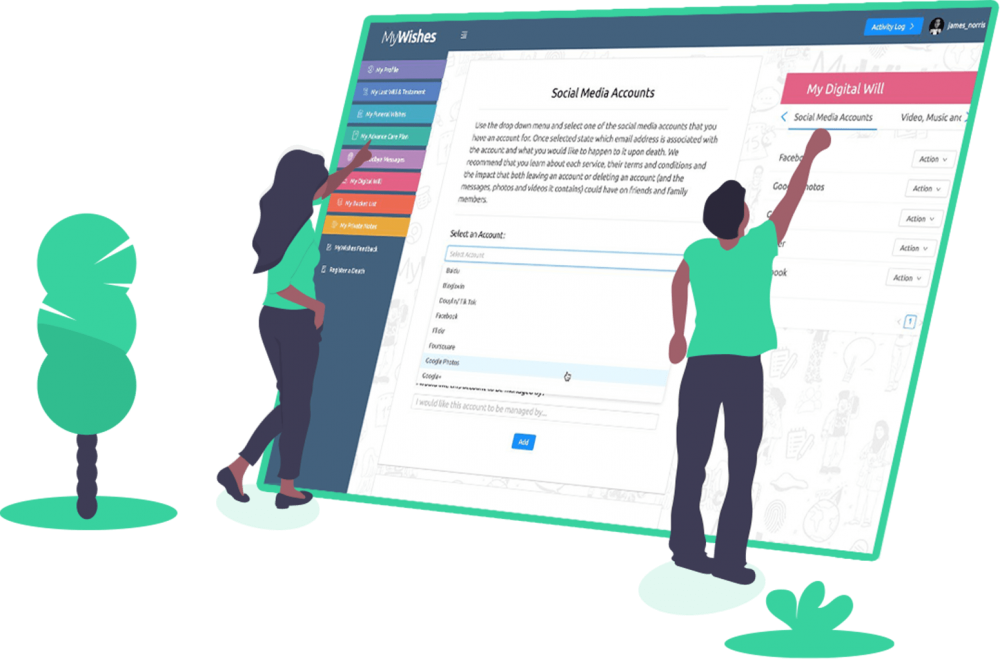
To use MyWishes Social Media Will generator register and we will help you to safeguard your social media account and all of your other online accounts.
How to write a Social Media Will
Below is a short video highlighting how to document what you would like to happen to your digital assets and your online accounts. MyWishes is free to use and further instructions will be provided should you create an account and document your preferences within the online accounts section.
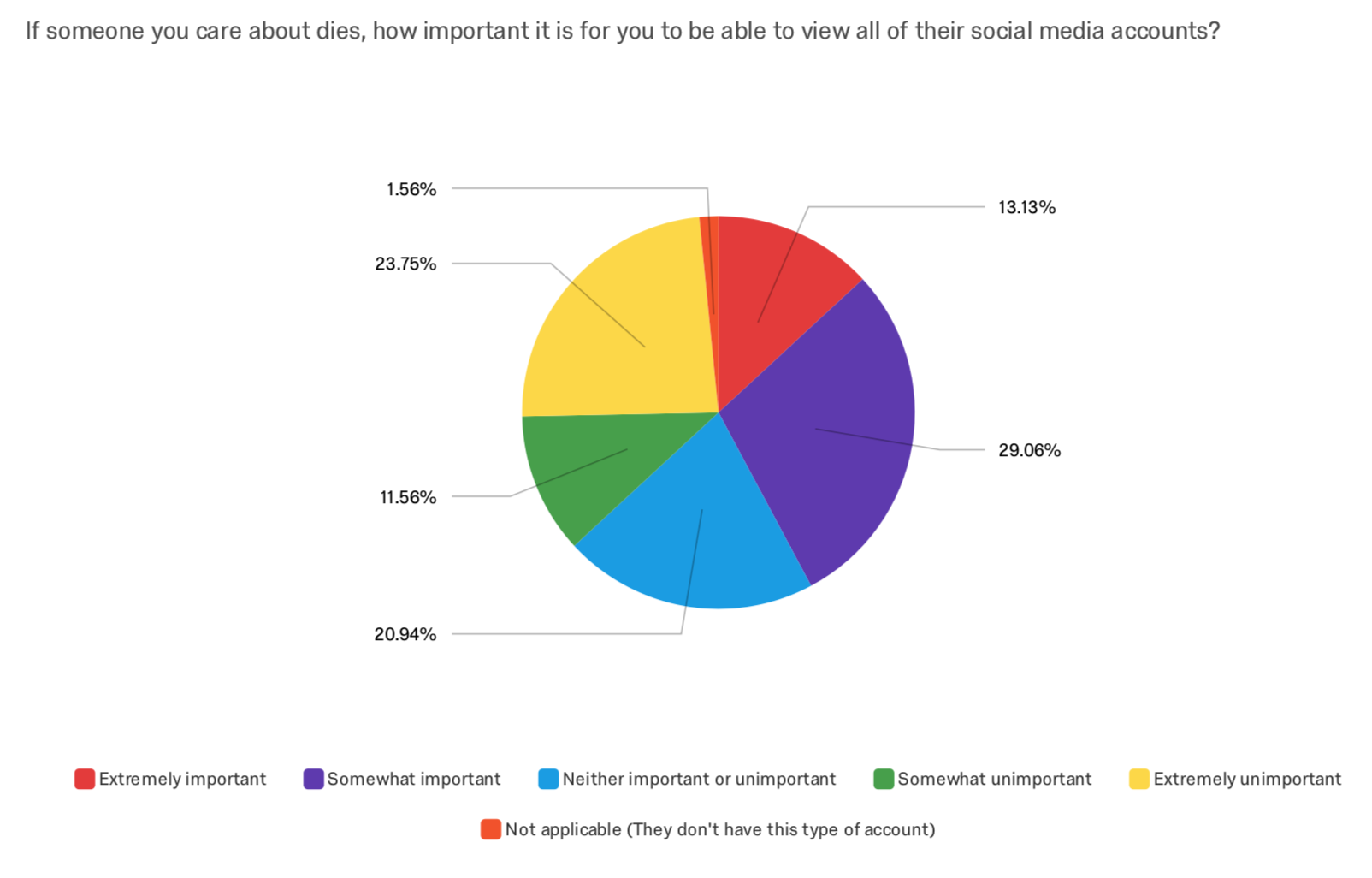
What happens if I do not leave a Social Media Will?
Most people have not made plans for their digital assets and their digital estate. If your wishes are not documented photos, videos and other items of sentimental value might be lost. If you have online only bank accounts, cryptocurrency, business assets, purchased media, a website and other items of a monitory value these may deleted or withheld. This in turn could mean that those you care about are unable to access or receive the assets you would have otherwise wanted them to receive.
Other tutorials that you might find of interest
- Communication Technologies & Being Bereaved Infographic
- New Book featuring MyWishes
- How to use AI to make plans for your Digital Legacy
- WARNING: Facebook will delete all historic, live-streamed videos on the 7th June
- Digital Legacy & Wellbeing
- Last Will & Testament – Frequently Asked Questions in the UK
- Last Will & Testament Glossary
- Organ Donation and leaving a legacy

MyWishes free to use software was developed under the guidance of healthcare, hospice, legal and funeral professionals. To learn more about how MyWishes works click here.
Why you should have an Advance Care Plan
 What is an Advance Care Plan
What is an Advance Care Plan
Advance care plans are a set of directions and preferences concerning someone’s future care. They are often documented whilst someone is healthy and only take effect if they lose capacity of their body or mind.
Why you need an an Advance Care Plan
An ‘Advance Care Plan’ can help ensure that you are not given treatment that you do not wish to receive. It can also ensure that you receive the type of care you would like to receive in your preferred setting. An Advance Care Plan can also empower a friend or family member to make decisions and act on your behalf if you wish them to.
You can state your wishes in a paper Advance Care Plan. These can be obtained from your doctor, hospital and hospice. Alternatively you can use our free Advance Care Plan tool to document you wishes. Once completed simply download the document (as a PDF), print it or email it to someone you trust.
Key principles of Advance Care Planning Process
The process of creating an Advance Care Plan is voluntary. No pressure should be brought to bear by the professional, the family or any organisation on the individual concerned to take part in writing an Advance Care Plan (ACP)
- An ACP must be a patient centred dialogue over a period of time
- The process of ACP is a reflection of society’s desire to respect personal autonomy. The content of any discussion should be determined by the individual concerned. The individual may not wish to confront future issues; this should be respected
- All health and social care staff should be open to any discussion which may be instigated by an individual and know how to respond to their questions
- Health and social care staff should instigate ACP only if in the context of a professional judgement that leads them to believe it is likely to benefit the care of the individual. The discussion should be introduced sensitively
- Staff will require the appropriate training to enable them to communicate effectively and to understand the legal and ethical issues involved
- Staff need to be aware when they have reached the limits of their knowledge and competence and know when and from whom to seek advice
- Discussion should focus on the views of the individual, although they may wish to invite their carer or another close family member or friend to participate.
- Some families may have discussed their issues and would welcome an approach to share this discussion
- Confidentiality should be respected in line with current good practice and professional guidance
- Health and social care staff should be aware of and give a realistic account of the support, services and choices available in the particular circumstances. This should entail referral to an appropriate colleague or agency when necessary
- The professional must have adequate knowledge of the benefits, harms and risks associated with treatment to enable the individual to make an informed decision
- Choice in terms of place of care will influence treatment options, as certain treatments may not be available at home or in a care home, e.g. chemotherapy or intravenous therapy. Individuals may need to be admitted to hospital for symptom management, or may need to be admitted to a hospice or hospital, because support is not available at home
- ACP requires that the individual has the capacity to understand, discuss options available and agree to what is then planned. Agreement should be documented
- Should an individual wish to make a decision to refuse treatment (advance decision) they should be guided by a professional with appropriate knowledge and this should be documented according to the requirements of the MCA 2005.
(The Key Principles copy was provided by Dying Matters)
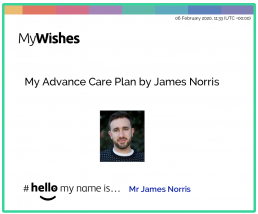
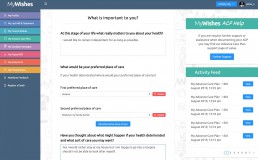
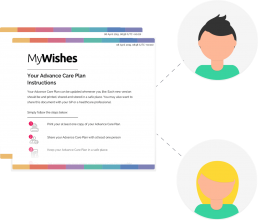
How to document your future care wishes on MyWishes.
Once you have created a MyWishes account our step by step video will visualise and describe how to create, download and share your advance care plan. Our support team will also be on hand to help support you should you experience any technical issues.
The animation below quickly highlights how our users create, download and share their Advance Care Plans.

Once you have completed your advance care plan you may also want to make plans for your online accounts in a social media wil or set yourself achievable goals within a bucket list. To learn more about all of MyWishes features click here.
Other tutorials that you might find of interest
- Communication Technologies & Being Bereaved Infographic
- New Book featuring MyWishes
- How to use AI to make plans for your Digital Legacy
- WARNING: Facebook will delete all historic, live-streamed videos on the 7th June
- Digital Legacy & Wellbeing
- Last Will & Testament – Frequently Asked Questions in the UK
- Last Will & Testament Glossary
- Organ Donation and leaving a legacy

MyWishes free to use software was developed under the guidance of healthcare, hospice, legal and funeral professionals. To learn more about how MyWishes works click here.
Why you should have a Last Will & Testament

“A Will should cover all of your assets be they valuable or not so valuable. And remember it is often the possessions that have little or no monetary value can cause conflict when a loved one dies. It is therefore paramount that all our assets are taken into consideration writing a will.”
– Gary F. Rycroft. Member of the The Law Society Wills & Equity Committee and Chair of Dying Matters.
Why have a Will?
Making a Will is a way of showing that you really care about whoever is left behind and that you have done your best to leave your property and finances in the most thoughtful way possible. Whether or not you leave a Will is going to have a significant impact on how you are remembered – were you someone who took time and care to ensure your loved ones were provided for after your death, or were someone who just left everything to chance and hoped it would all be alright?
Have you written a will
The Digital Death Report 2017 found that nearly two thirds of adults may not have a valid Will. That’s two thirds of adults who have decided (or are unaware) that they currently have no say whatsoever in what happens to their hard earned cash and assets after they die.
 What happens if you die and have not written a Will?
What happens if you die and have not written a Will?
If you die without a valid Will, the law dictates what happens to your assets. These are called the “Intestacy Rules”. If you are lucky the Intestacy Rules will coincide with what you would like to happen anyway. But for many that will not be the case.
Common sense dictates that 18 may not be a good age for a young person to become entitled to a lump-sum of cash. If you make a Will you can specify the age that your children would inherit (say 25 with provision for some money to be advance before that for education and maintenance) and you can appoint guardians to look after your children. There are also plenty of situations where the Intestacy Rules just don’t work at all. Cohabiting or unmarried couples are not recognised and neither are step-children. Or what if you have a disabled or vulnerable relative you want to provide for?
By making a Will you help forge a structure to protect your loved ones and help cement a legacy that is legally binding.
So when should I make a Will?
In theory everyone over the age of 18 should write a will. However there are many life events which act like a trigger when thinking about and making a Will. These include:
- Buying a house
- Having children
- Have children
- Getting married
- Getting unmarried
- Inheriting assets
- Retiring
- A change in circumstances for an intended beneficiary (eg divorce of bankruptcy)
Areas often overlooked
- Your Will should remain under review. Revisit it at least every five years or each time a change in circumstance (as shown above) occurs.
- Making a Will can help with Inheritance Tax Planning in relation to business succession.
- A Will can enable you to make Charitable Gifts (which can also help reduce the amount of tax paid by your beneficiaries) and set out arrangements for your pets and funeral wishes.
Writing a Will using MyWishes
MyWishes Last Will & Testament software is free. Our users enter their details, print and sign their document.
Simply register and enter your details into the interactive document generator. Once completed, download the document (as a PDF) and sign it in front of two witnesses to make it legally binding. If you have a ‘complex will’ share the document with any qualified solicitor and ask for a quotation to review and update the document. This can be carried out in person or by sending emails.

By providing a complex Last Will & Testament document to a solicitor, the costs incurred will be greatly reduced. MyWishes recommends using a solicitor for complex documents and recommends against using online will writing services that use ‘legal experts / will writing experts’. A ‘legal expert’ doesn’t need to have any qualifications and could be an untrained intern! Furthermore no insurance is provided by will writing companies who use ‘legal experts / will writing experts’… This means that you are liable for any mistakes or inaccuracies contained within the document.
Other tutorials that you might find of interest
- Communication Technologies & Being Bereaved Infographic
- New Book featuring MyWishes
- How to use AI to make plans for your Digital Legacy
- WARNING: Facebook will delete all historic, live-streamed videos on the 7th June
- Digital Legacy & Wellbeing
- Last Will & Testament – Frequently Asked Questions in the UK
- Last Will & Testament Glossary
- Organ Donation and leaving a legacy

MyWishes free to use software was developed under the guidance of healthcare, hospice, legal and funeral professionals. To learn more about how MyWishes works click here.
How to register with MyWishes
In order to use MyWishes you will need to create an account and validate your email address. Creating an account will allow you to revisit and update your the documents you have created at any stage.
Registering with MyWishes
If you have not created a MyWishes account you can register and use the service for free by visiting https://app.mywishes.co.uk/register
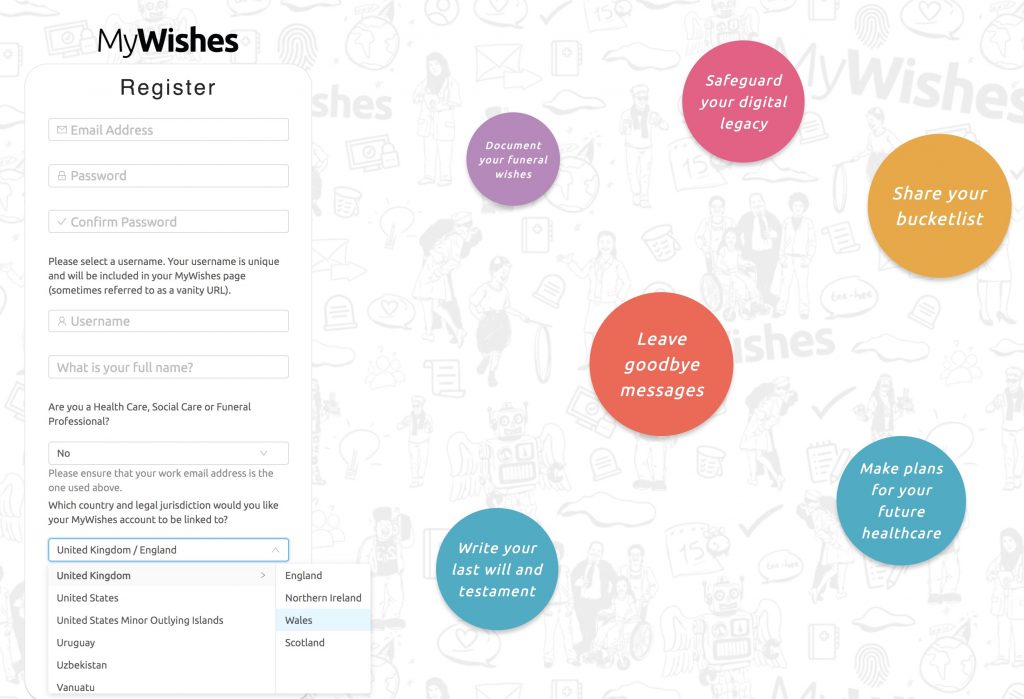
It is important that you enter the country where you live. This will allow us to provide correct and relevant information to you whilst logged into MyWishes. Once you have entered the information asked you will need to click on the button shown below:

You will now receive an email from us to the email address provided. The email received will appear in your email inbox in a similar way to the email shown below. You will need to click on the ‘Login to MyWishes and get started’ button to validate your email account an start using MyWishes.
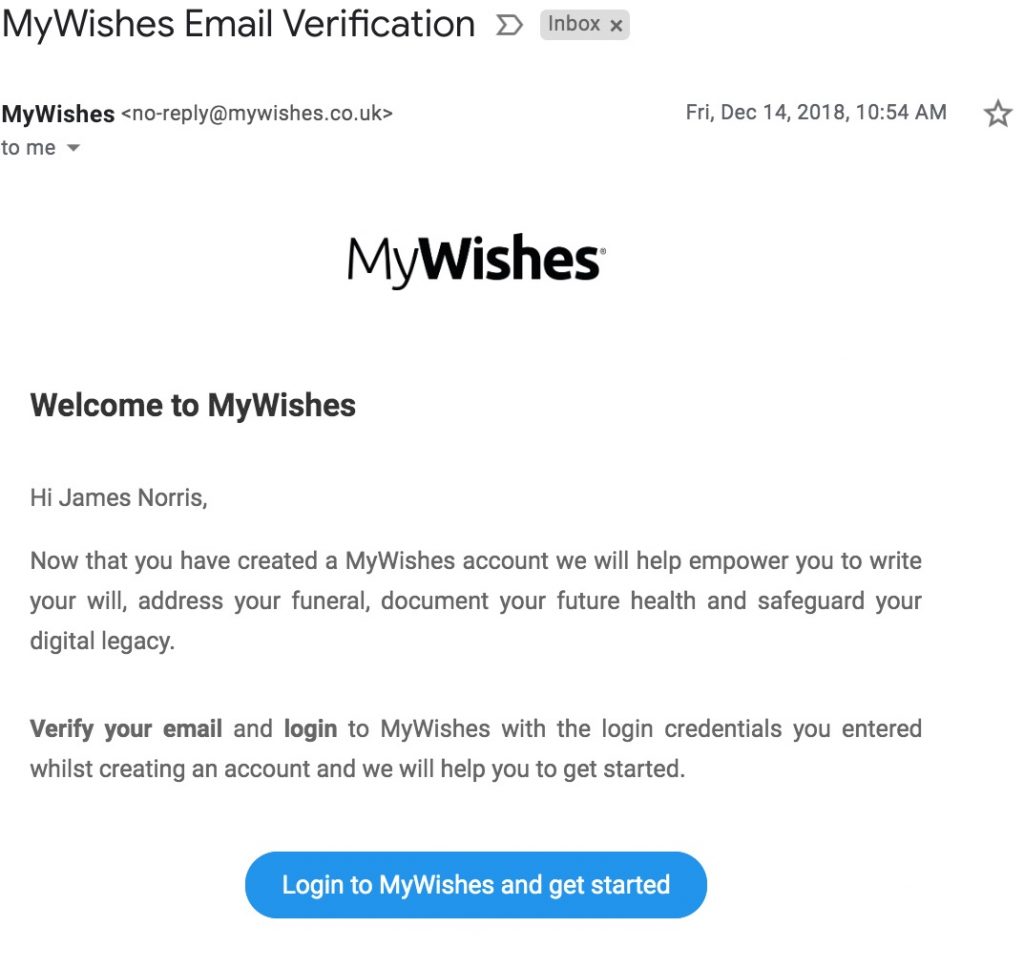
Once you click on the button your account will be validated and you will be redirected to the MyWishes login page. Now enter your email address and the password to start using MyWishes.
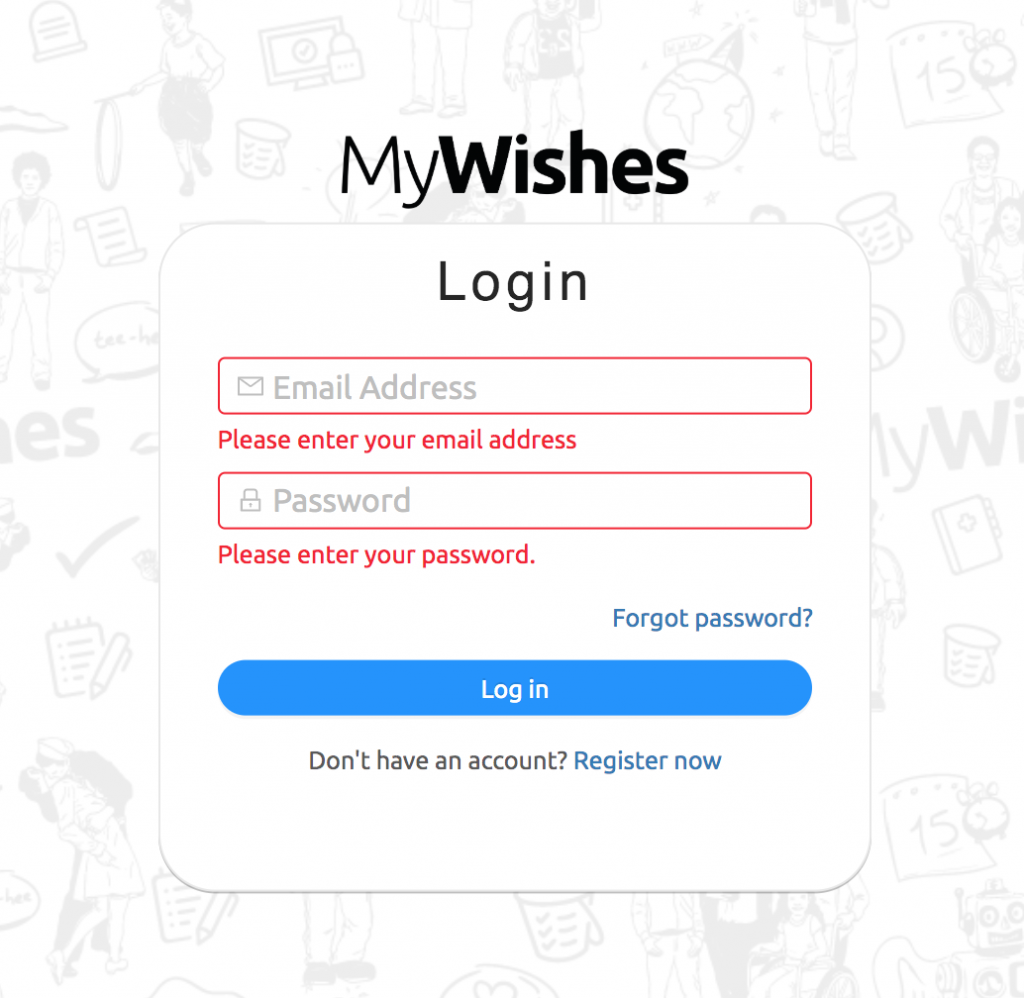
Creating your MyWishes profile
Once you account has been setup you can customise your settings and decide how your profile will appear. To watch a video tutorial click here
Other tutorials that you might find of interest
- Communication Technologies & Being Bereaved Infographic
- New Book featuring MyWishes
- How to use AI to make plans for your Digital Legacy
- WARNING: Facebook will delete all historic, live-streamed videos on the 7th June
- Digital Legacy & Wellbeing
- Last Will & Testament – Frequently Asked Questions in the UK
- Last Will & Testament Glossary
- Organ Donation and leaving a legacy

MyWishes free to use software was developed under the guidance of healthcare, hospice, legal and funeral professionals. To learn more about how MyWishes works click here.
How to make your Last Will & Testament legally binding in the UK
To make your Last Will & Testament legally binding in England, Northern Ireland, Scotland or Wales you will need to have the document signed by yourself and witnessed by two people over the age of 18. The witnesses cannot be beneficiaries of the will, spouses of beneficiaries or members of your family.
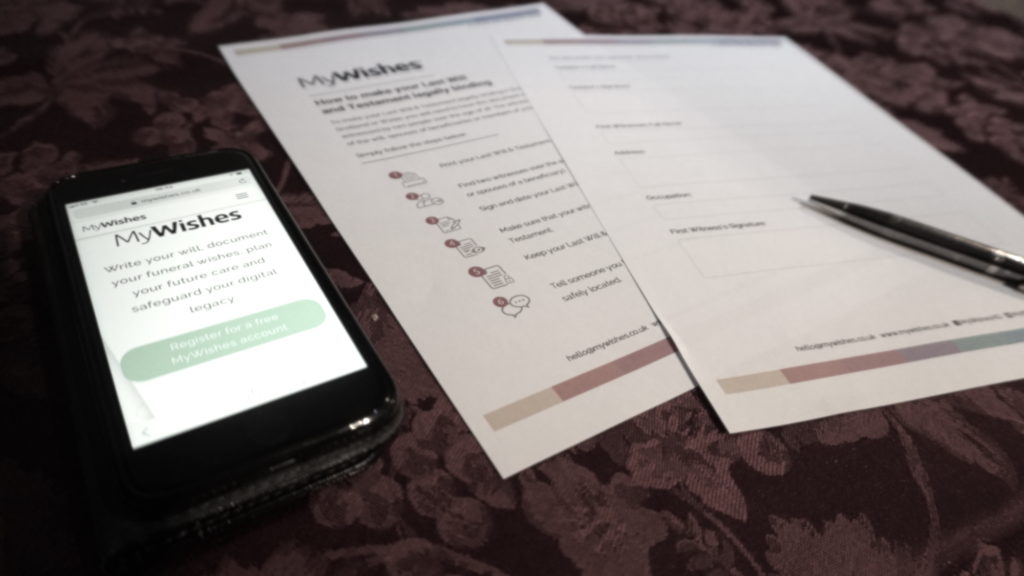
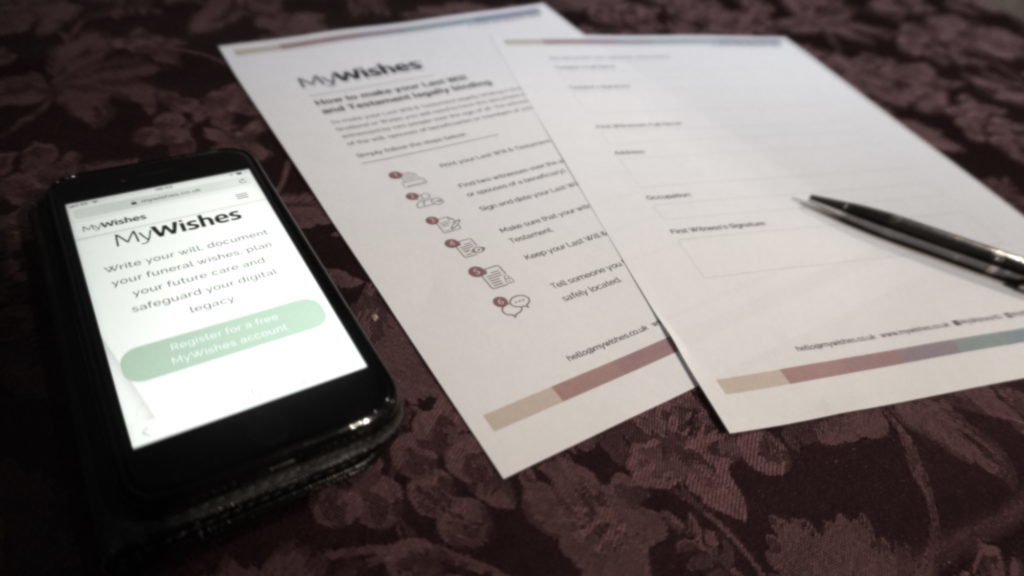
You will need to ensure that the witnesses have sufficient eyesight to witness the signing of the document. Please also ensure that they have the mental capacity to understand the importance of task requested. If there are any doubts surrounding the person’s eyesight or mental capacity please consider assigning a different witness or obtaining legal advice.
If you have close relatives who you do not want to give anything to your should state why you have made no provisions for them. We recommend that you provide these written reasons on a separate document. A Last Will & Testament can become a public document when it goes to probate. By adding a separate document you may be able to reduce the stress caused from the publication of such content.
To draft your Last Will & Testament for free click here
Other tutorials that you might find of interest
- Communication Technologies & Being Bereaved Infographic
- New Book featuring MyWishes
- How to use AI to make plans for your Digital Legacy
- WARNING: Facebook will delete all historic, live-streamed videos on the 7th June
- Digital Legacy & Wellbeing
- Last Will & Testament – Frequently Asked Questions in the UK
- Last Will & Testament Glossary
- Organ Donation and leaving a legacy

MyWishes free to use software was developed under the guidance of healthcare, hospice, legal and funeral professionals. To learn more about how MyWishes works click here.
What is a celebrant?
What is a Celebrant?
We recently spoke about end of life planning and MyWishes at the annual Celebrants Convention. Whilst there we caught up with Wendy Coulton a fully qualified Civil Funeral Celebrant.
In the video below Wendy Coulton explains what a celebrant is and how a celebrant helps support the recently bereaved when arranging a funeral service.
Other tutorials that you might find of interest
- Communication Technologies & Being Bereaved Infographic
- New Book featuring MyWishes
- How to use AI to make plans for your Digital Legacy
- WARNING: Facebook will delete all historic, live-streamed videos on the 7th June
- Digital Legacy & Wellbeing
- Last Will & Testament – Frequently Asked Questions in the UK
- Last Will & Testament Glossary
- Organ Donation and leaving a legacy

MyWishes free to use software was developed under the guidance of healthcare, hospice, legal and funeral professionals. To learn more about how MyWishes works click here.
How to create an ethical will
What is an ethical will?
“Unlike a ‘last will and testament’ disposing of one’s estate or an advanced directive for health care decisions, an ethical will is not legally binding. Rather, a good ethical will transmits values, life lessons, family history, and other experiences to those left behind when the author dies. One pictures a written version of those few choice words of wisdom spoken by a family elder on his/her deathbed. While the legal will deals with material goods, the ethical will is meant to pass on the non-material goods and family traditions of equal or greater importance”.
– Ethical Wills by Barry K Baines, 2002
Ethical Will’s can be passed down in many different ways and formats. The ethical will tutorials below are articulated through video as it was Lawrence Darani’s chosen medium. This is because of the poignant nature of seeing someone on film and being able to communicate directly to the viewer.
Lawrence Darani (1951-2014)
The MyWishes team were introduced to ‘ethical wills’ by Lawrence Darani. Lawrence became both someone we supported and a mentor. Before Lawrence died he created a number of ethical will tutorials for those interested in him and his thinking. He hoped that these would serve as guidelines for MyWishes users interested in creating their own ethical will.
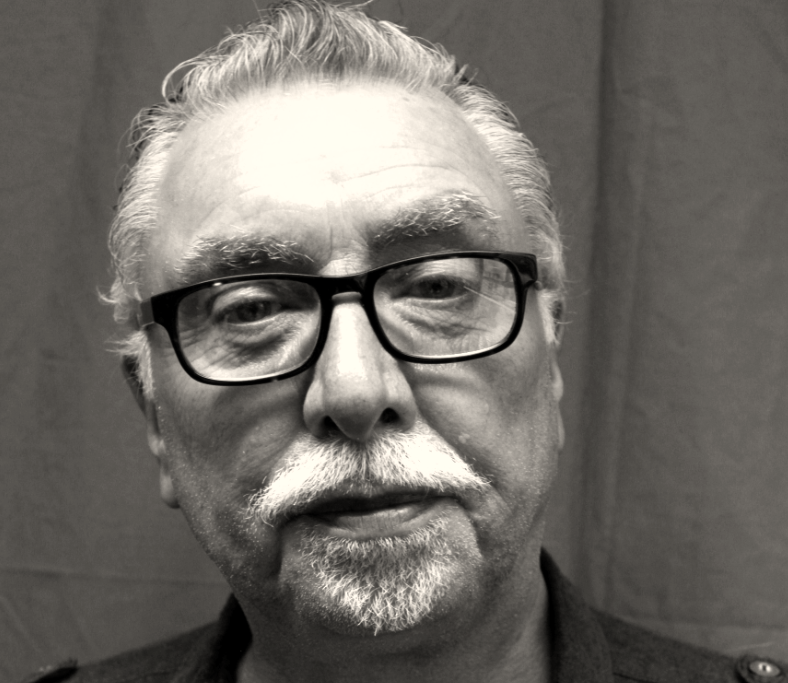
Creating your Ethical Will(s)
An ethical will can be passed down in many forms. The videos below each have a specific purpose and subject matter to address. Lawrence was inspired by Irvin D. Yalom’s book ‘Staring At The Sun: Being at peace with your own mortality: Overcoming the Terror of Death’. We are honoured that both Lawrence and his family have allowed us to show them. In doing so, Lawrence is still educating and teaching despite no longer being with us. His legacy as a existentialist, teacher and forward thinker truly does, ‘live on’.
There are no rules regarding what message or messages you should leave after your death. It should however be true to the person you are today and take into consideration to feelings of those who will watch it.
Creating your first video
The video below provides a great overview about the person Lawrence was and the values he lived his life by. We hope that you find this as inspiring as we do.
The formative events of my life
The formative events of my life is a video that highlights events in Lawrence’s life that had a profound influence on him.

Other tutorials that might be of interest

